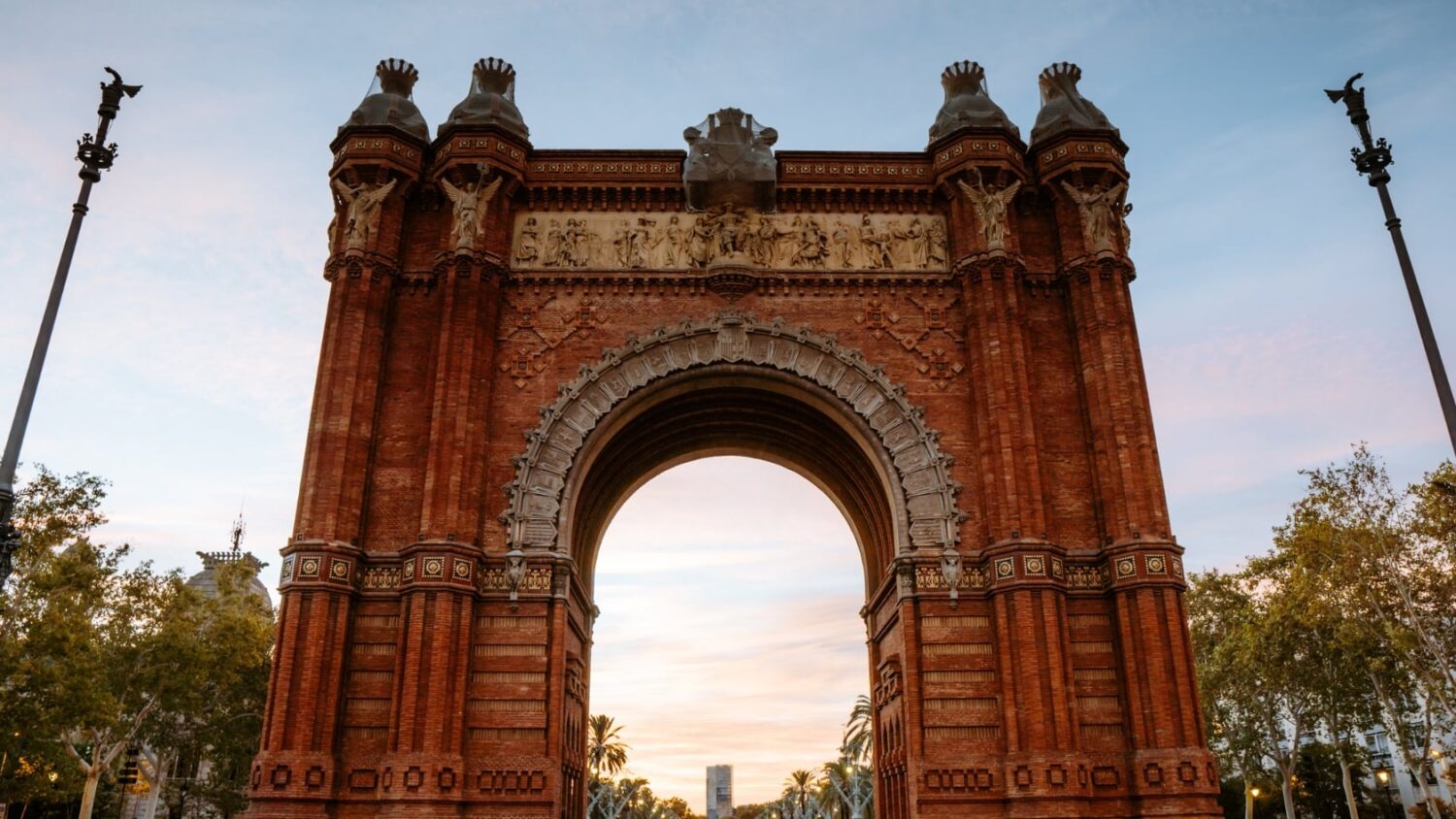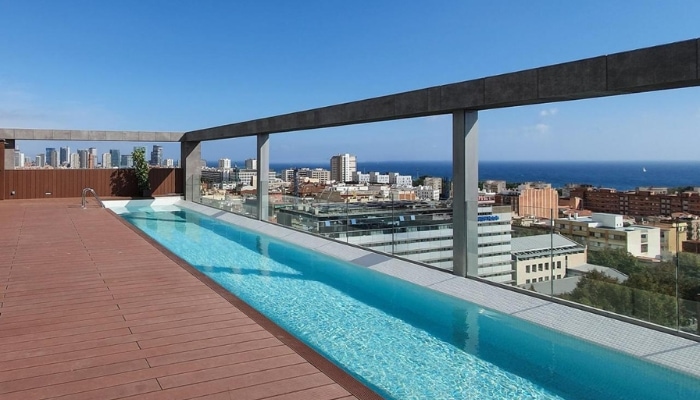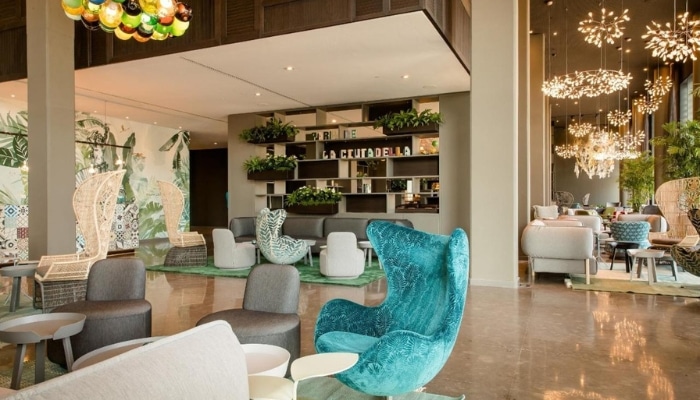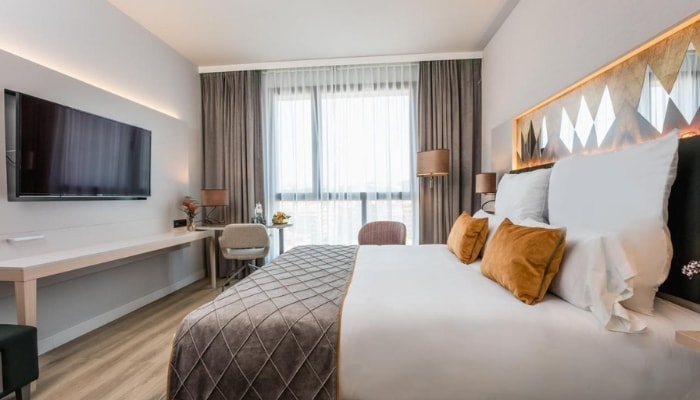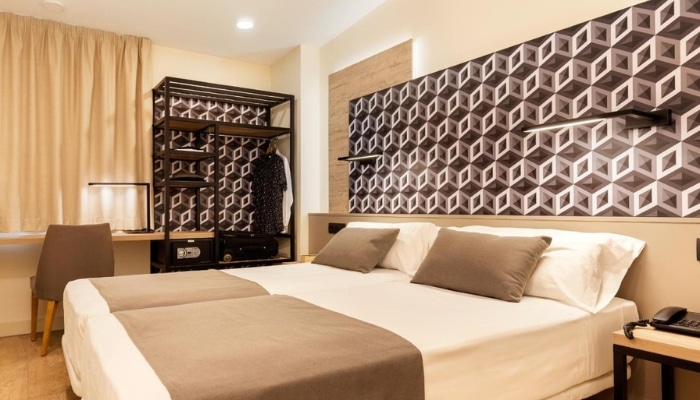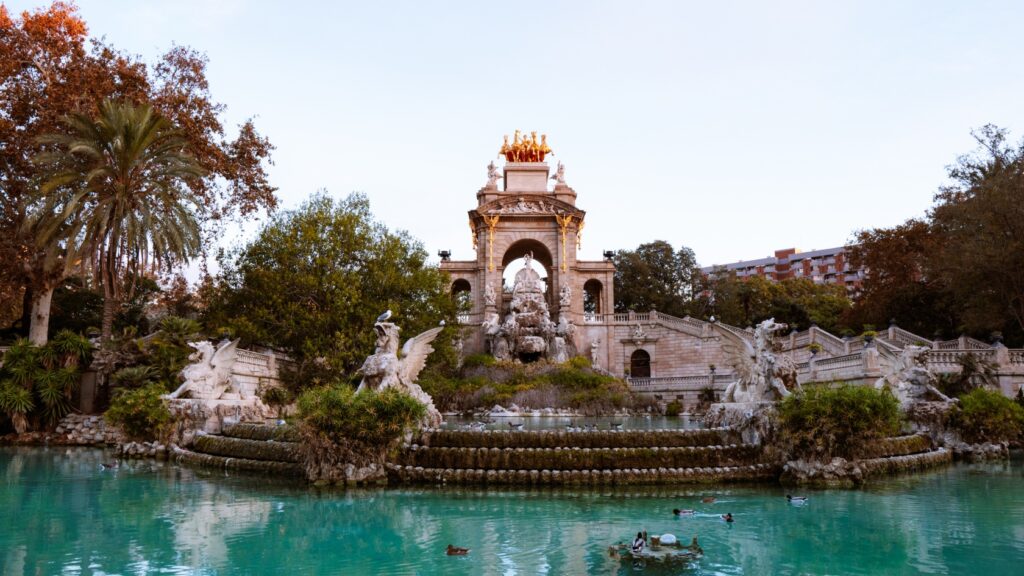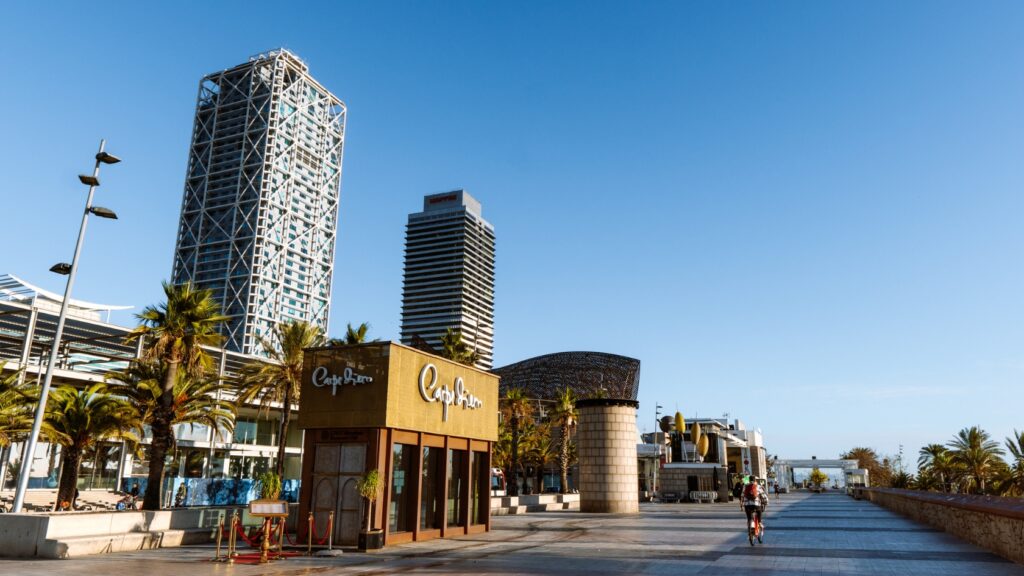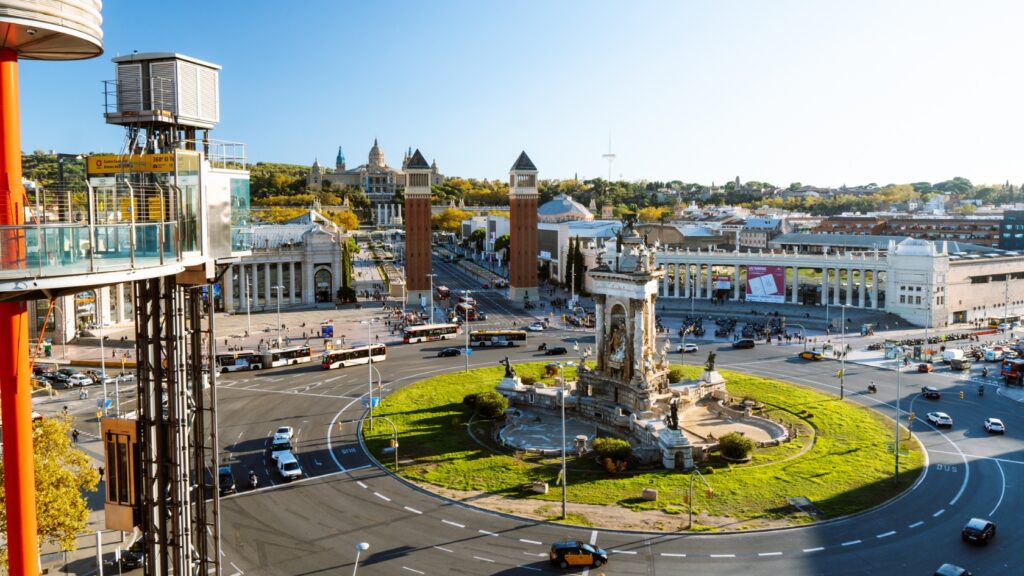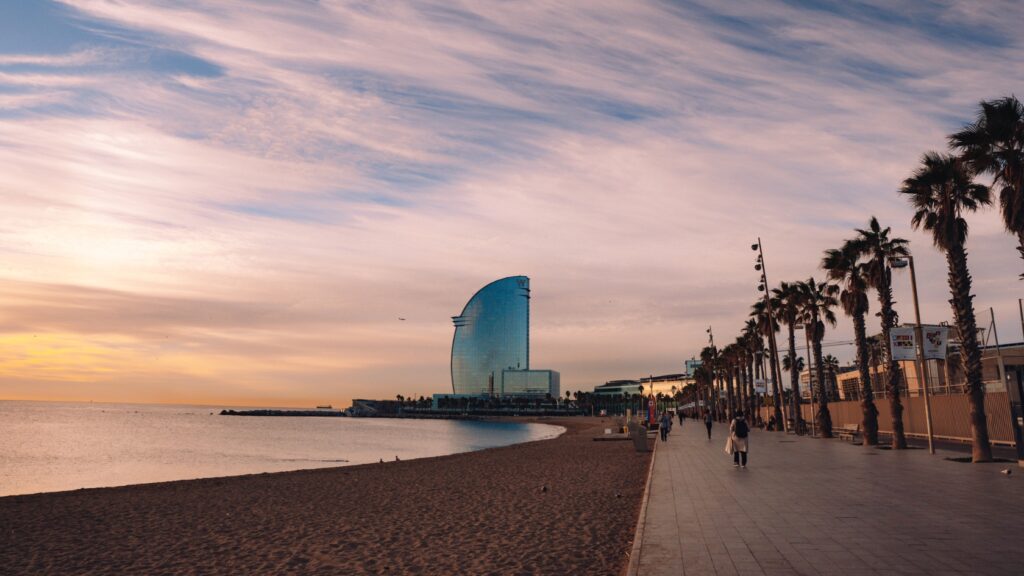Planning to visit Barcelona for 3 days? Follow our itinerary with tips on the best things to do in Barcelona for 3 days.
- Barcelona
- Can you visit Barcelona in 3 days?
- 3 days in Barcelona – map
- BEST THINGS TO DO IN BARCELONA IN 3 DAYS
- 3 DAYS IN BARCELONA: Sagrada Familia and La Barceloneta
- BARCELONA IN 3 DAYS: Passeig de Gracia and the Gothic Quarter
- BARCELONA IN 3 DAYS: Park Güell and Montjüic
- Hotels in Barcelona
- How to save in Barcelona on entrance fees to the sights?
- How to enjoy Barcelona for 3 days
- More information about Barcelona
Barcelona
Barcelona is the capital of Catalonia and the second largest city in Spain after Madrid. It’s also easier to get to than Madrid for many tourists, as it’s close to the French border. It is a beautiful cosmopolitan city that is one of the most visited cities in Europe.
Its greatest development was the hosting of the 1992 Olympic Games, from which Barcelona began to experience more and more tourism. This is currently so excessive that the number of visitors has to be limited in some places and it is important to book tickets in advance.
Barcelona’s history dates back to the 3rd century BC. Thanks to its long history, Barcelona is diverse. You will see Roman remains from antiquity and modernist buildings from 19th and 20th century.
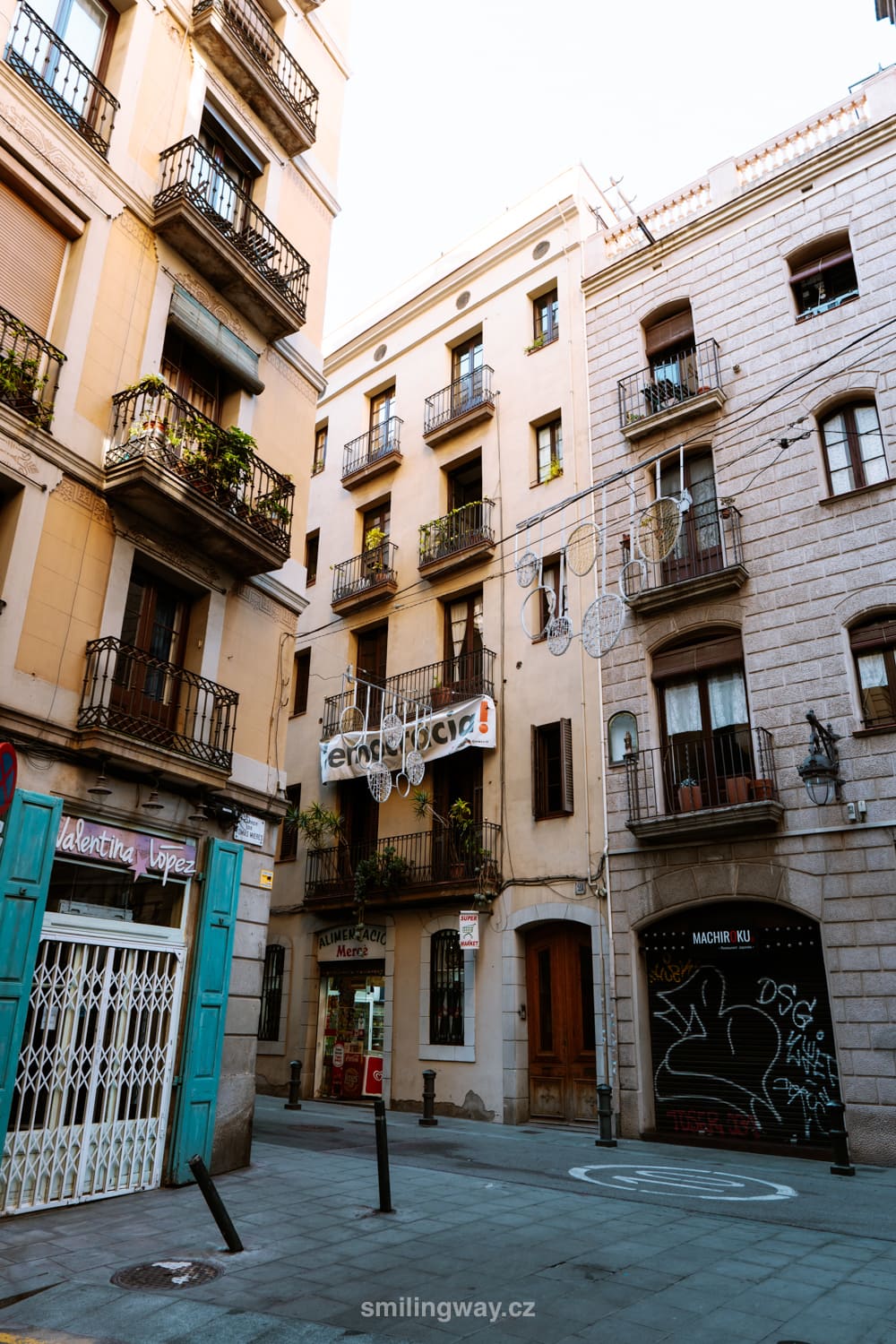
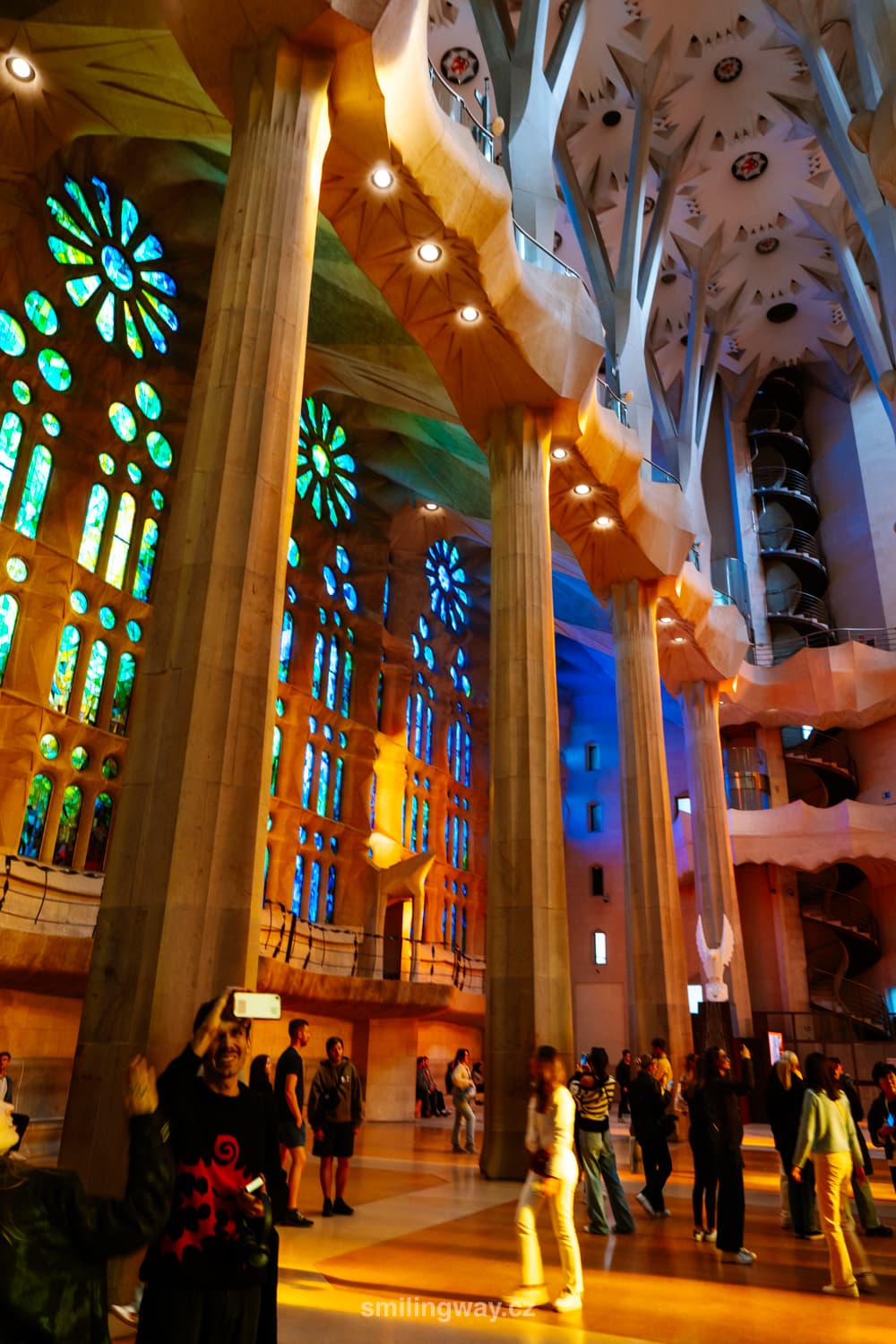
Can you visit Barcelona in 3 days?
Barcelona is a sprawling and cosmopolitan city that takes at least 3 full days to explore. I would recommend spending a week here if you want to take a trip to the area or spend some time on the beach. If you have more time, here is an itinerary for 4 days in Barcelona.
But 3 days will be enough to visit the most beautiful places in Barcelona. You’ll see what millions of visitors flock here for every year – the Sagrada Familia, Park Güell, Casa Batlló, Barcelona Cathedral and the Gothic Quarter, and the seafront promenade. You’ll enjoy beautiful views, taste Gaudí’s work and sample delicious tapas.
The detailed itinerary will guide you through the best things to do in Barcelona in 3 days.
Quick Guide to Barcelona
Where booking is required or recommended: Sagrada Familia (booking required), park Güell (often sold out in advance), Casa Batlló
How to save: Barcelona Pass allows free entry to more than 35 venues in Barcelona. An alternative is Barcelona Essentials Pass, which includes unlimited free transport and entry to 2 of Barcelona’s most popular attractions – the Sagrada Familia and Park Güell.
Where to stay: Hotel Acta Voraport (hotel with pool at a great price by the sea), Motel One Barcelona-Ciutadella (excellent price/quality ratio), Hotel Ronda House (cheap hotel in the centre)
How to get around: When moving around the city, you will most often use the metro and buses. The best way to pay for transport is with a T-Casual or HolaBCN card, which allows unlimited travel around Barcelona, including the metro from the airport.
3 days in Barcelona – map
The itinerary for Barcelona is designed so that the locations are close to each other and you don’t have to cross the city in a complicated way. Every day has something of everything – culture, history, relaxation and beautiful views.
A map showing the routes for each day will help you plan. You can download and edit the map as you wish.
HOW TO USE THIS MAP: Above you will find a detailed map of the best things to do in Barcelona for 3 days. Click at the top left of the map to see separate layers with highlighted locations. You can hide and show the different layers or click on the icons on the map to see the names of the places I mention in the guide to the city of Barcelona in 3 days. If you want to save the map, star it. For a larger version, click on the icon in the upper right corner.
BEST THINGS TO DO IN BARCELONA IN 3 DAYS
3 DAYS IN BARCELONA: Sagrada Familia and La Barceloneta
Itinerary for Day 1 in Barcelona
- Sagrada Familia Basilica
- Hospital Sant Pau
- Arc de Triomphe and Parc de la Ciutadella
- El Born district
- La Barceloneta
Sagrada Familia
Right from the start, let’s start with a Barcelona icon. Sagrada Familia is the most famous work of Catalan artist Antoni Gaudí. It has been under construction for almost 150 years and will continue to be for a few more years. The original deadline of 2026 has been pushed back to 2040 – the reason being the pandemic in previous years and other circumstances. Moreover, the construction of the basilica is being carried out entirely by contributions and admission fees from the public.
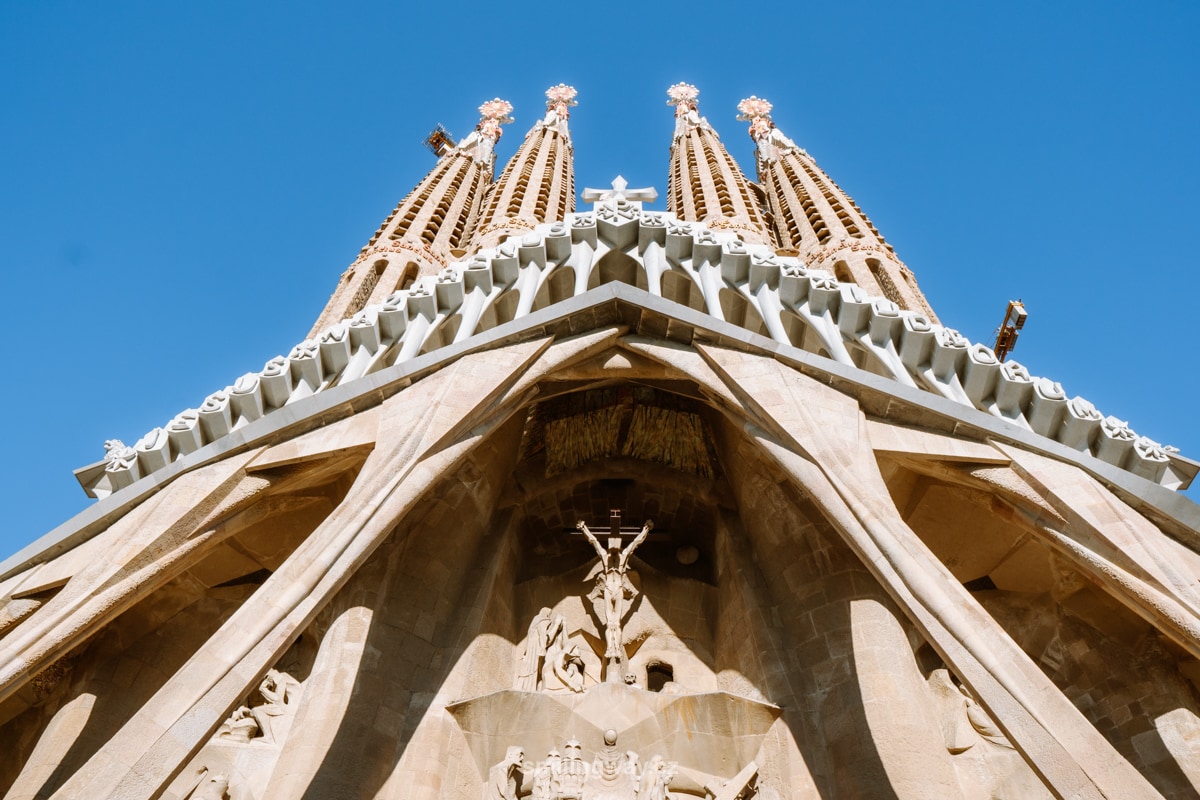
Interesting fact: If something takes too long in Catalonia, the locals say it’s like the “Sagrada Familia”.
Sagrada Familia Basilica must definitely be on everyone’s list of things to see in Barcelona. Everyone wants to see the work that Salvador Dali called “a terrifying and edible beauty”.
As you approach the temple, you will notice that its facades tell a story: the facade of the Nativity, a celebration of life and nature, is rich in detailed carvings of plants and animals (see below). In contrast, the façade of the Passion of Christ stands out with its austere, bony structures that poignantly depict the Passion of Christ (see photo above).
The façade of Glory, which is still under construction, promises to be a spectacular depiction of the journey to God. Of the 3 facades, the facade of Glory should be the most monumental.
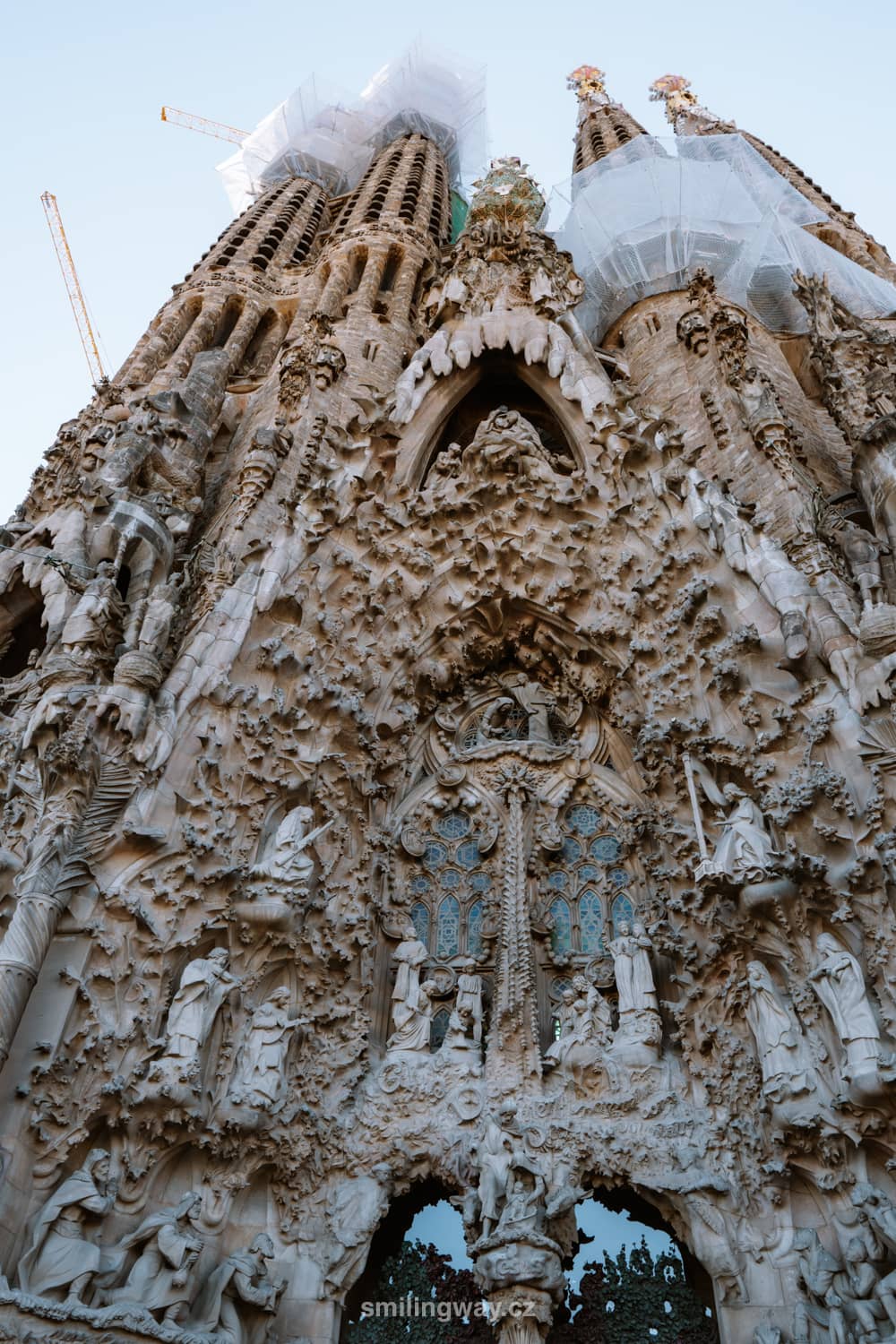
But the best part is inside. As soon as you enter, you’ll feel like you’re in the woods. And this is exactly what Gaudí intended when he designed the building.
Sagrada Familia was meant to be an escape to the countryside. 36 columns of different heights and widths represent trees with branches and leaves, and stained glass windows filter light across the entire colour spectrum.
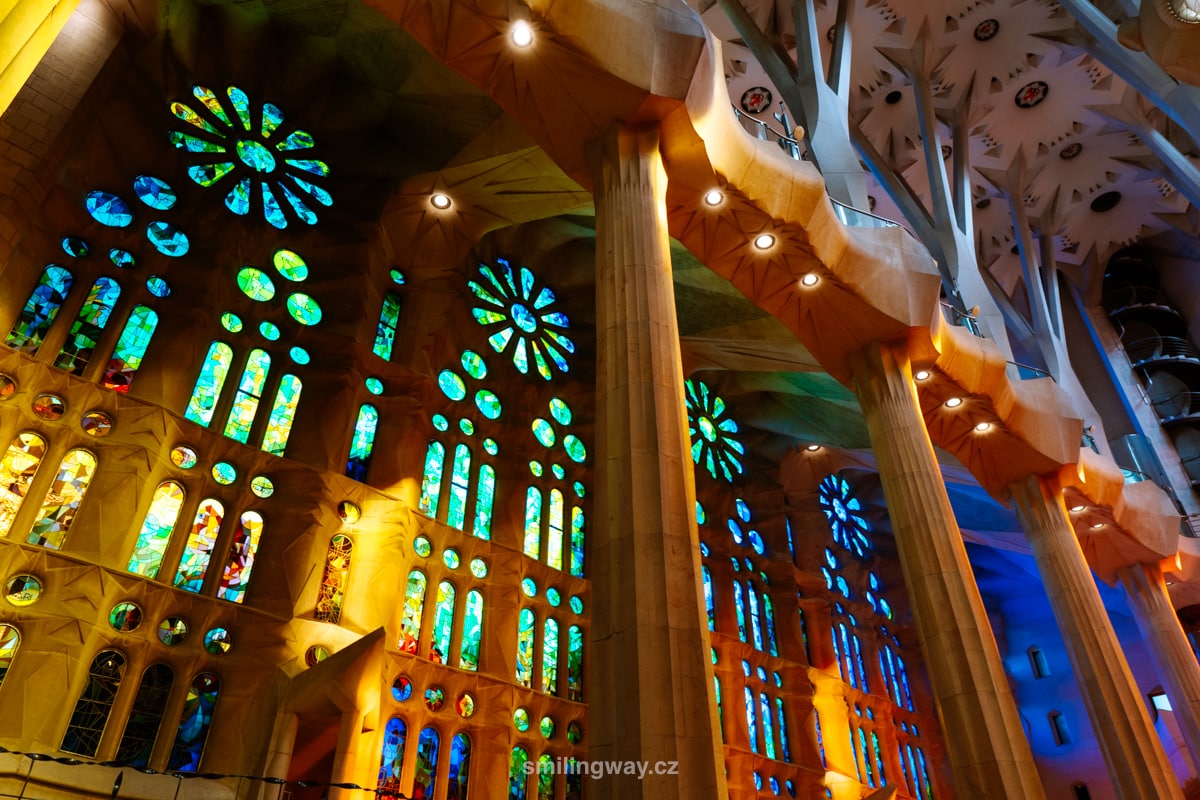
How to skip the lines for Sagrada Familia?
The Sagrada Familia is beautiful. If you were to look at just one monument in Barcelona, it has to be the Sagrada Familia. What’s not so nice anymore are the lines. Especially in high season (from April to autumn) the queues can get quite long.
For this reason, it is better to come outside of the busiest times and schedule your visit for the morning or later in the afternoon.
☞ Note: Tickets to Sagrada Familia must be purchased online – you can choose between a ticket to the Basilica or a visit Basilica with access to the tower. You can then download the tickets to your mobile phone or print them out. When you enter, you just scan the QR code from your ticket and after a security check you can enter.
Entrance to the Sagrada Familia is included in the tourist card Barcelona Pass as part of a guided tour. During the tour, you will learn more interesting facts and discover details you might not have noticed otherwise (there is so much to see).
When entering, also keep in mind that this is a religious building and you should keep your shoulders and knees covered. The Sagrada Familia opens to the public at 9am.
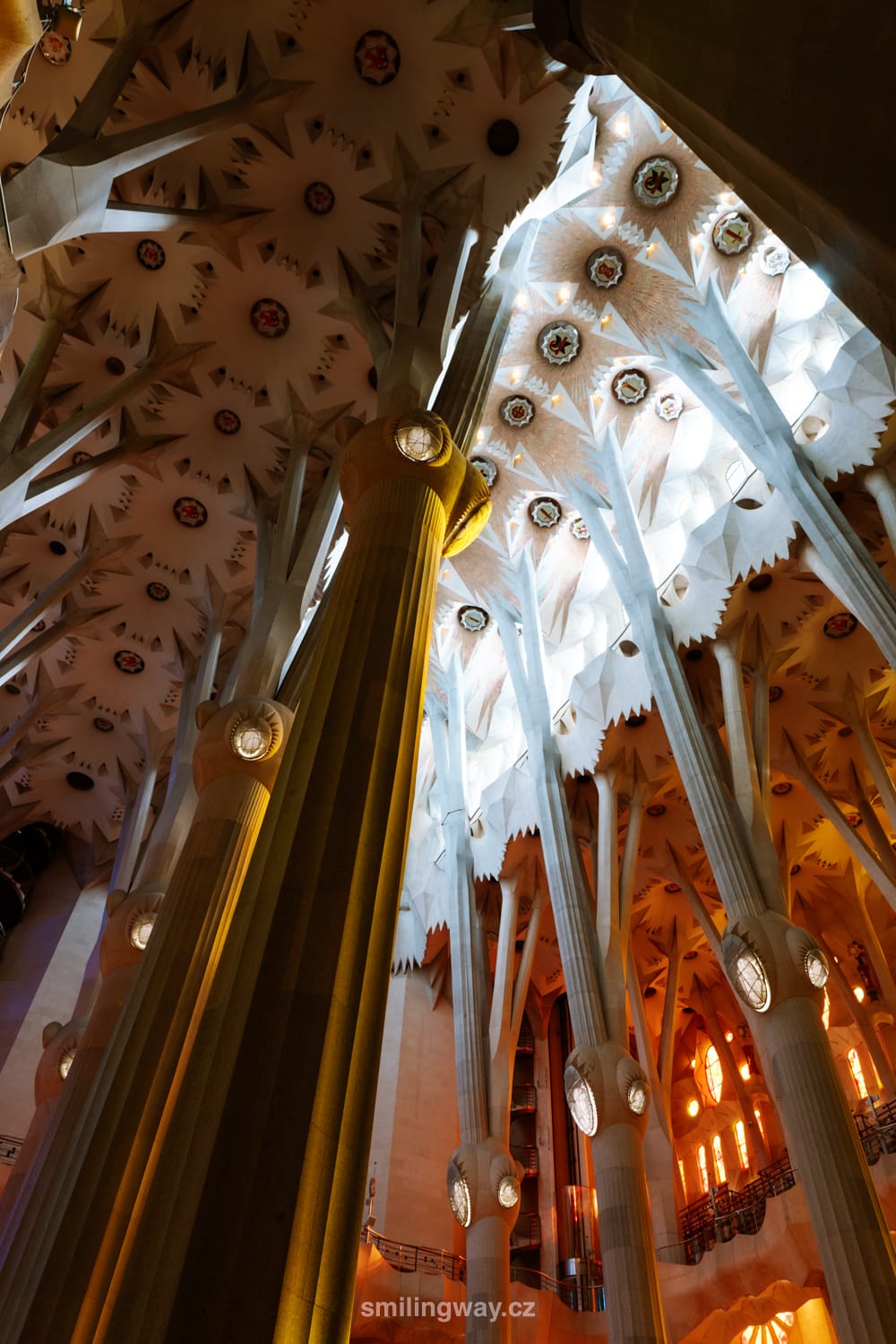
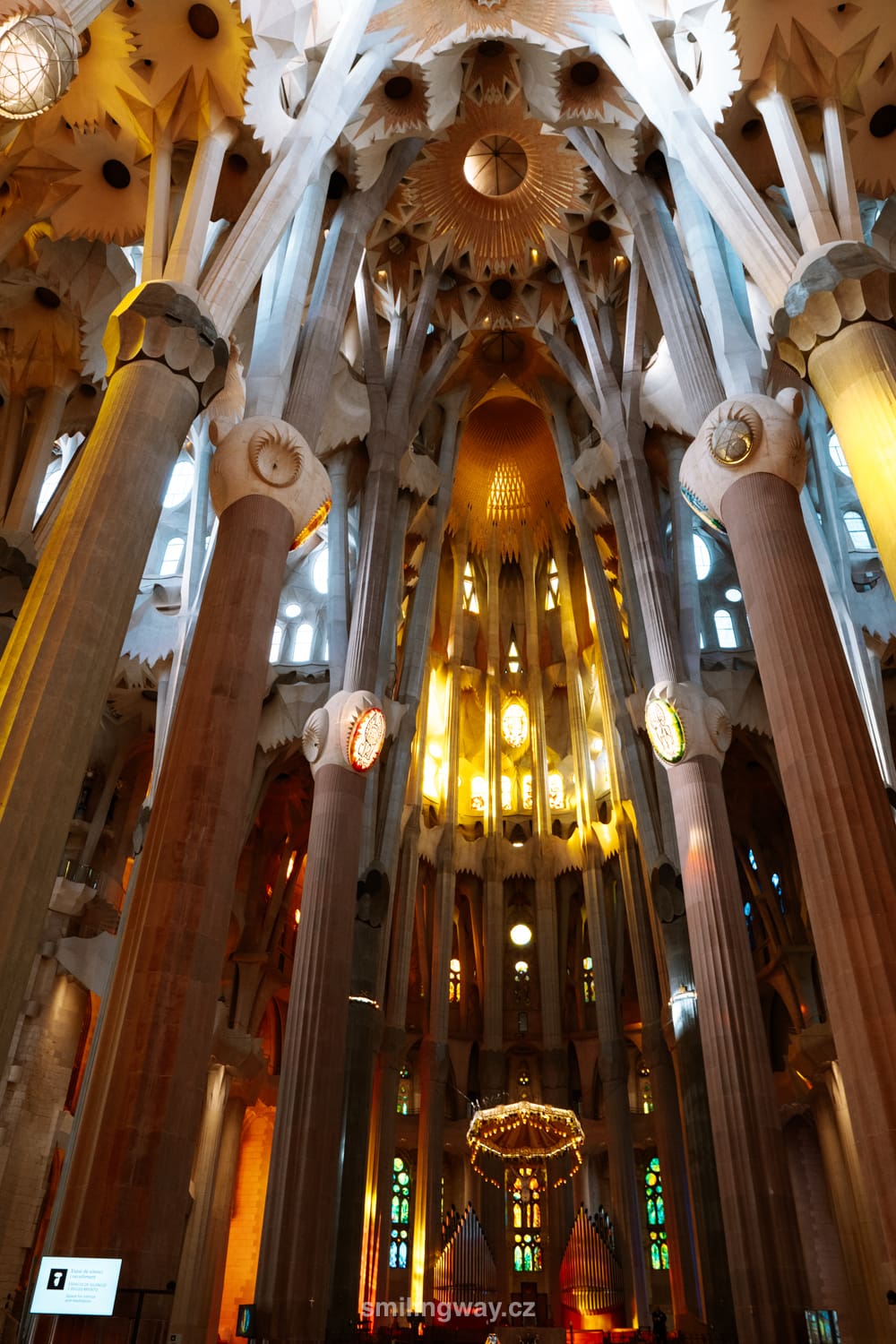
What are the opening hours of Sagrada Familia:
Opening hours vary according to the season – you will need to select a specific time when you make your reservation, which is obligatory:
- from April to September it is open Monday to Friday 9:00-20:00, Saturday 9:00-18:00 and Sunday 10:30-20:00
- in March and October it is open Monday to Friday 9:00-19:00, Saturday 9:00-18:00 and Sunday 10:30-19:00
- from November to February it is open Monday to Saturday 9:00-18:00 and Sunday 10:30-18:00
How much is the entrance fee to the Sagrada Familia:
Admission to the Sagrada Familia in Barcelona varies depending on whether you plan to visit “only” the church here or both the church and the one with the tower. Admission fees vary as follows:
- church only: adults €26, children, students and young people up to 30 years old €24, seniors over 65 years old €21, free for children up to 11 years old, disabled and their accompanying persons
- church and one of the towers: adults €36, children, students and young people under 30 €34, seniors over 65 €28, accompanying persons for disabled persons €10, free for children under 11 and disabled persons
☞ Note: Tickets to Sagrada Familia must be purchased online – you can choose between a ticket to the Basilica or a visit Basilica with access to the tower. You can then download the tickets to your mobile phone or print them out. When you enter, you just scan the QR code from your ticket and after a security check you can enter.
Hospital Sant Pau
Hospital Sant Pau (Recinte Modernista Sant Pau) is a former public hospital housed in an extravagant modernist complex with lots of metalwork, mosaics, stained glass and sculptures. The complex consists of 27 pavilions topped with iconic golden domes.
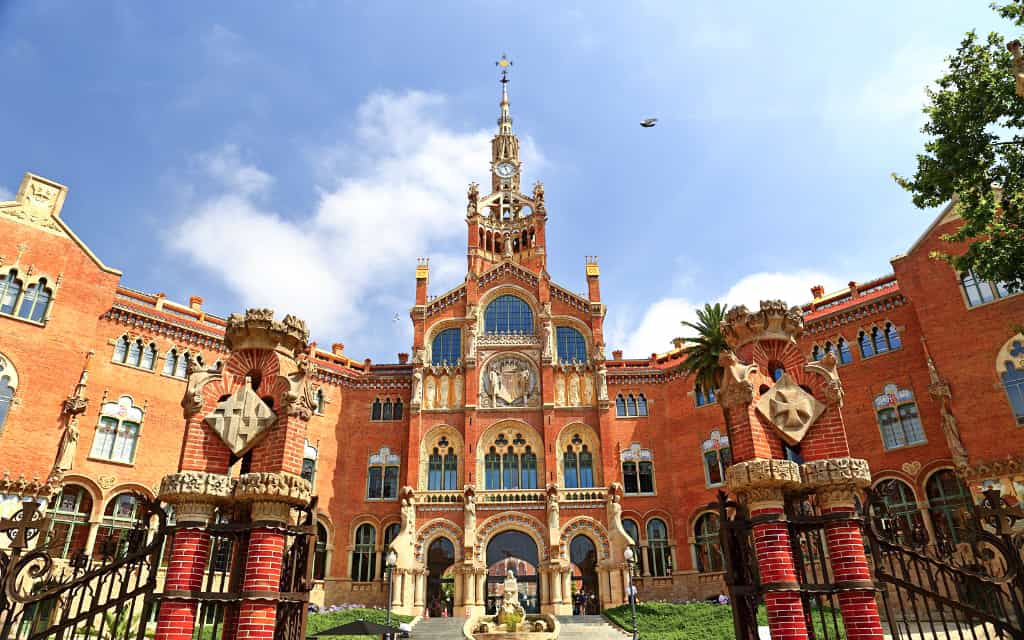
The Sant Pau Hospital opened to the public only a few years ago (it was still operating as a health facility until 2009). Its popularity grows every year.
Recinte Modernista Sant Pau is a masterpiece of both Lluís Domènech and Montaner and became one of the first UNESCO monuments in Barcelona. You can walk around and just admire probably the most spectacular hospital complex in the world.
Sant Pau Hospital can be reached from the Sagrada Familia along the pedestrianised Avinguda de Gaudí in about 10 minutes. The street is lined with historic houses, shops and restaurants.
Is it time to eat? Grab tapas or another Spanish delicacy at Sagradas Tapas, which opens at 11:00. A short walk from Sant Pau Hospital, the BelleBuòn restaurant (open at 13:00) serves excellent Italian cuisine.
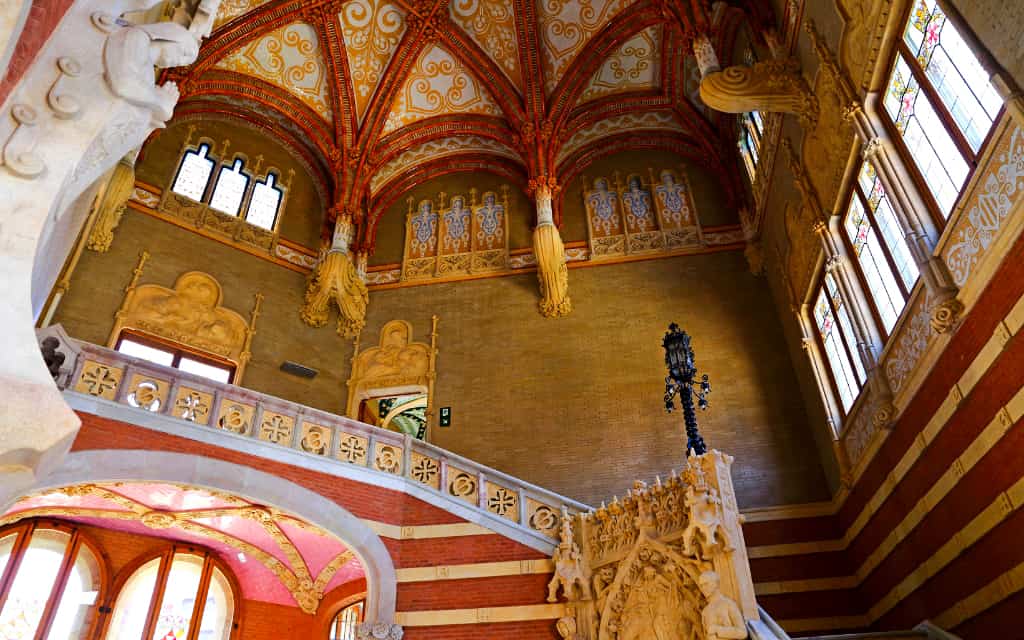
What are the opening hours:
- April-October 10:00-18:30
- November-March 10:00-17:00
How much is the entrance fee to Recinte Modernista de Sant Pau:
- Full admission is €16 for everyone aged 30-64
- Reduced admission €11,20 for young people 12-29 years, seniors over 65 years, disabled people with disabilities below 65%
- Free admission for children up to 11 years and disabled children with disabilities over 65%
- Tickets: Book your tickets here and go straight to the entrance (on the right hand side behind the entrance gate).
Arc de Triomphe
At Sant Pau Hospital, you can take the V19 bus line, which will take you directly to the Arc de Triomphe. You can also take the metro, which stops next to the hospital. In both cases the journey takes about 20 minutes.
The Arc de Triomf was built for the 1888 World’s Fair in Barcelona. However, he became so popular that today he is one of Barcelona’s landmarks.
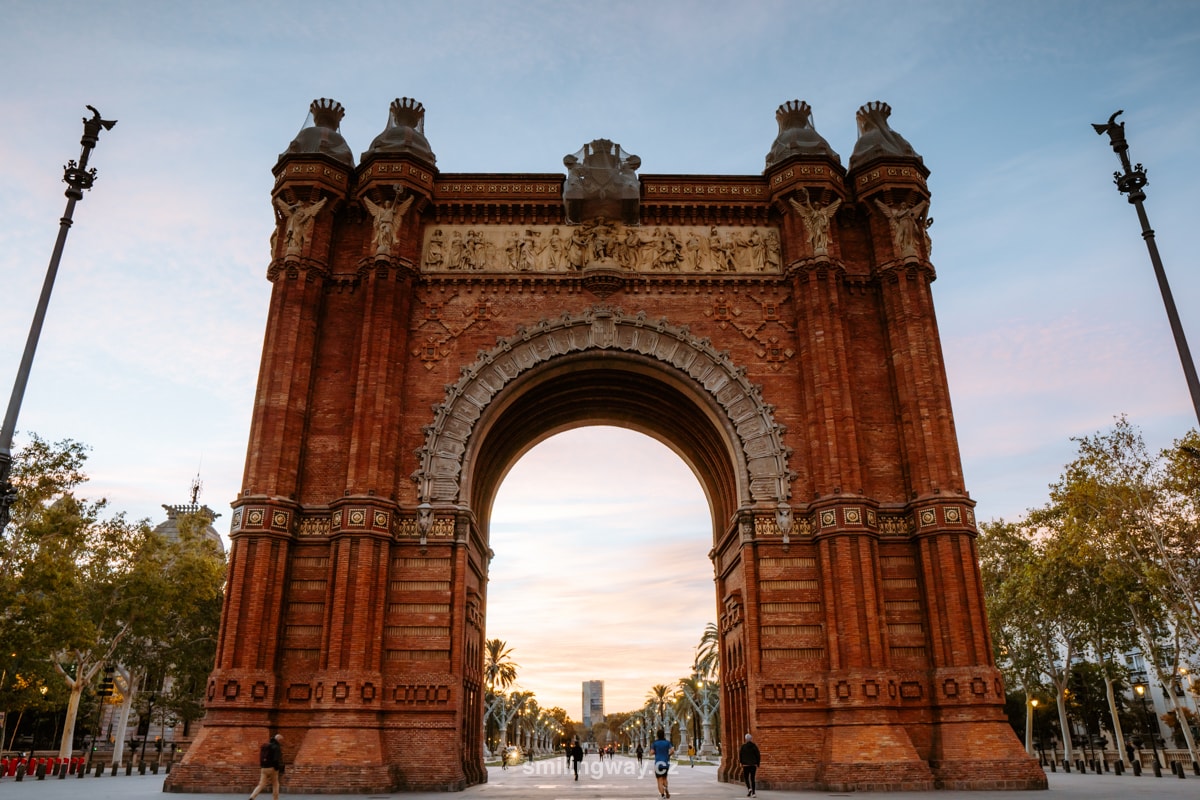
The triumphal arch is an example of modern Renaissance architecture using red brick – a reference to medieval Moorish craftsmanship – and is decorated with four friezes. In these friezes, Barcelona is depicted as a woman welcoming the nations, handing out medals to the participants of the exhibition, representing the intertwining of the city’s economic and cultural growth.
Behind the Arc de Triomphe, a landscaped promenade lined with benches leads to Parc de la Ciutadella.
Hotels in Barcelona 😴

Parc de la Ciutadella
Arc de Triomphe is the gateway to Barcelona’s largest park, Parc de la Ciutadella. You can stroll around, watch street artists or admire the beautiful buildings, including the Catalan Parliament.
As you enter the park, you will see the beautiful Castell dels Tres Dragons building on your right. Turn left and after a few minutes you will reach the famous Baroque fountain designed by Josep Fontseré and Mestrès with the young Gaudi.
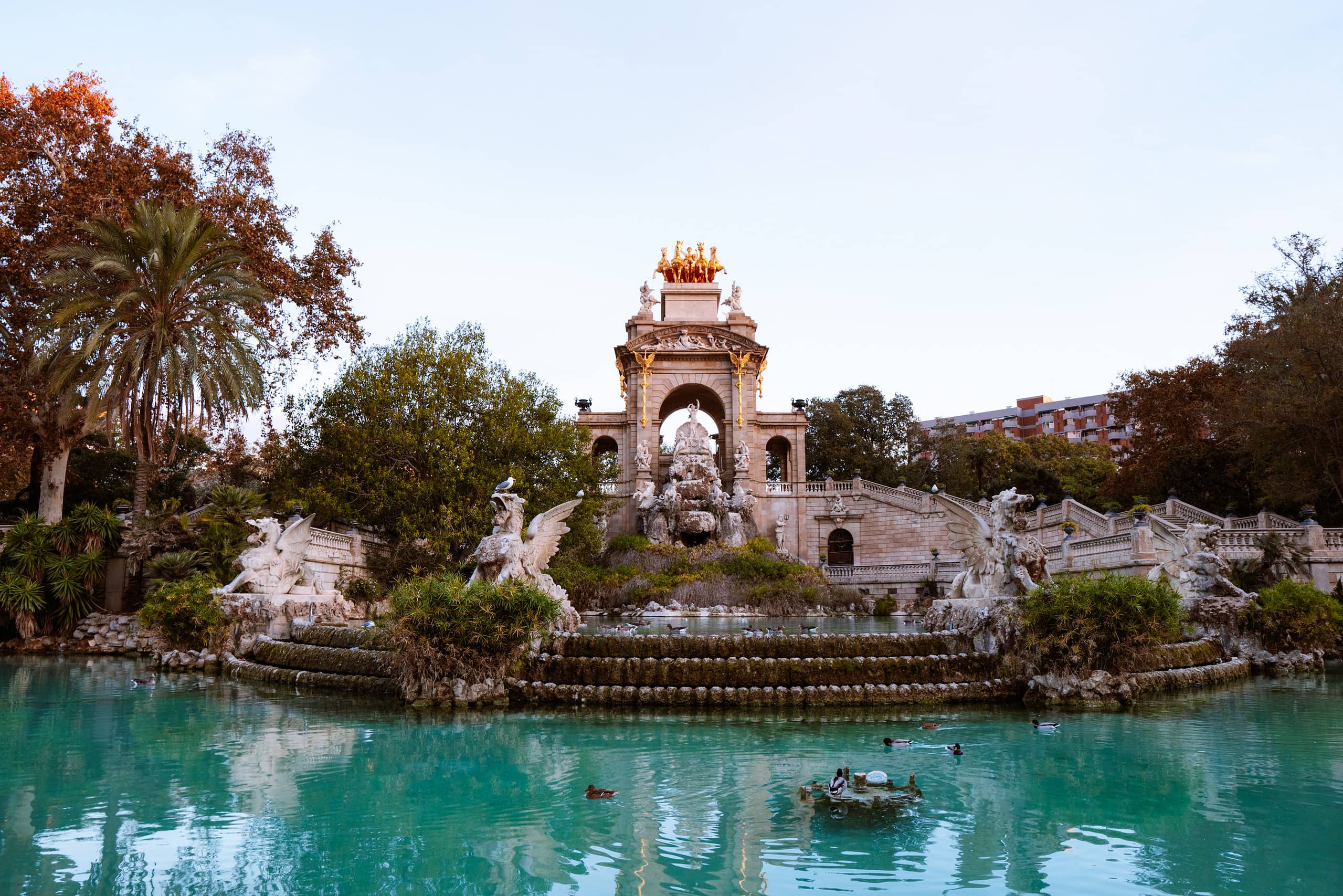
It has been open since early morning, although official sources say otherwise. Locals come here to walk their dogs or for a morning run. It’s not much talked about, but you’ll see plenty of tents among the bushes where the homeless sleep. But you don’t have to worry, because no one will bother you.
El Born
El Born (La Ribera) is a lively neighbourhood with medieval streets, great restaurants, designer boutiques and just the right atmosphere. I fell in love with El Born and I would definitely recommend everyone to take at least a short walk in its narrow streets. Moreover, it is immediately adjacent to the Parc de la Ciutadella.
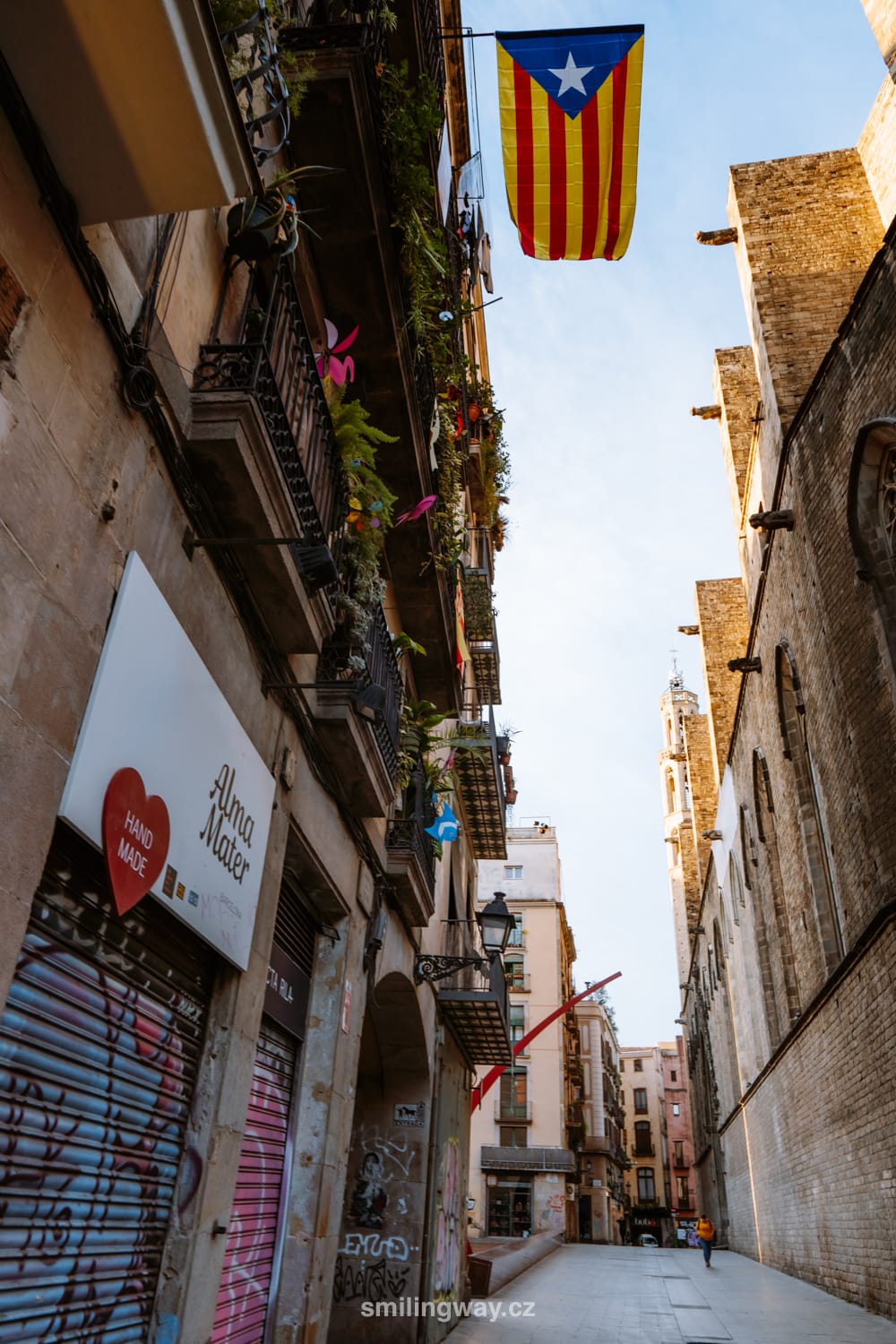
You’ll also find some of the best museums in Barcelona. The best of all is the Picasso Museum, with the largest collection of Picasso in the world (the artist himself donated some 800 of his works; there are over 3,000 in total).
Or do you prefer contemporary street art? Go to the Moco Museum. If you like Banksy, you’ll love it here. The Moco Museum will also appeal to those who don’t normally seek out museums and art.
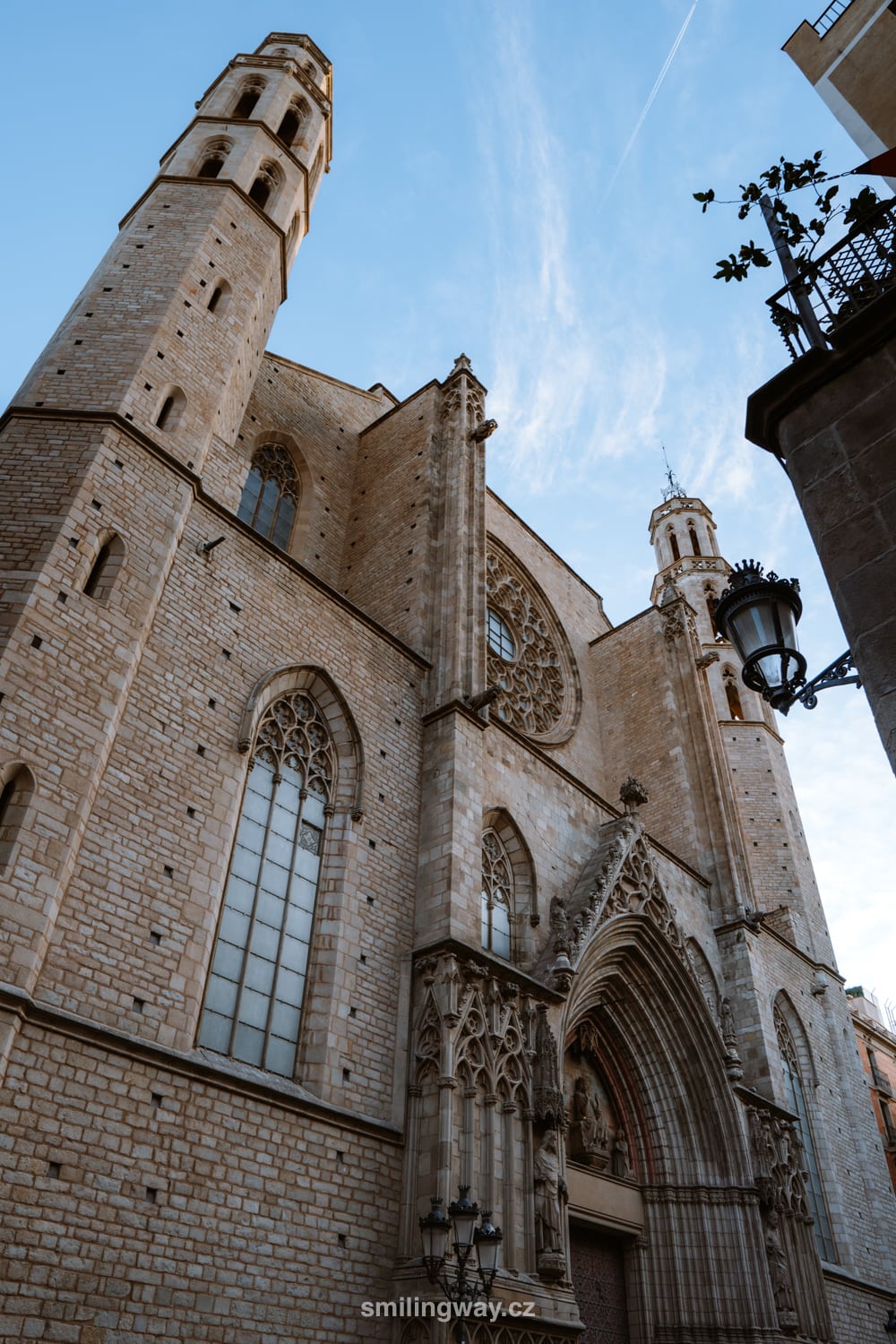
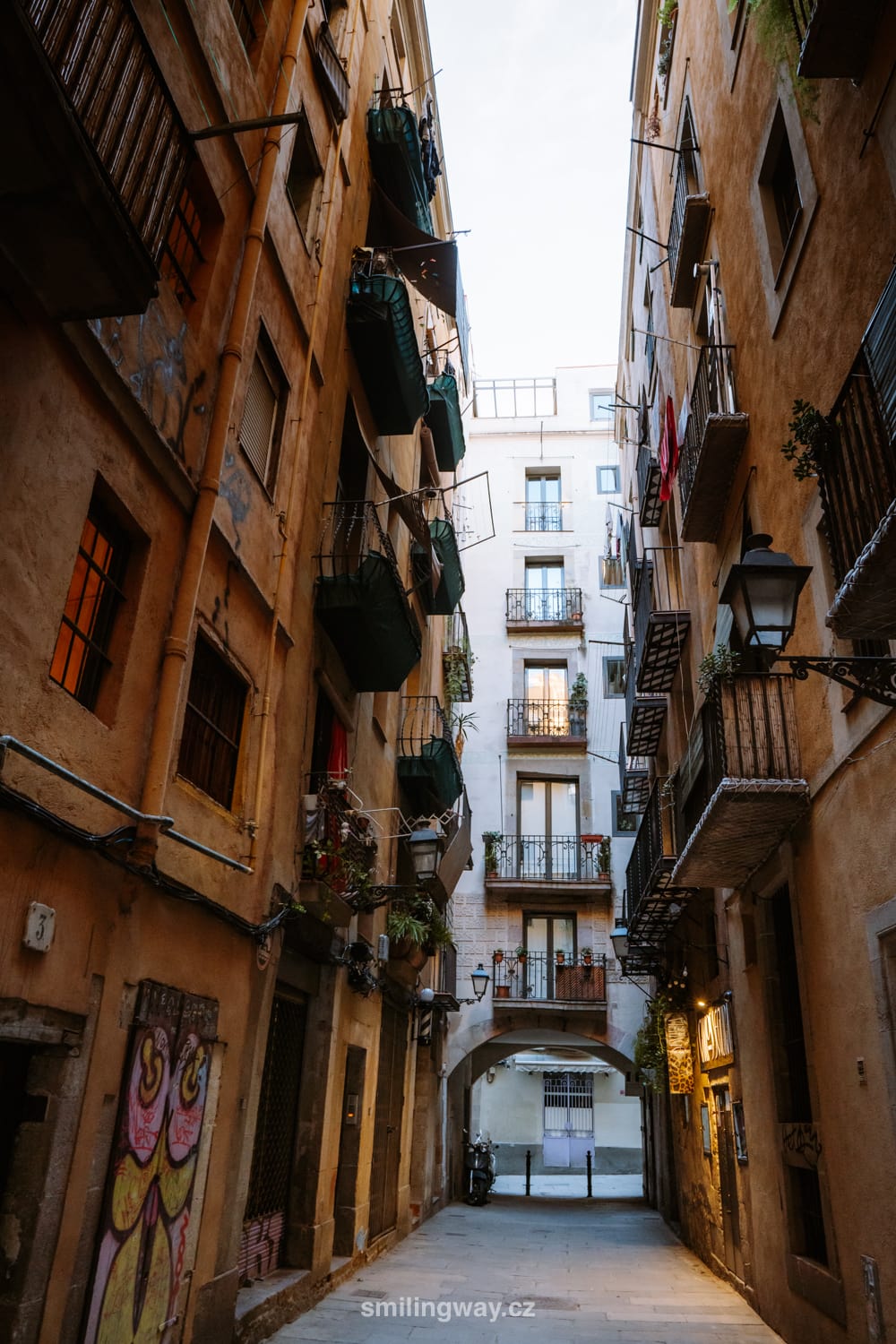
The heart of the district is the Church of Santa Maria del Mar. Unlike other religious buildings, the church of Santa Maria del Mar was built by the local people. You can enjoy the beautiful Gothic interiors and go up to the terrace for a fee.
- Admission to the Basilica of Santa Maria del Mar: Admission is €5 from Monday to Saturday from 10:00-18:00 and on Sundays from 13:30-17:00. Outside these times, admission is free. An entrance fee of €10 is charged for entry to the towers and terraces. Free admission for children under 10 and people with disabilities over 65%.
- Opening hours: daily 10:00-20:30
Where to eat in El Born?
El Born is known for its restaurants, tapas bar and cocktail bars. You rarely step wrong here. Here are some of our tips:
- Puertecillo Born – renowned seafood restaurant in an authentic setting
- CAJÚ gelato – best gelato in the area with a friendly owner
- La Pizza Del Born – excellent pizza and empanadas at great prices
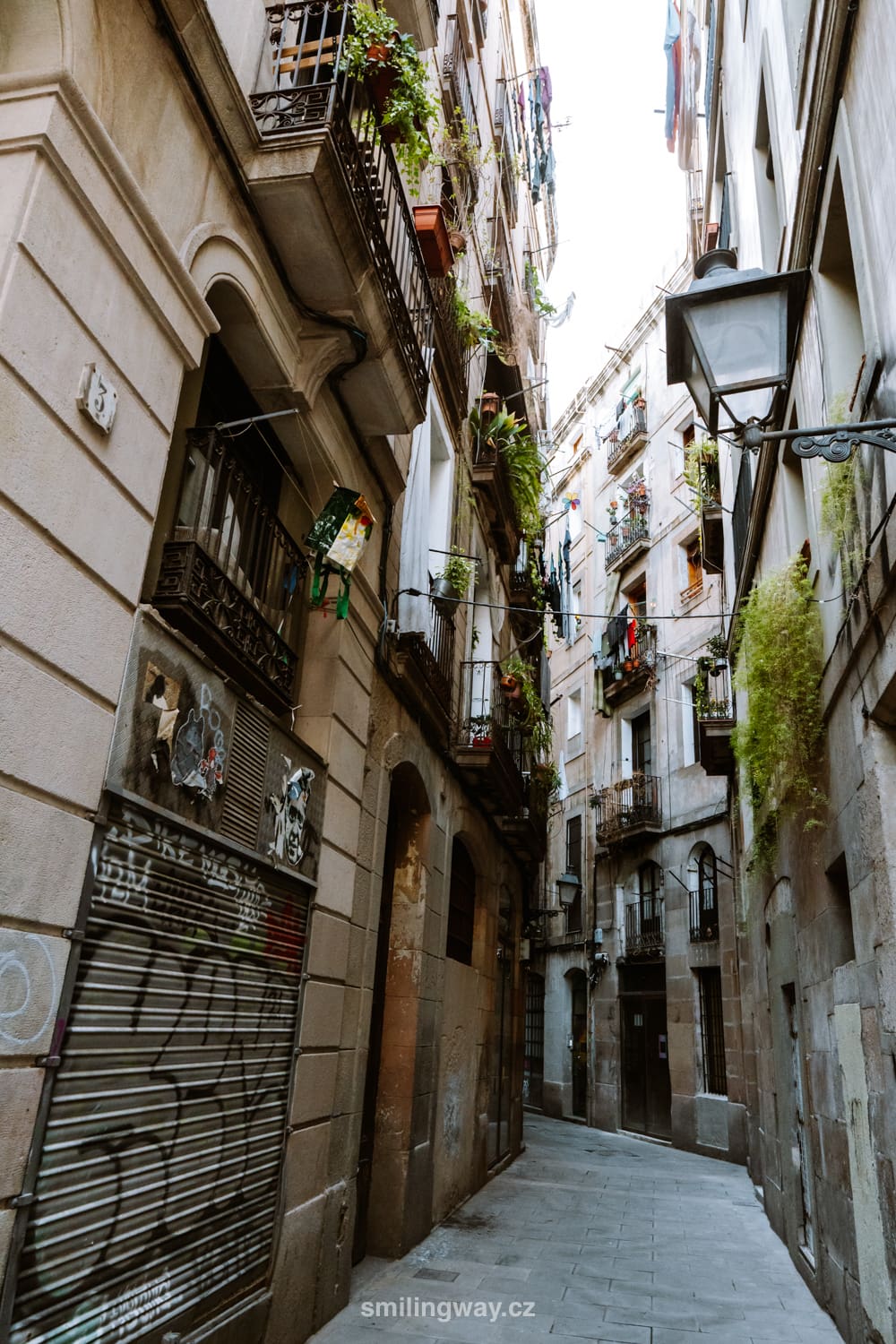
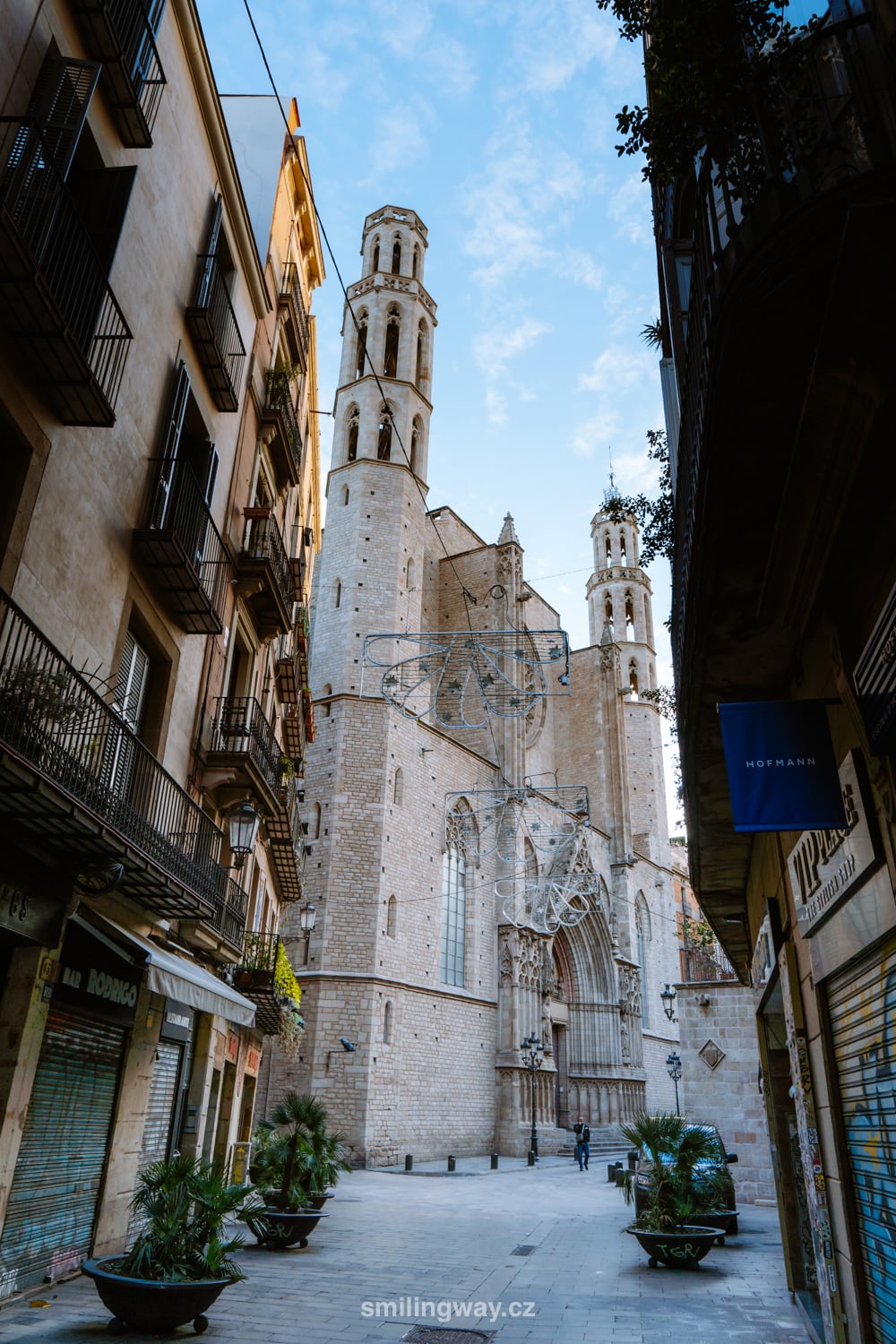
La Barceloneta
Few cities in Europe have as good access to the sea as Barcelona. It would be a great shame to visit Barcelona and not walk the famous promenade around La Barceloneta beach. At any time of the year.
La Barceloneta is an artificial beach created for the 1992 Olympic Games. It used to be a small fishing village, but after the Olympics it changed beyond recognition. Everything is beautifully landscaped and there are plenty of places to eat nearby.
☞ Barcelona City Pass includes the most popular sights in Barcelona, including the Sagrada Familia and Park Güell.
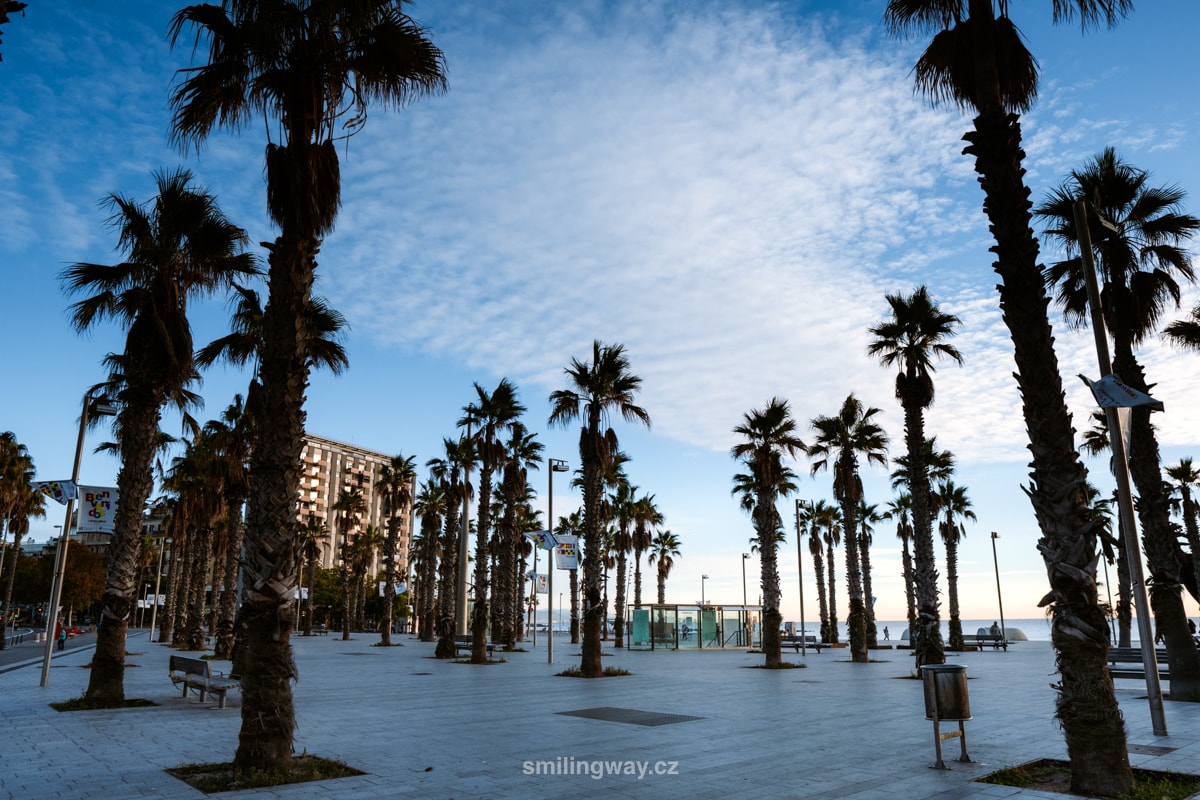
Where to eat around La Barceloneta?
There are plenty of places to eat around La Barceloneta. For Spanish cuisine, try the Salamanca, Barceloneta or Tapa Tapa restaurants overlooking the beach. Seafood is freshly prepared at Casa Marina Picufi.
For delicious tapas, head to La Bombeta, Cal Chusco, Bar Jai-Ca or La Cova Fumada. If you want to enjoy a burger, tortilla or other international cuisine, try Surf House Barcelona overlooking the sea. La Malandrina is renowned for its Argentinian cuisine.
All tips can be found in the map at the beginning of this article.
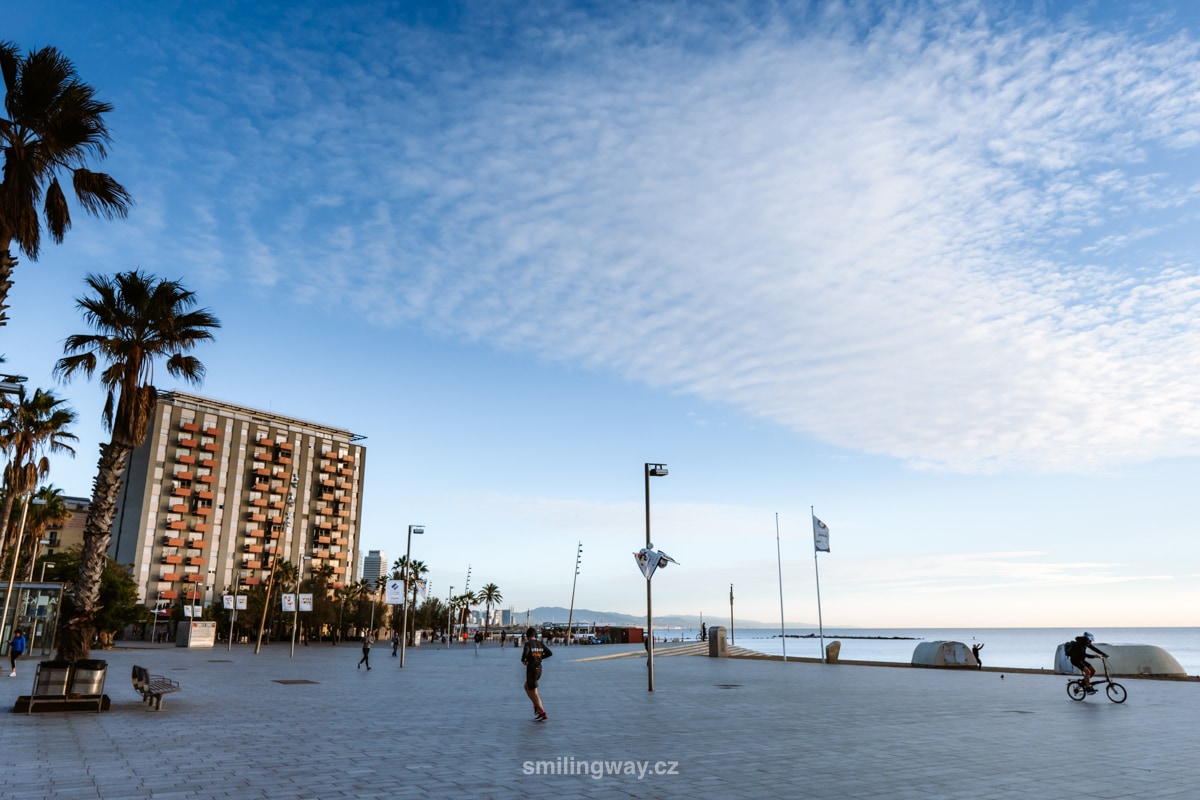
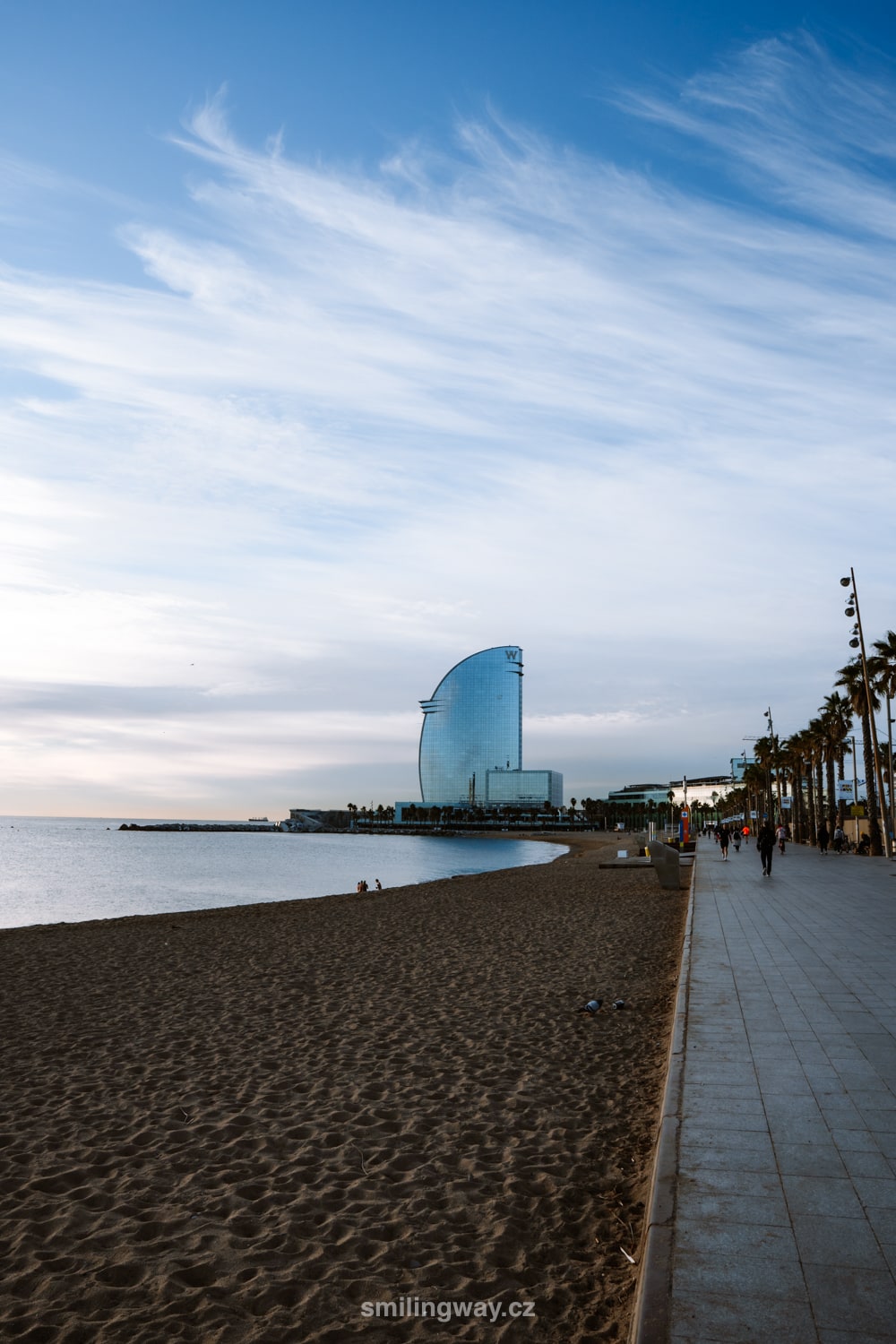
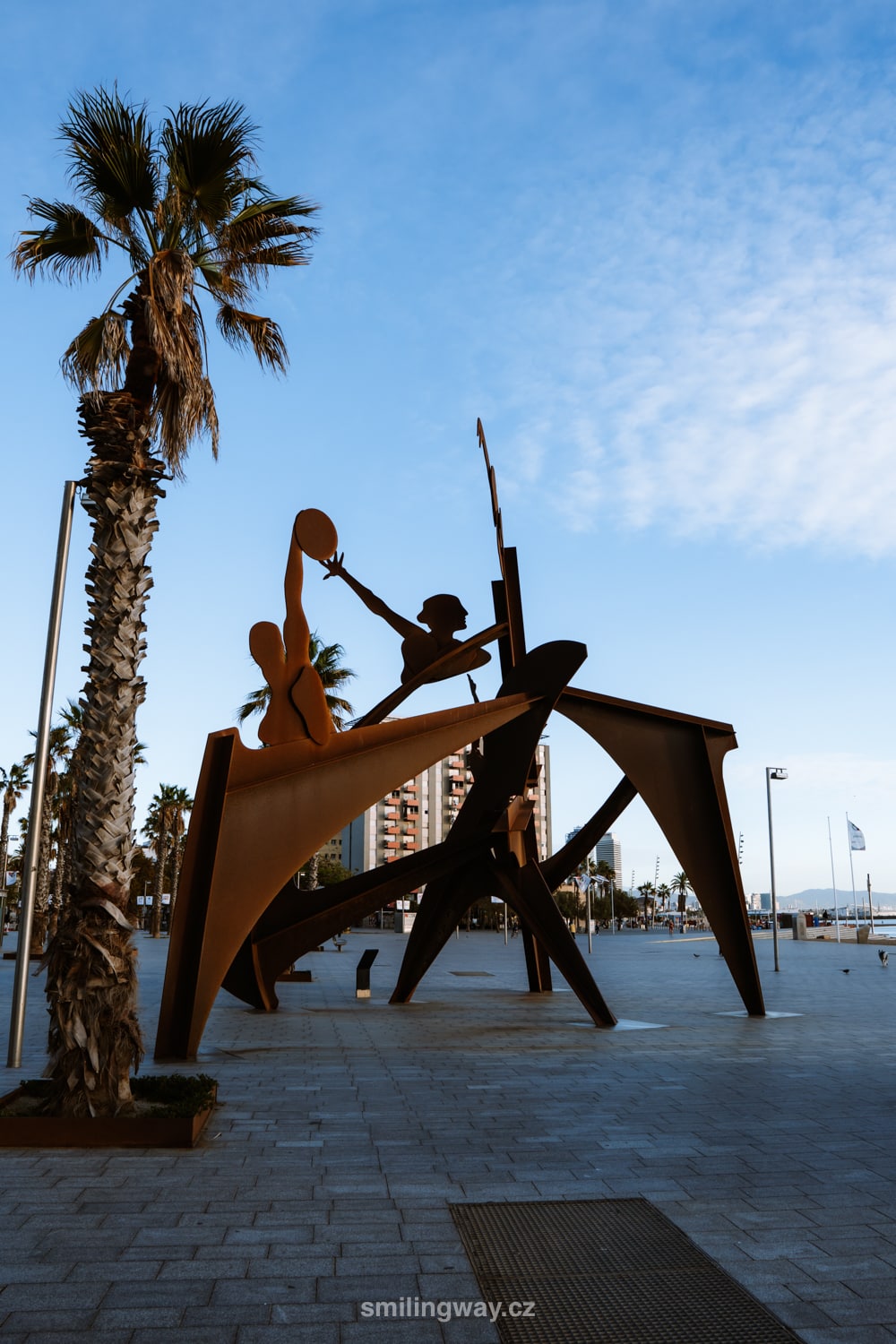
BARCELONA IN 3 DAYS: Passeig de Gracia and the Gothic Quarter
Itinerary for Day 2 in Barcelona
- Casa Milà – La Pedrera
- Casa Batlló
- Catalan Square
- Gothic Quarter
- La Rambla
- Parc Olympic
Casa Milà – La Pedrera
Barcelona has two most famous avenues – La Rambla and Passeig de Gràcia. Passeig de Gràcia is particularly important for Catalans, as it is the city’s main commercial artery.
And this is where we start today, because the avenue is lined with beautiful modernist buildings.
The first is Casa Milà – La Pedrera, one of the most famous buildings in Barcelona and another work of Gaudí.
At first glance, you will be attracted by the undulating facade, which mimics the nearby Mount Montserrat. The balconies are decorated with abundantly wrapped metal and unconventional chimneys peek out from the roof.
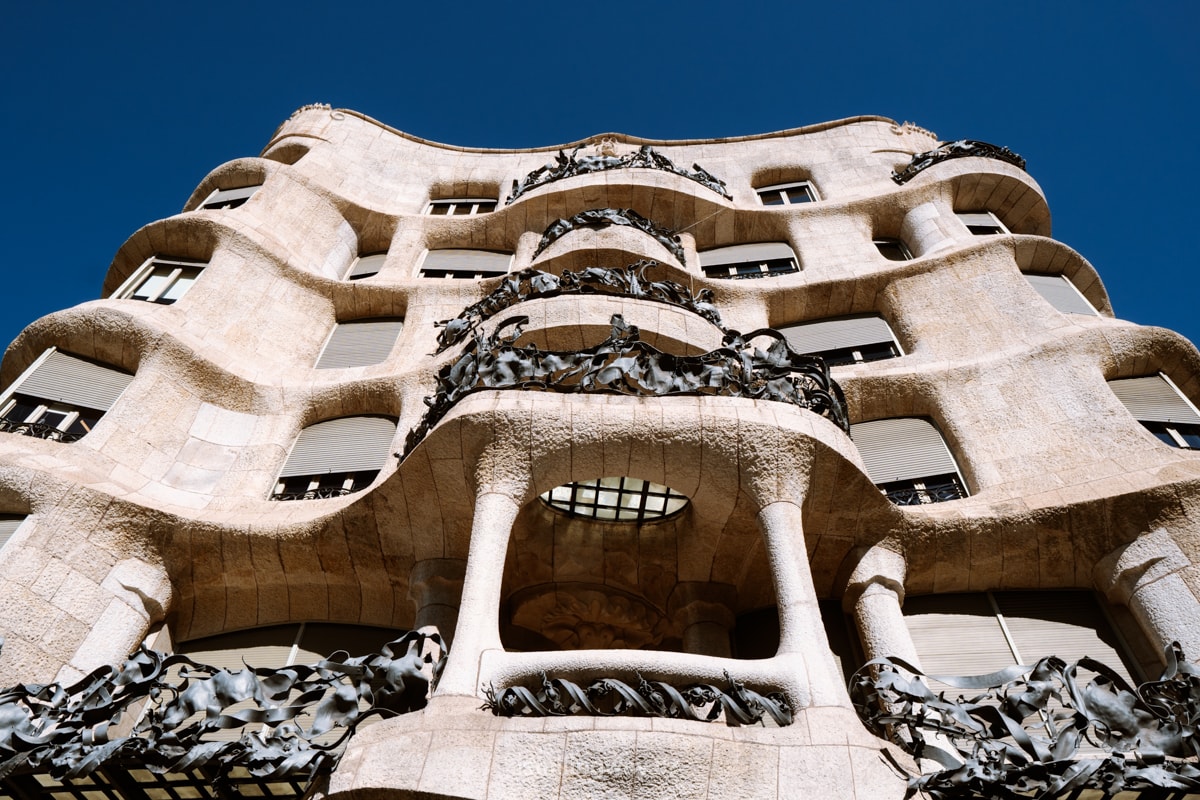
Inside Casa Milà, you can admire the interior and climb up to the rooftop for a great view of the city. La Pedrera was Gaudí’s last work before the Sagrada Familia.
What are the opening hours?
- in season 9:00-20:30, night tour 20:30-23:00
- low season 9:00-18:30, night tour 20:40-22:00
- last entry half an hour before the end of opening hours
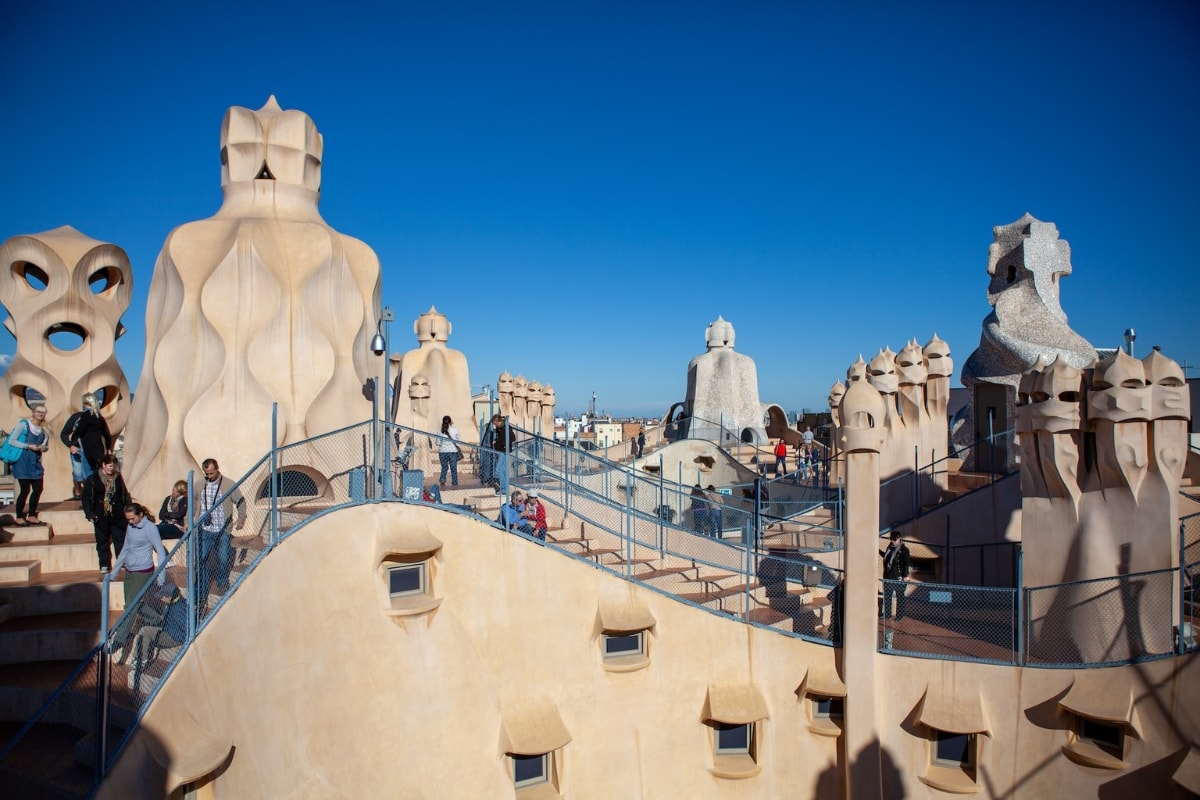
How much is the entrance fee to Casa Milà?
- Full admission is €27 on site and €25 when booking online
- Reduced admission is €15 for children 7-12 years old on site and €12.50 when booking online
- Reduced admission is €21,50 for students and seniors over 65 years of age on site and €19 when booking online
☞ Casa Milà is one of the most popular sights in Barcelona where queues can form. If you book tickets in advance, you can skip the lines and save money at the same time (tickets are more expensive on site). Casa Milà is open until the evening, when you can go to see the light show at La Pedrera, views of Barcelona in the evening and a glass of cava (Spanish sparkling wine).
There is a staff member at the entrance where you show your tickets and you can go in.
We continue down the avenue towards Plaza Catalunya and in a few minutes we come to another famous building – Casa Batlló.
Casa Batlló
Casa Batlló impresses from afar with its colours and stained glass windows. In the past, it was a boring apartment building that Gaudí was given the task of reviving. At first glance you will see that he had a completely free hand in his work.
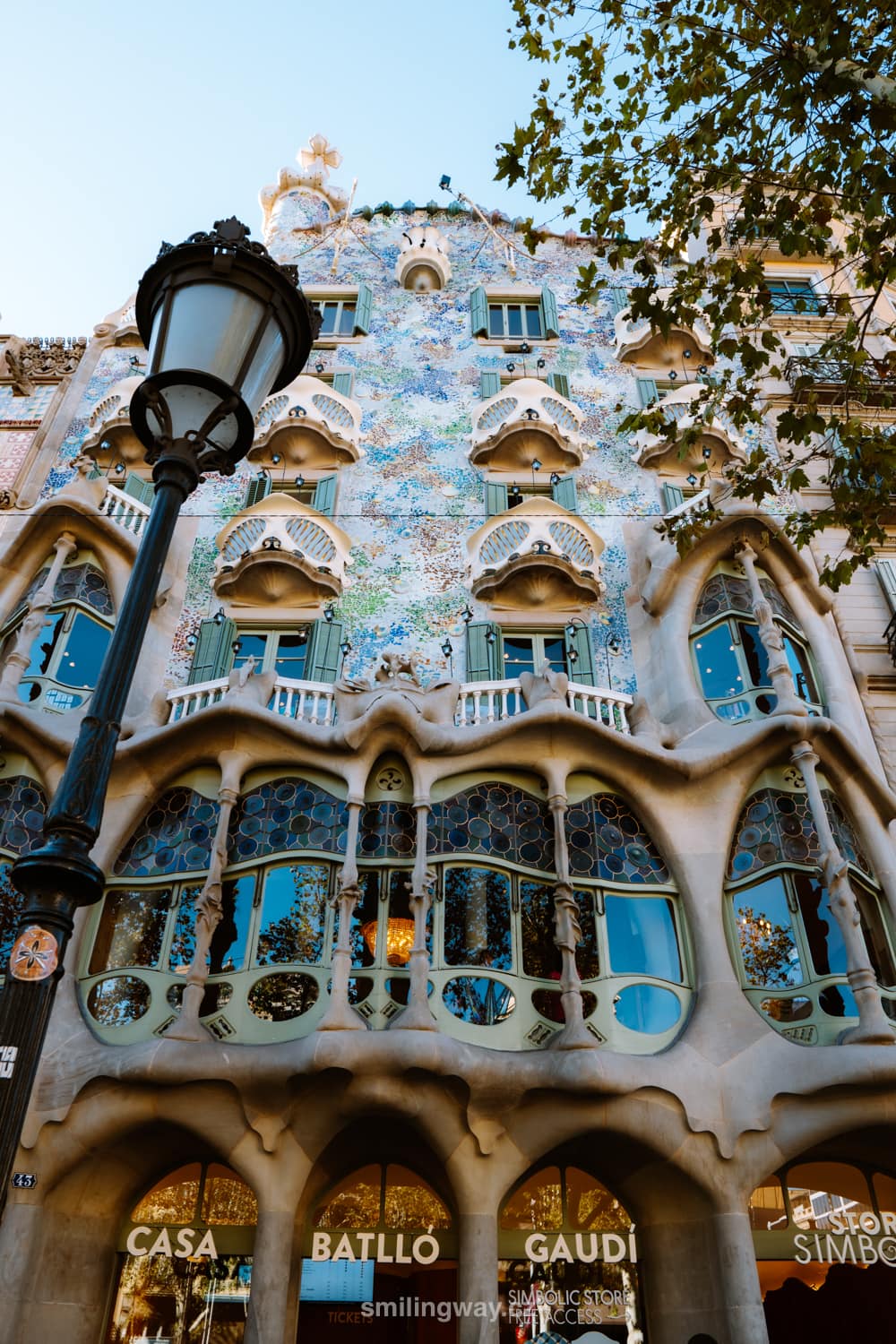
The undulating facade with mosaic glass, ceramic panels and stone columns is just a small taste of what awaits you inside. An underwater world with undulating walls, ceiling patterns resembling shells and a roof with kaleidoscopic patterns of broken ceramic tiles and glass that represent the spine of a slain dragon.
Tickets aren’t the cheapest, but if you like Gaudí’s work, you’ll love the interior of Casa Batlló and the overall 10D experience.
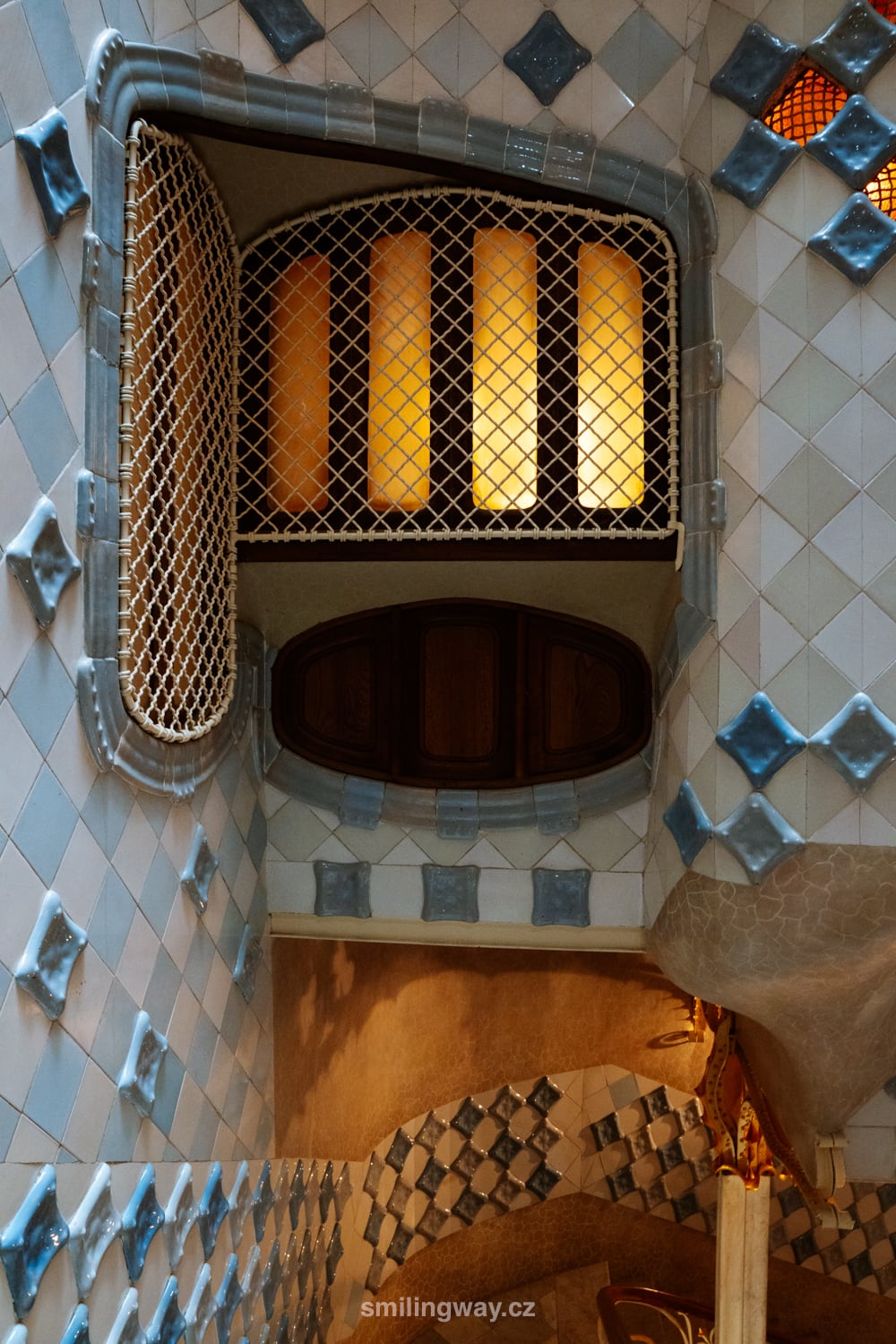
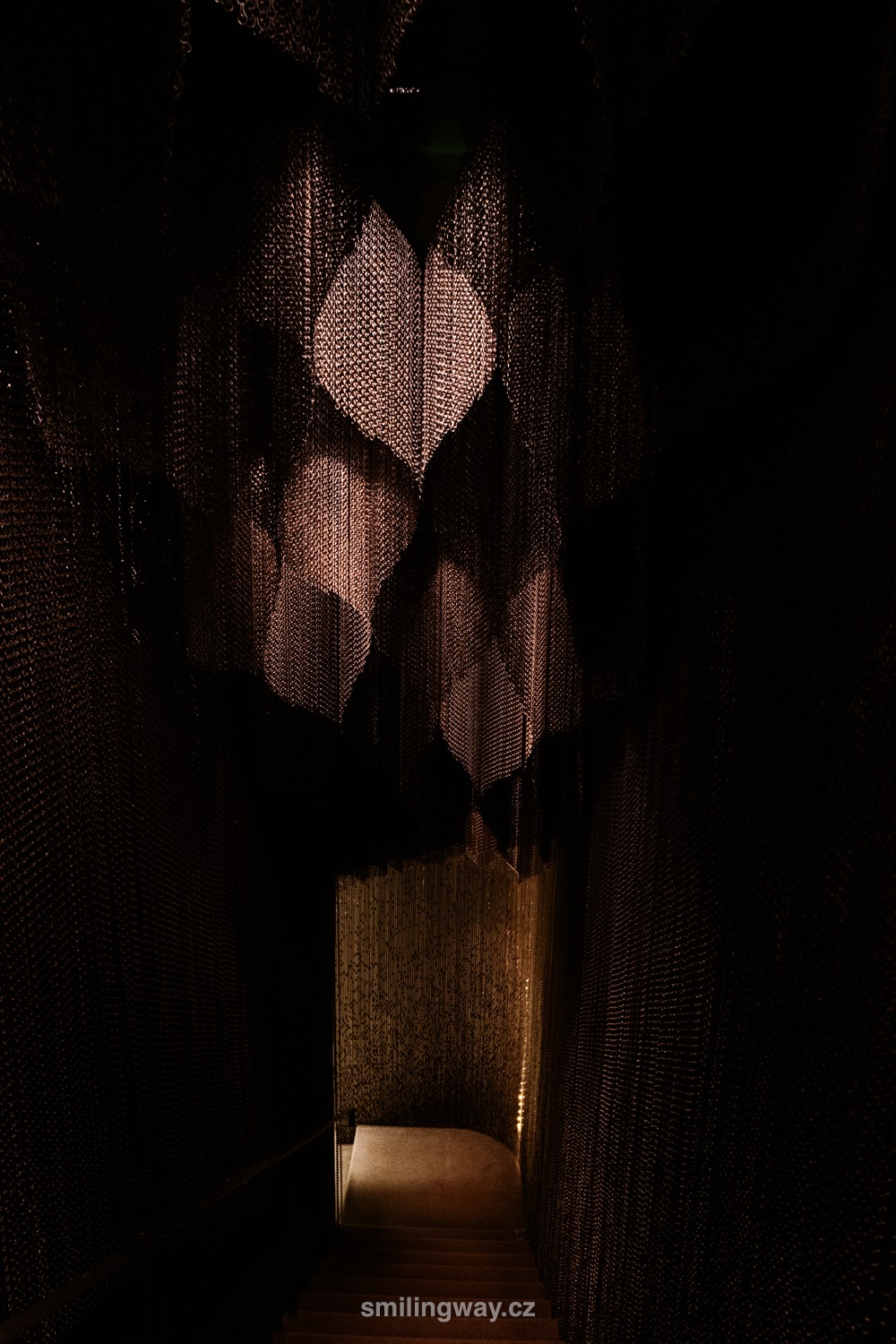
What are the opening hours of Casa Batlló?
- in season 9:00-20:15
- low season 9:00-18:30
How much is the entrance fee to Casa Batlló:
- Full admission is €35 when booking online and €39 on site
- Reduced admission €29 for children 12-17 years and students and €33 on site
- Reduced admission €32 for seniors over 65 and €36 on site
- Children up to 11 years of age are admitted free of charge
☞ I definitely recommend buying a ticket in advance because you save money and get in right away. If you go in the morning, you can see the house inside with just a few others. In the morning, the crowds will pile in and the roof can get a bit crowded. You will choose the specific time when booking.
Casa Amatller
Casa Amatller is to the left of Casa Batlló. Unlike Casa Batlló, far fewer tourists come here. Casa Amatller is the work of architect Josef Puig and is known for its beautiful façade. It is made up of medieval towers and branches of the almond tree – Amatller, which means almond tree in Catalan.
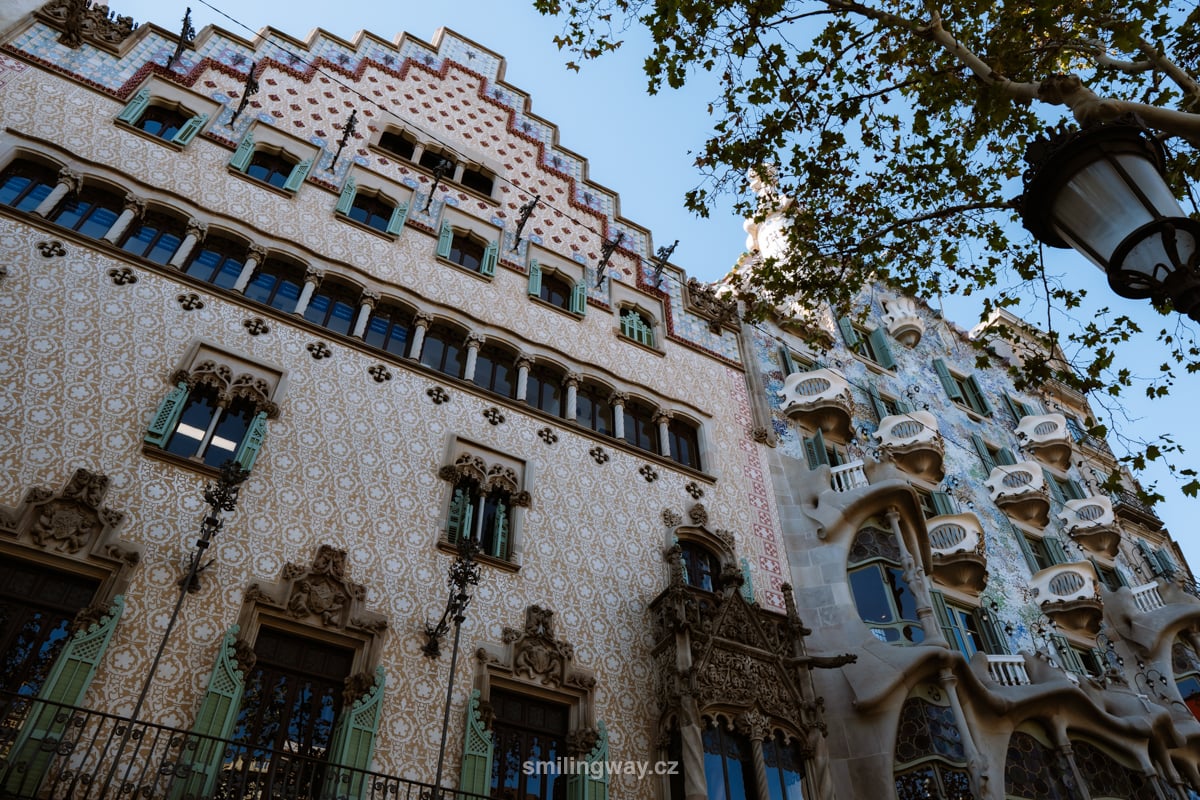
The Amatller family was in the 18th century. century known for chocolate production. On the ground floor of the houses there is a Faborit chocolate shop where you can have Amatller hot chocolate with churros and melindros (and other snacks).
Opening hours: Casa Amatller is open daily from 10:00-20:00.
How much is the entrance fee to Casa Amatller:
- Full admission is €17
- Reduced admission is €10 for young people under 30 years of age
- Reduced admission is €15 for seniors over 65 years of age
- Children up to 7 years of age are admitted free of charge
- Tickets: Book tickets for Casa Amatller.
Continuing down the avenue, we pass several other beautiful buildings, such as Casa Mulleras and, a little further down, Casa Malagrida (both on the right).
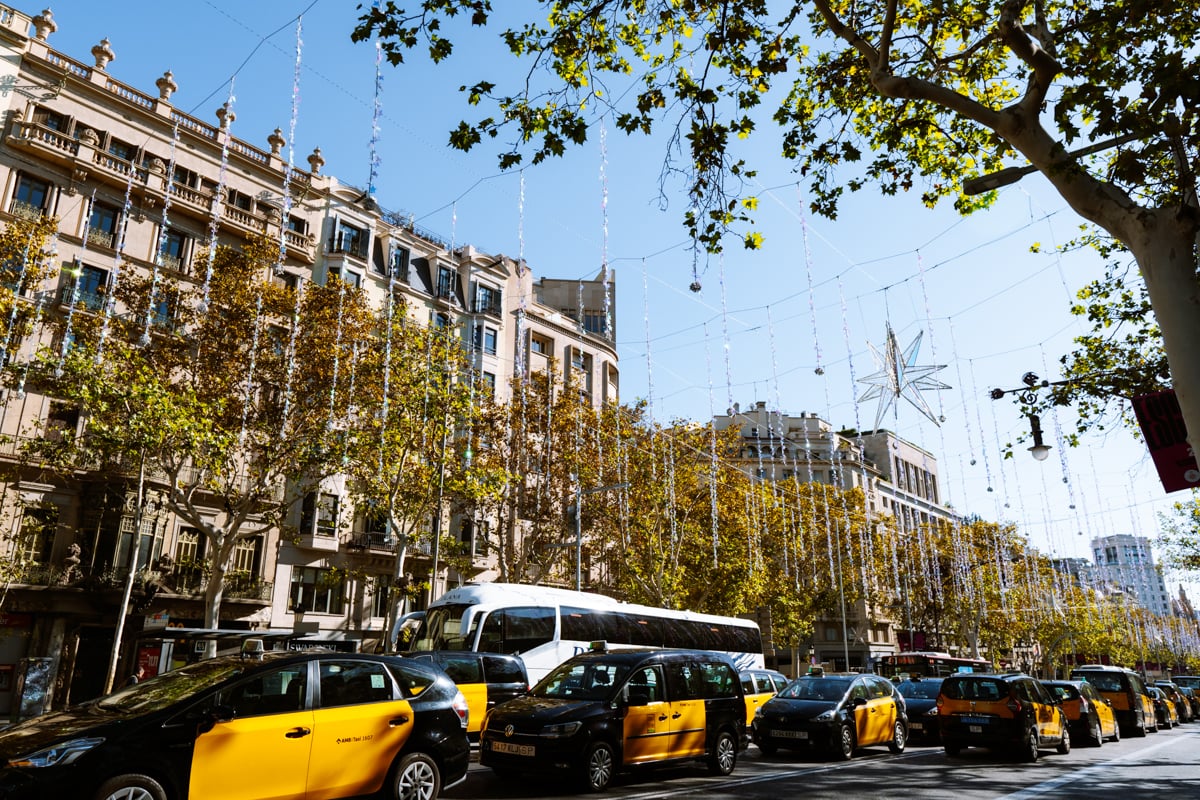
Plaça de Catalunya
Plaça de Catalunya is the centre of Barcelona, separating the old part of the city from the elegant Eixample district. The 2 most famous streets in Barcelona converge here – La Rambla and Passeig de Gràcia. There are several shopping centres, shops and cafés.
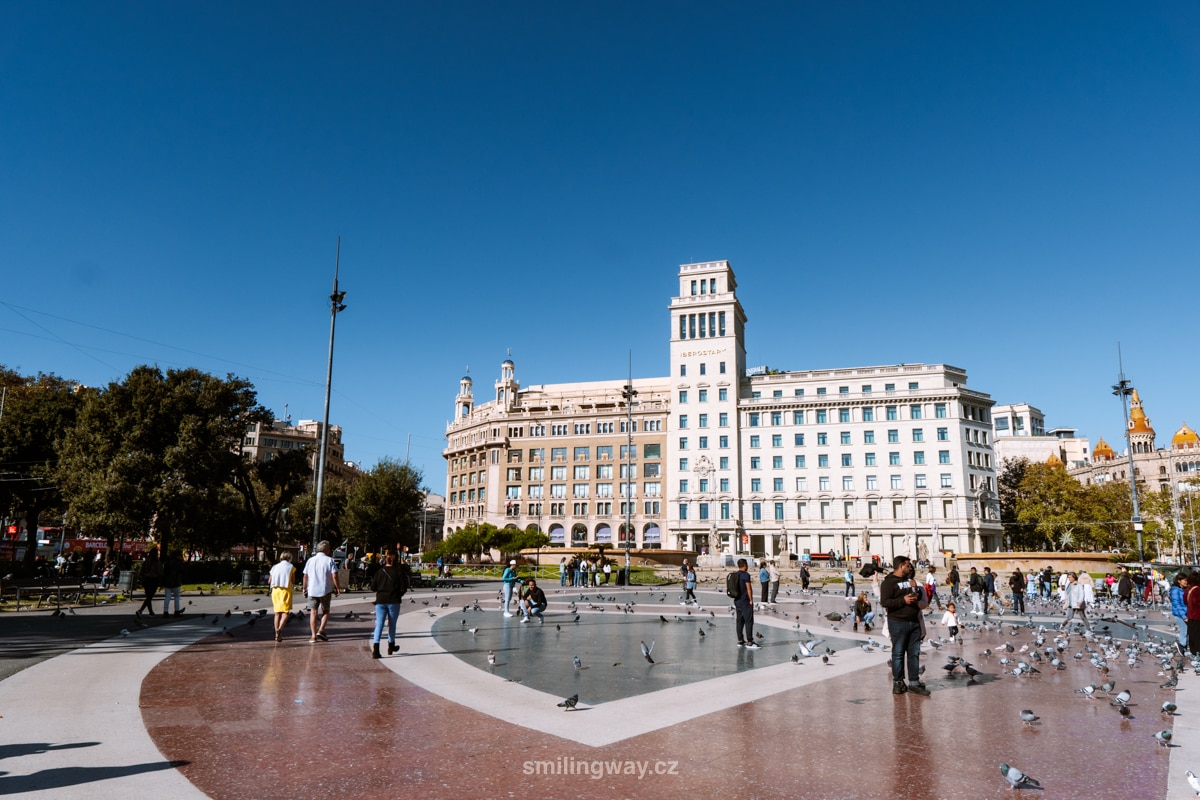
You can just sit on a bench and watch the people chatter. Around the square are 6 sculptures representing the 4 Catalan capitals, wisdom and work. Other than that, not much to see here though, so we’re moving on soon.
If time permits, head to El Nacional Barcelona – a stylish and renowned venue with several restaurants and bars. They are open from noon until night (the exact location is marked on the map).
☞ How to save on sightseeing fees: Planning to visit more paid sights, museums and attractions? Get Barcelona Pass. This is a tourist card that gives you free entry to over 35 sites in Barcelona including the Sagrada Familia, Park Güell, Casa Batlló, La Pedrera or Camp Nou.
Gothic Quarter
It’s around noon and high time to head to the Gothic Quarter (Barri Gotic), where we will spend the rest of the day. Barri Gotic was formerly surrounded by city walls and was the heart of the city during Roman rule and later in the Middle Ages.
Although it is 2,000 years old, making it the oldest neighbourhood in Barcelona, many of the buildings here date back to the 19th and 20th centuries. Gothic Quarter is characterised by its narrow cobbled streets and many historic corners that take you back in time. You can just walk around and enjoy.
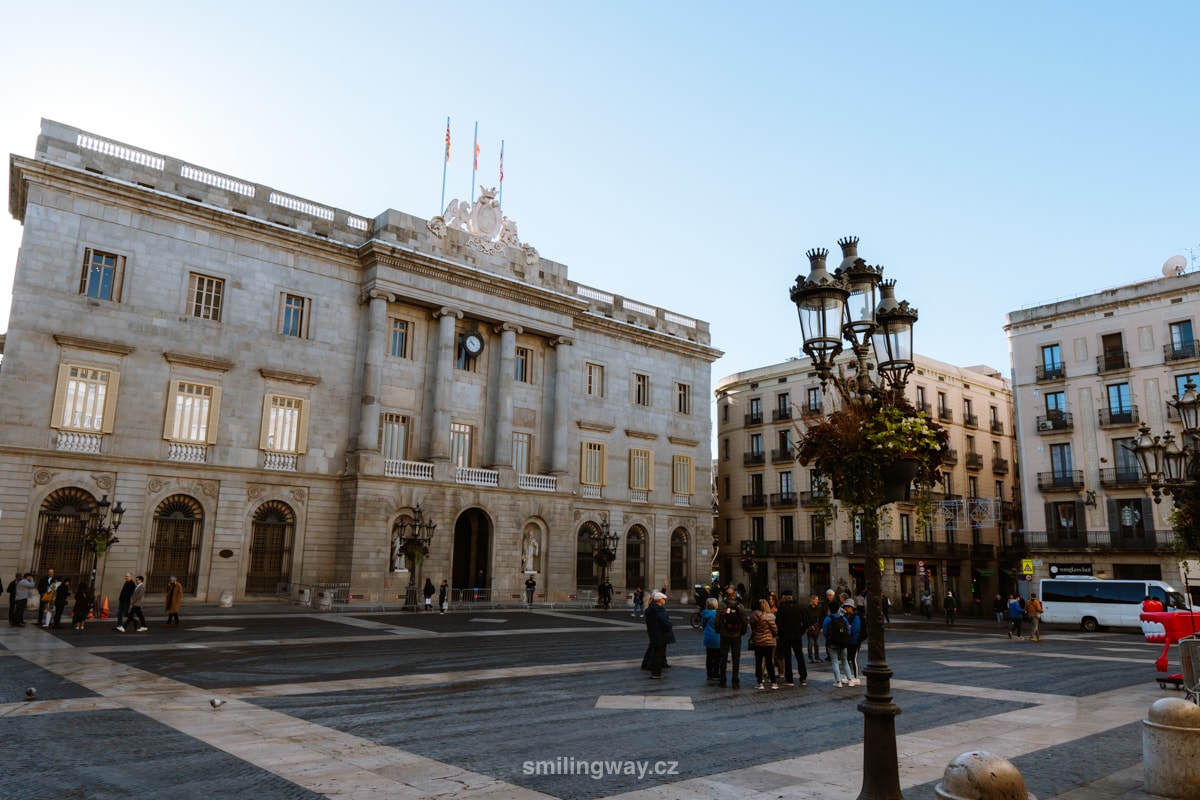
Our tips on what to see in the Barri Gotic (places in succession from Plaza Catalunya):
Wall painting Kiss of Freedom
The mural Kiss of Freedom was created in 2014 to commemorate the 300th anniversary of the Catalan surrender in the Spanish War of Succession. At first sight you see a kiss, but be sure to come closer to the painting.
It is made up of lots of little squares sent by local people. The challenge was to portray what freedom means to Catalans.
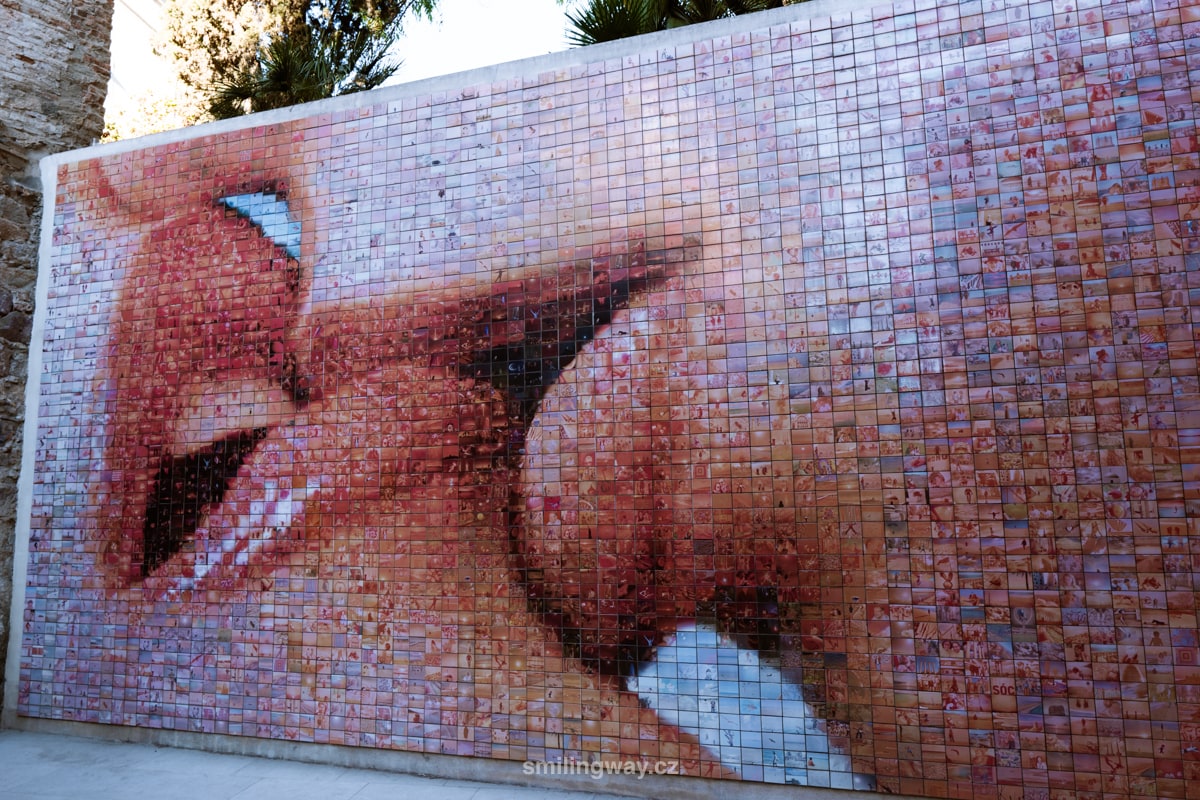
The painting is a bit tucked away, but you can get here easily. From Barcelona Cathedral, walk slightly left across the square to the cement building with Picasso’s drawings.
You will certainly recognize it among other historical houses at first sight. You will walk past the cement building through an alley to the painting, which is located behind the restaurant’s garden.
☞ Check out the description and itinerary map of how to spend 4 days in Barcelona.
Hotels in Barcelona 😴
Barcelona Cathedral
The Gothic Quarter is dominated by Barcelona Cathedral, the seat of the Archbishop, from which the cathedral takes its name. It is the only cathedral in Barcelona. Locals call it “Le Seu”.
Construction of Barcelona Cathedral began in the 4th century and continued intermittently until the 13th century. As a result, it mixes several styles, ranging from paleo-Christian foundations, Romanesque elements and Gothic facade to modernist and Renaissance stained glass.
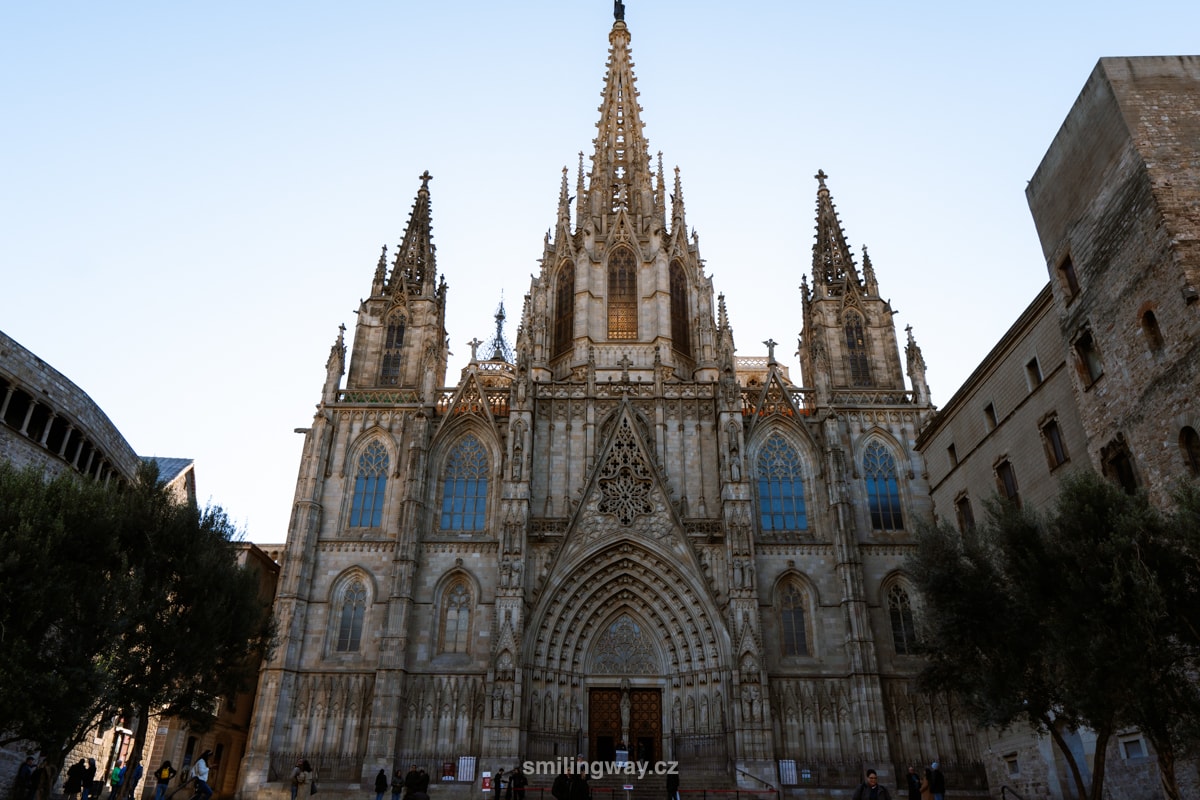
One of its most unique features is the cloister, which houses a flock of white geese that have traditionally been kept here since the Middle Ages as a symbol of purity and as a tribute to Saint Eulalia, the patron saint of the cathedral.
- Admission to Barcelona Cathedral: €9 for everyone over 12, access to the terrace for a fee
- Opening hours: Monday to Friday 9:30-18:30, Saturday and public holidays 9:30-17:15, Sunday 14:00-17:00 (last entry always 45 minutes before the end of opening hours)
Plaça de Sant Felip Neri
Plaça de Sant Felip Neri is a small square that will hit you. To get here, take the narrow alley from the cathedral – walk along the right side of the cathedral and turn right until you reach a small square with a baroque church.
On the walls you will see the remains of the Civil War bombs that killed dozens of people (mostly children who sought refuge here).
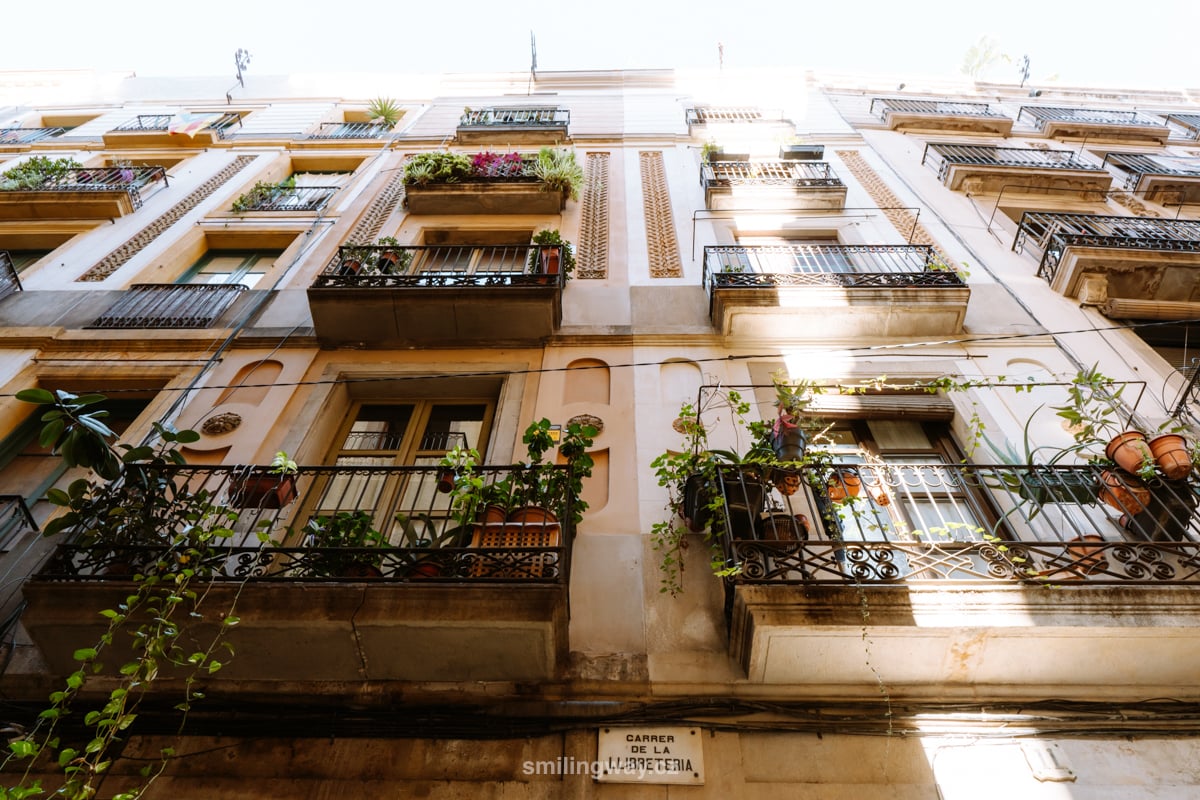
Plaça del Rei
A narrow alley leads behind the cathedral, where you turn left towards Plaça del Rei. On the square is the MUHBA, or Barcelona History Museum, where you can go underground as part of your tour. Here lies the ancient Roman town of Barcina, which once stood on the site of Barcelona.
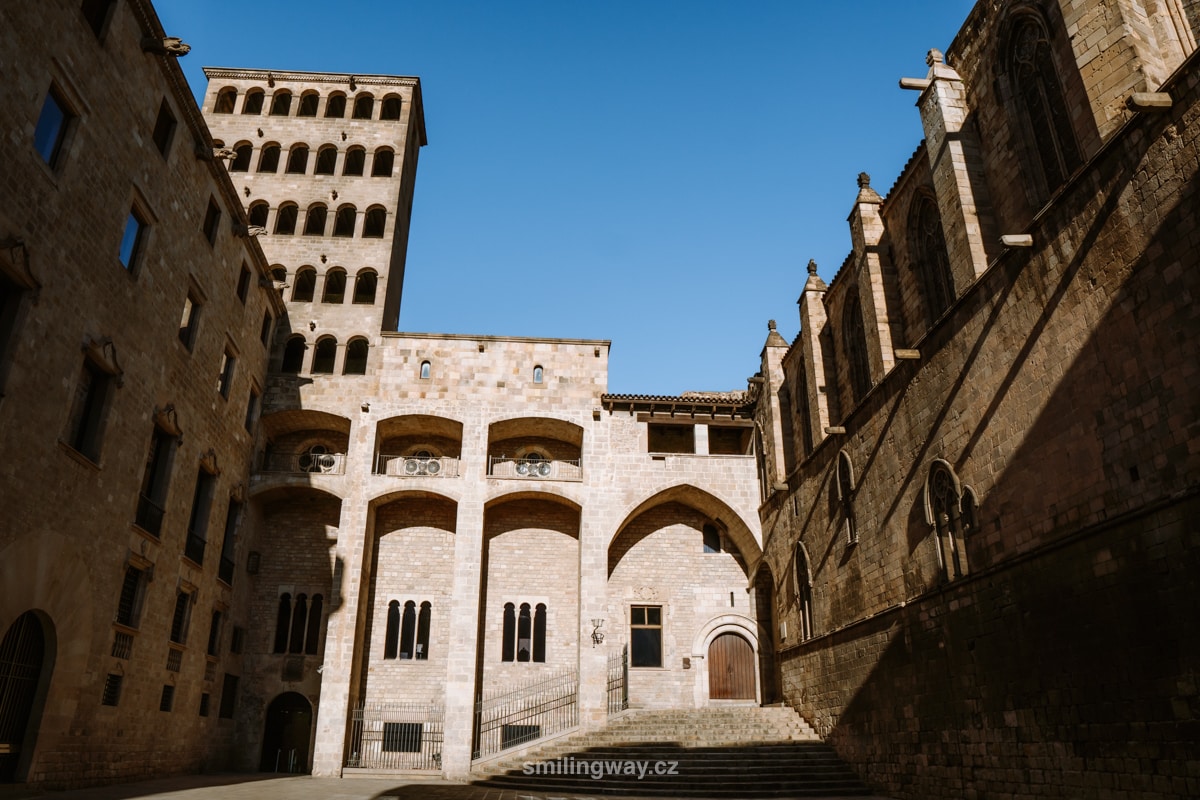
El Pond del Bisbe
From Plaça del Rei, go back behind the cathedral and follow the narrow streets to El Pont del Bisbe bridge, which connects the 2 buildings on Carrer del Bisbe. The alley leads to the open-air Plaça de Sant Jaume, home to the Catalan government and Barcelona City Hall.
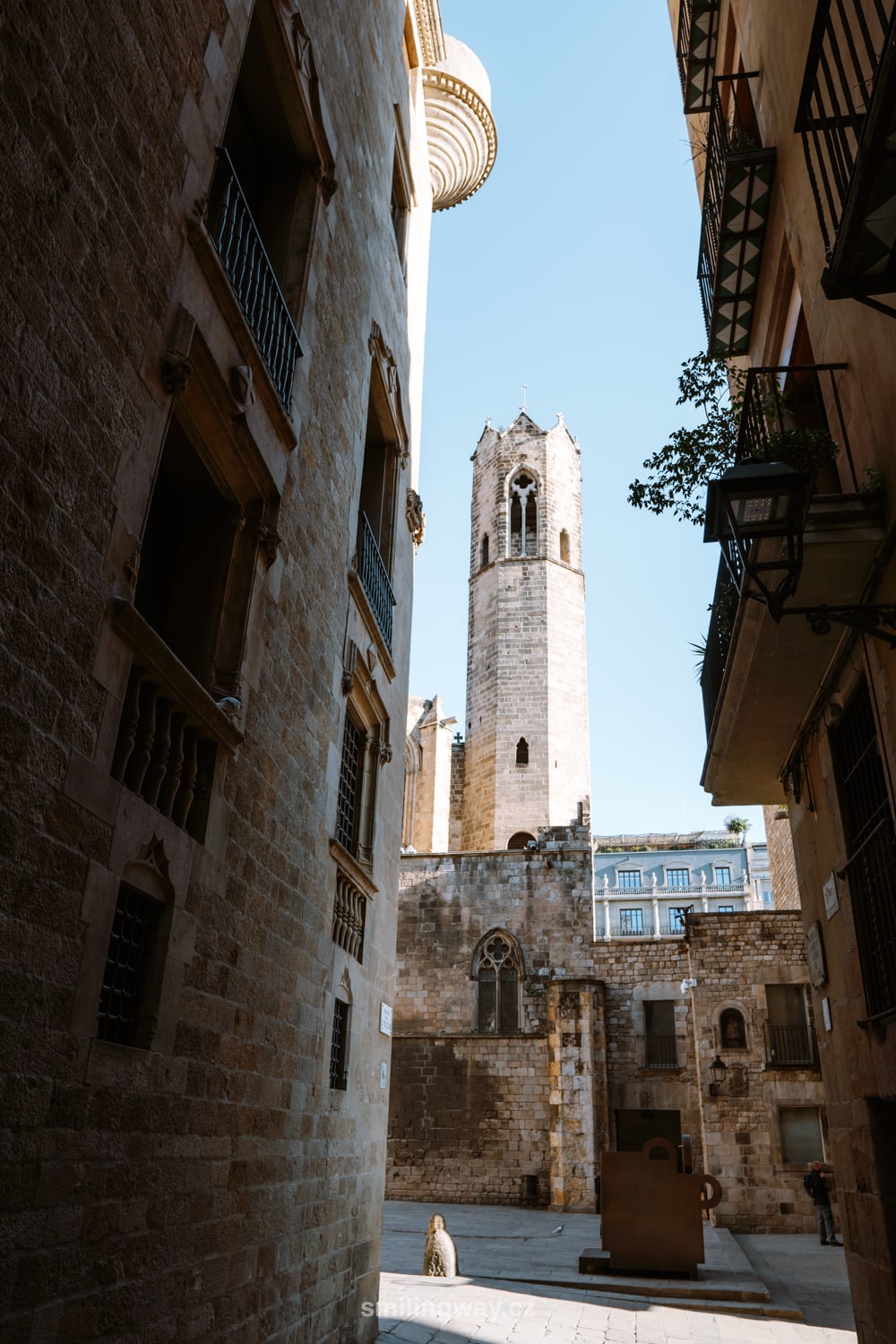
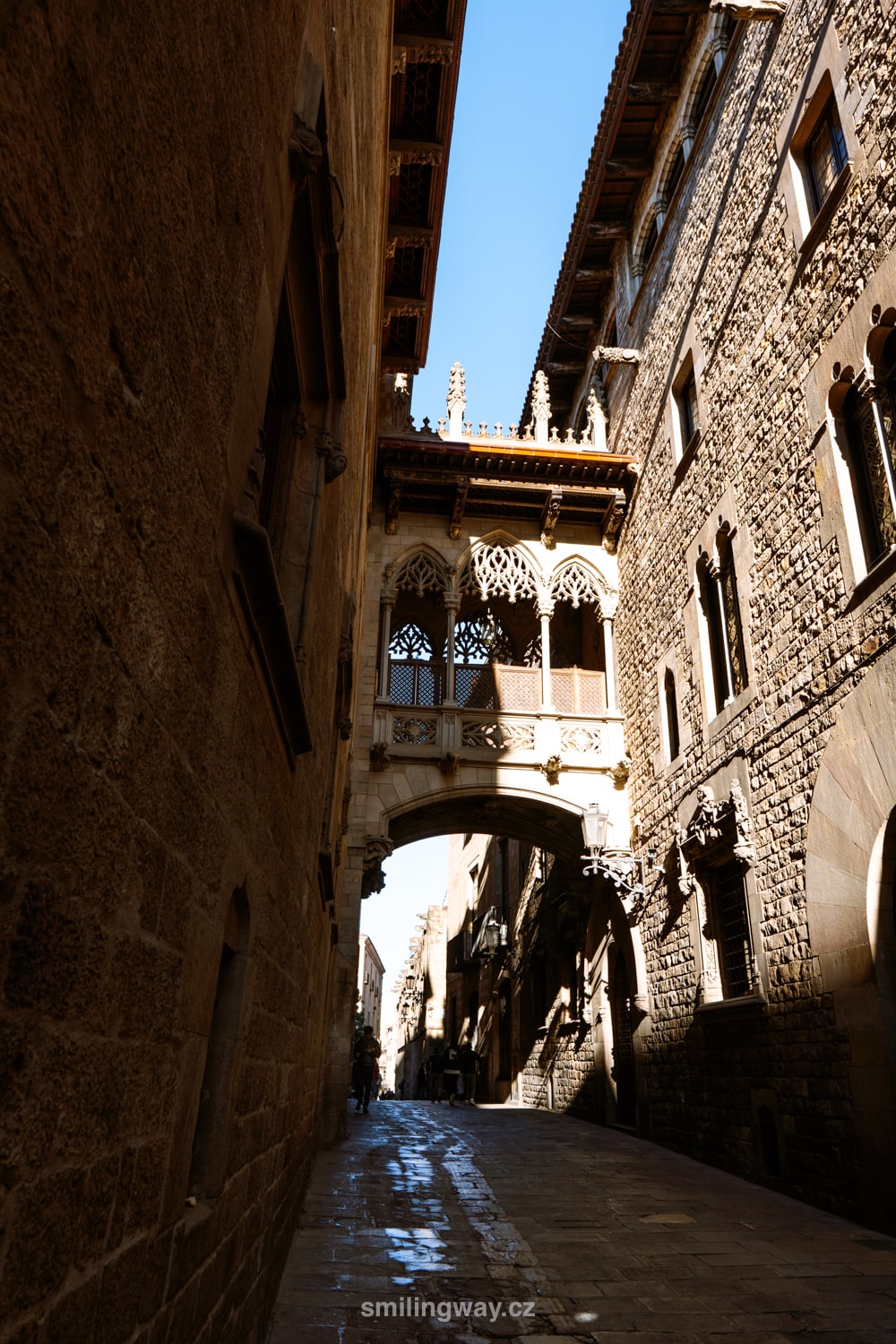
Plaça Reial
Plaça Reial is another beautiful square in the Barri Gotic, which translates to “Royal Square”. It is famous for its neoclassical columns and arches and, in the centre, the fountain of the Three Graces with 2 lanterns designed by Gaudí.
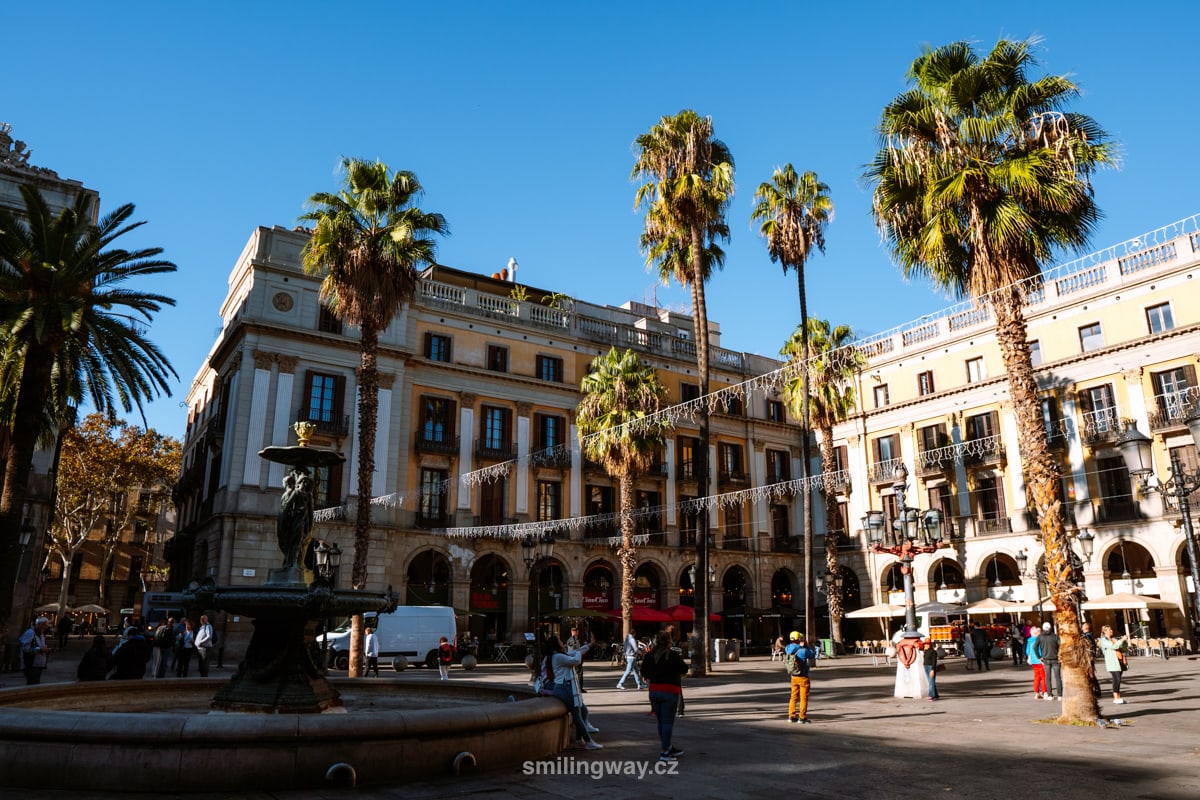
La Rambla
La Rambla is a 1.2km-long pedestrian avenue that lines Barri Gotic and separates it from El Raval.
It’s a short walk, so you can run here from Barri Gotic to La Boqueria Market, where they have plenty of food options. It’s a bit tucked away between the houses (from Plaza Catalunya on the right, about halfway down La Rambla), but you won’t miss it.
The market is very touristy, but still worth seeing and you can shop and eat well here. In summer, you can refresh yourself with fruit juices and smoothies.
☞ Here is a detailed guide on how to get from the airport to the centre of Barcelona.
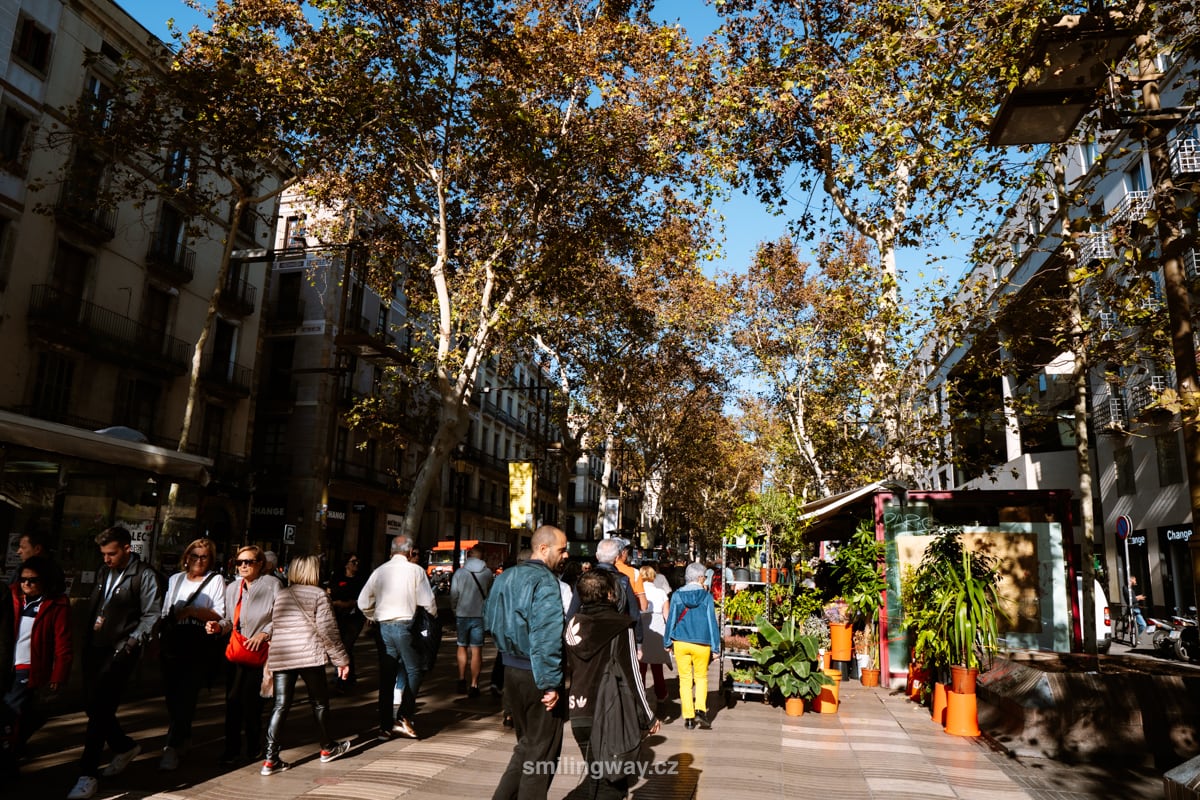
Where to eat around La Rambla
I wouldn’t recommend any other place to eat on La Rambla (one restaurant on La Rambla even “won” the title of worst restaurant in Spain). A better choice is definitely Barri Gotic, where there are plenty of more authentic restaurants (you just usually have to factor in a surcharge).
Here are some tips on where to eat in Barri Gotic:
- Colom – excellent restaurant with Spanish cuisine, often there are queues, but it is worth the wait
- Tapas bar L’Alcoba Azul
- Bodega Biarritz 1881 Tapas bar
- Tapas bar Bodega Oliva
- Irati Taverna Basca with Spanish cuisine
- Can Culleretes – one of the oldest restaurants in the city where you can taste Catalan cuisine
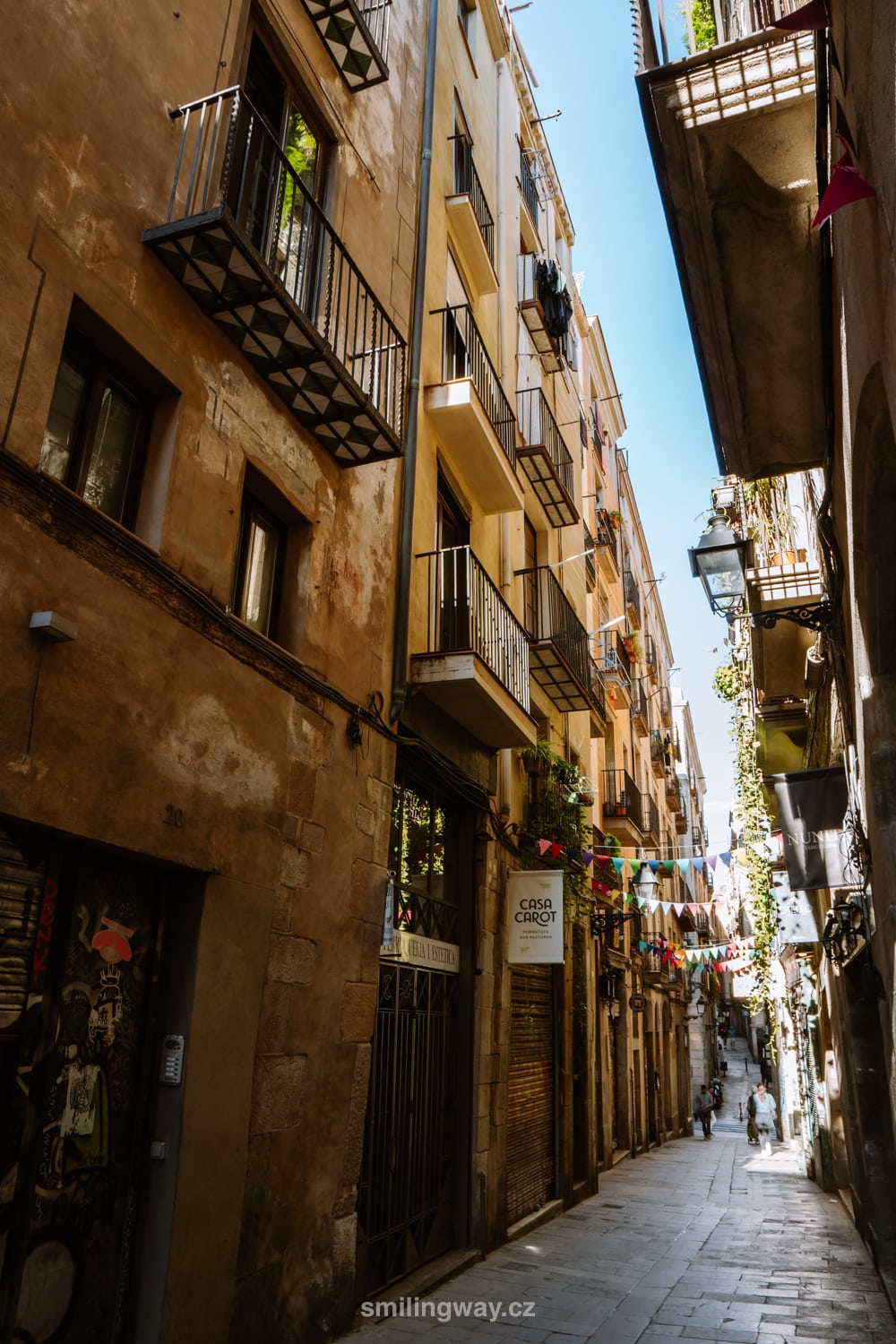
Or head to the El Raval neighbourhood, on the other side of La Rambla, for even more authentic establishments at a better price:
- Güell Tapas – there are queues, but it’s worth the wait
- Tròpico – a great place for breakfast, a small lunch or a snack during the day
- Torres del Paine – cheap but excellent restaurant with Chilean cuisine
Attractions on La Rambla
If you’re a football fan (and not a Real Madrid fan), don’t miss the Canaletes fountain right at the beginning of La Rambla.
There is a nice tradition attached to the place. The fountain used to be the home of the El Sol newspaper, and during FC Barcelona matches, fans would gather here as the newspaper announced the scores earlier. Whenever Barça wins a big prize, the fans come here to celebrate.
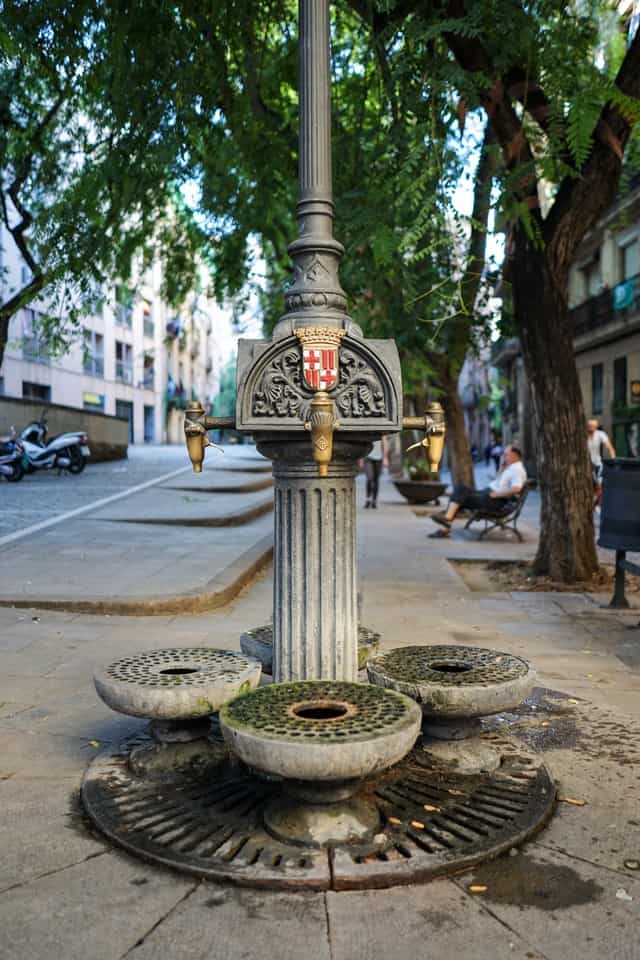
Other attractions on La Rambla include the historic Gran Teatre del Liceu opera house and the mosaic on the ground by artist Joan Miró in his signature colours (black, white, red, yellow, blue).
Otherwise, La Rambla itself didn’t impress us much. It’s a very touristy place, lots of stalls with trinkets and it lacks atmosphere.
Rambla De Mar
Walk down La Rambla towards the sea past the Christopher Columbus monument (you can go up to the viewpoint for a fee) until you reach Port Vell (Old Port), where you can walk along the waterfront promenade of Rambla de Mar.
There are benches, a pleasant seating area and at the end is a shopping centre, behind which is the the Barcelona Aquarium one of the best in Europe.
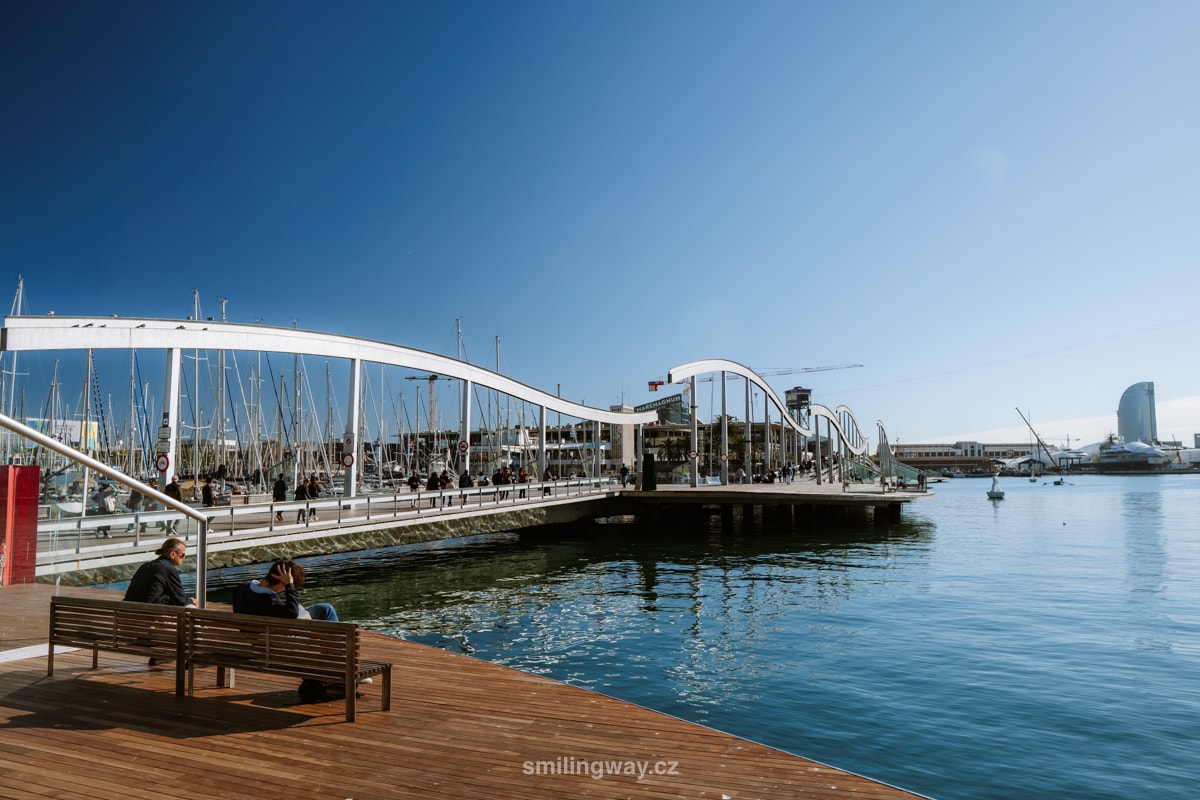
Port Olímpic
Port Olímpic was our favorite place in Barcelona. Built for the 1992 Olympic Games, the modern port is a perfect contrast to the old streets of Barri Gotic. The harbour is wedged between Barceloneta and Nova Icària beaches and in the evening it turns into a lively coastal promenade.
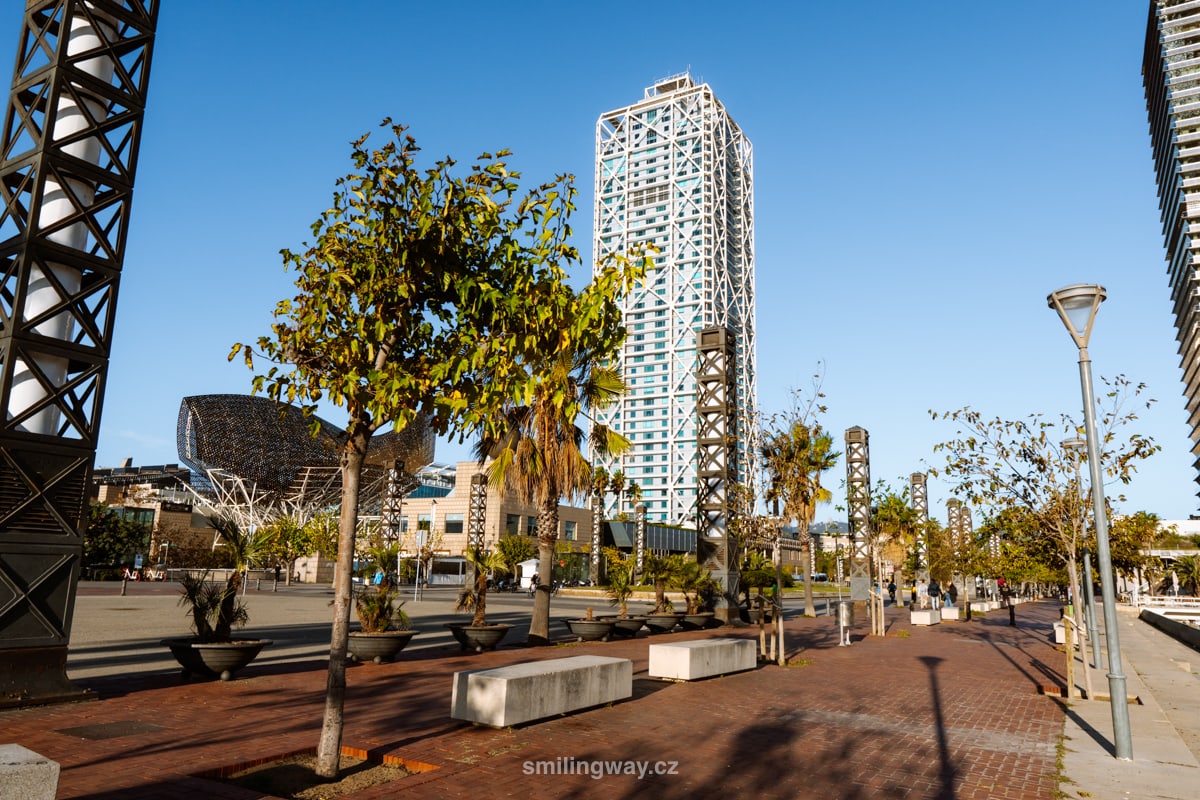
Port Olímpic is famous for its modern architecture, including the striking twin towers and the iconic Frank Gehry sculpture “Peix d’Or”, which resembles a glittering fish and has become a landmark of the area.
During the day, it is the ideal place for leisurely walks and sunbathing on the nearby beaches. In the evening, enjoy delicious food and the lively atmosphere of the modern marina.
☞ Read our detailed guide on best things to do in Barcelona (entrance fees, opening hours, how to get around).
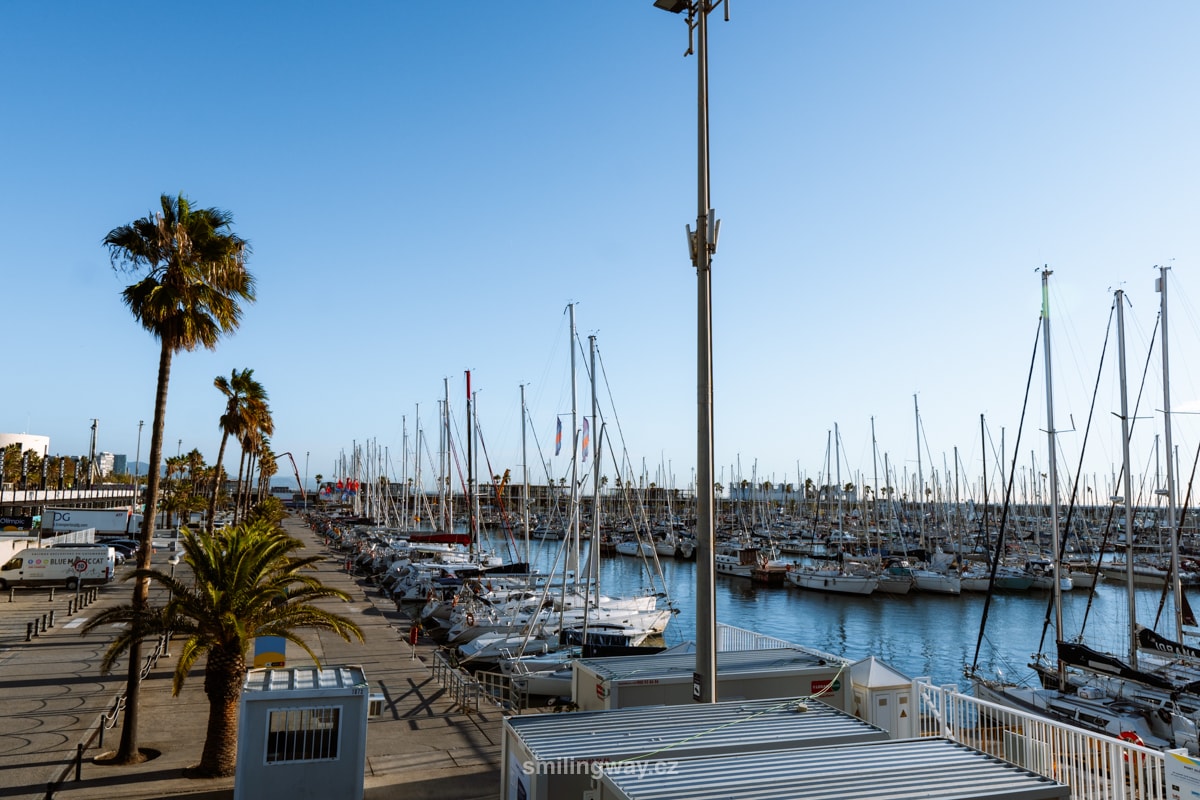
BARCELONA IN 3 DAYS: Park Güell and Montjüic
Itinerary for Day 3 in Barcelona
- Park Güell
- Palau de la Musica Catalana or Casa Vicens
- Spanish Square
- Montjüic
Park Güell
Park Güell is located on the northern edge of Barcelona in the Gràcia district on a hill, so you won’t miss the slight climb. Once you’re near Park Güell, it’s easy to find your way around the other visitors heading to the park.
Park Güell was built as a home for the Guell family and several other wealthy families. But it was never fully completed and ended in failure because Barcelona’s elite did not want to move out of the city centre. In 1922, Park Güell was opened to the public.
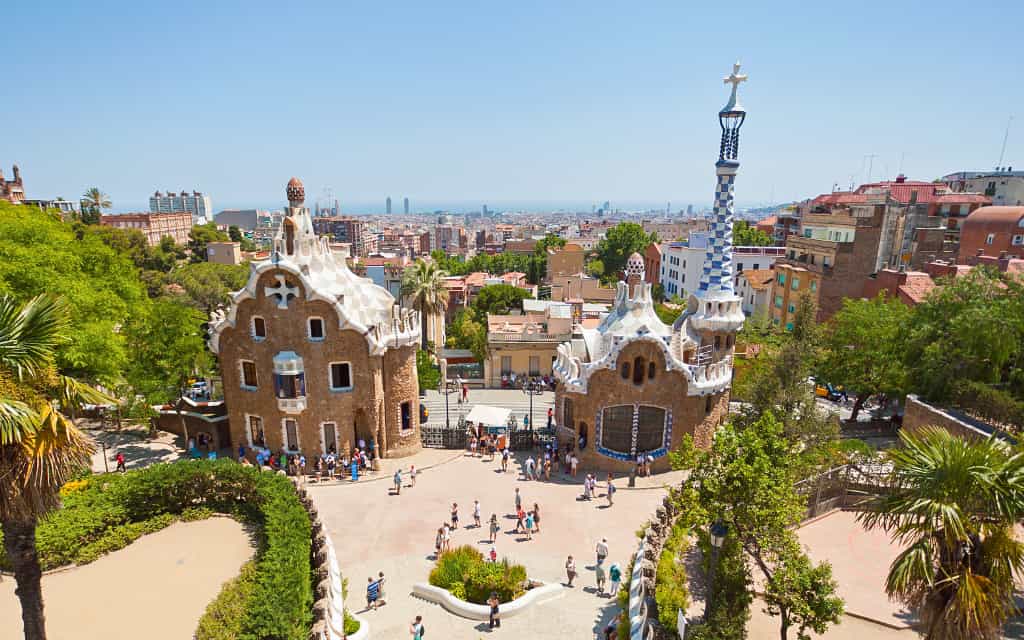
For decades you could come here for free, but in recent years it has been so well attended that it has had to limit visitor capacity and introduce an admission fee to discourage crowds.
The park is divided into two zones – the monumental zone, which is a UNESCO World Heritage Site and contains Gaudí’s work, and the public zone, which is wooded and is more of a classical park.
Right at the entrance there is a statue of a lizard and a cottage, which look like a fairy tale about a gingerbread house with candy coating on the roof. The park then hides other beautiful places, such as a huge hall of columns reminiscent of a petrified forest or a terrace with benches covered with colourful mosaics and a view of the city. In the middle of the park is the pink house where Gaudí once lived.
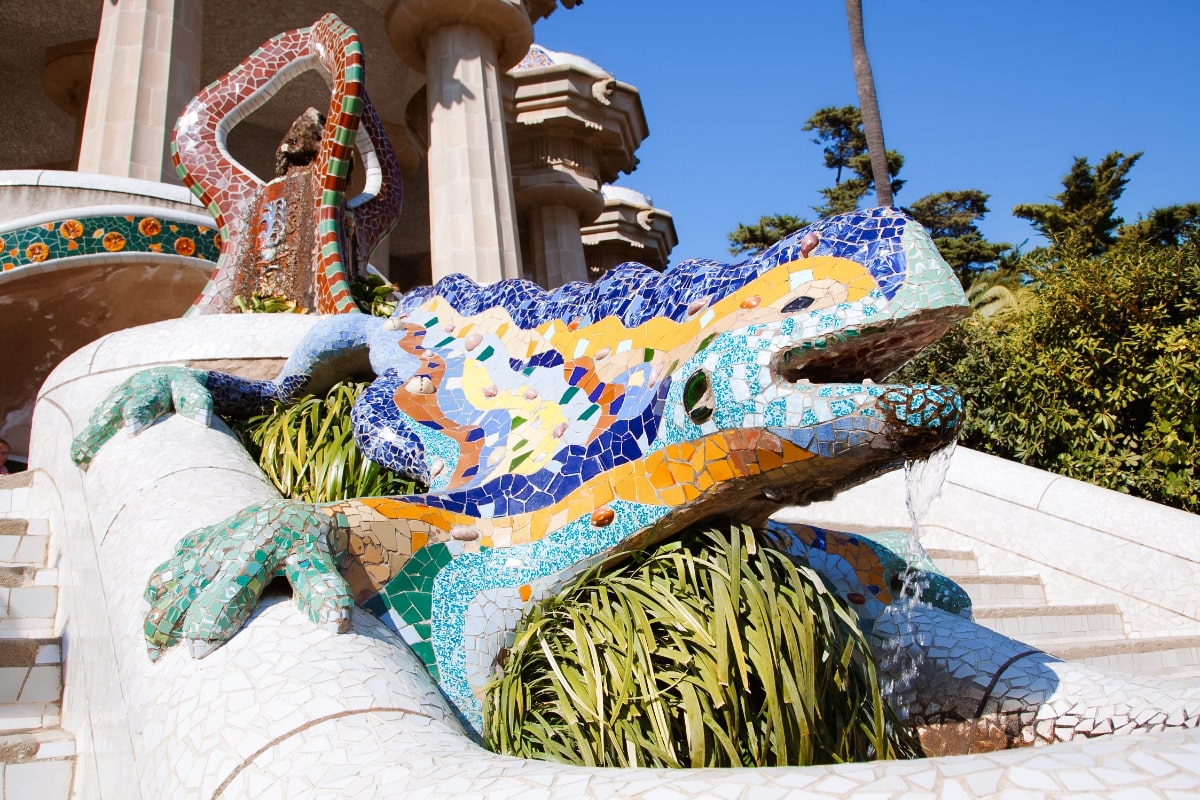
How to skip the lines for Park Güell?
Park Güell is one of the places in Barcelona where you’ll be glad you booked your tickets in advance. Lines here are long and capacity is limited, so you won’t always get to see everyone.
It is common for people to walk away because all the tickets are sold out for several times or even days in advance. When booking, you choose a specific time with a time window of half an hour, i.e. if you choose 14:00, you must arrive between 14:00-14:30.
The best time to visit is early in the morning, when there are the fewest people and you won’t be crowded with other tourists at the most popular places. Later on, crowds will pile in and the overall impression of the park may be disturbed.
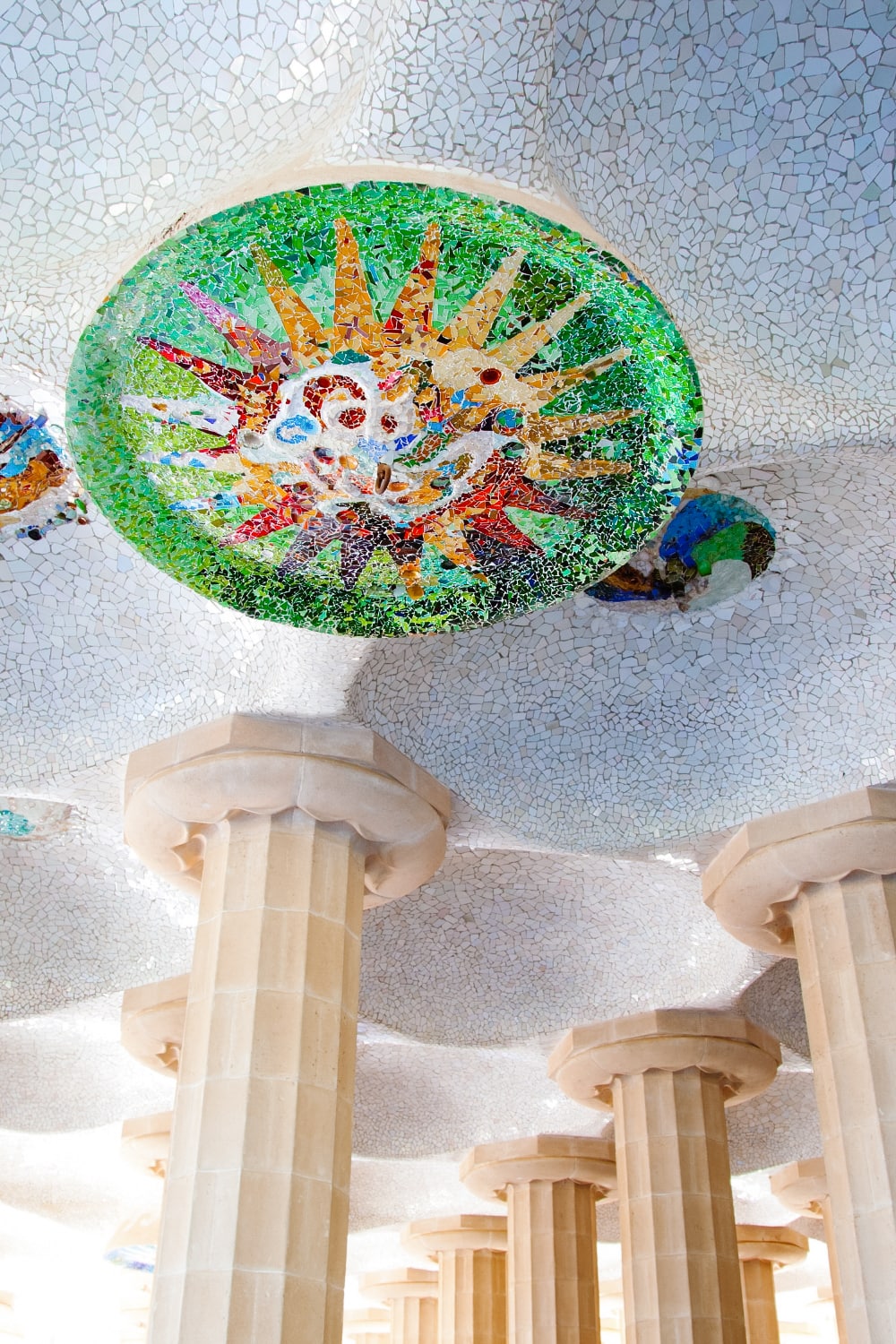
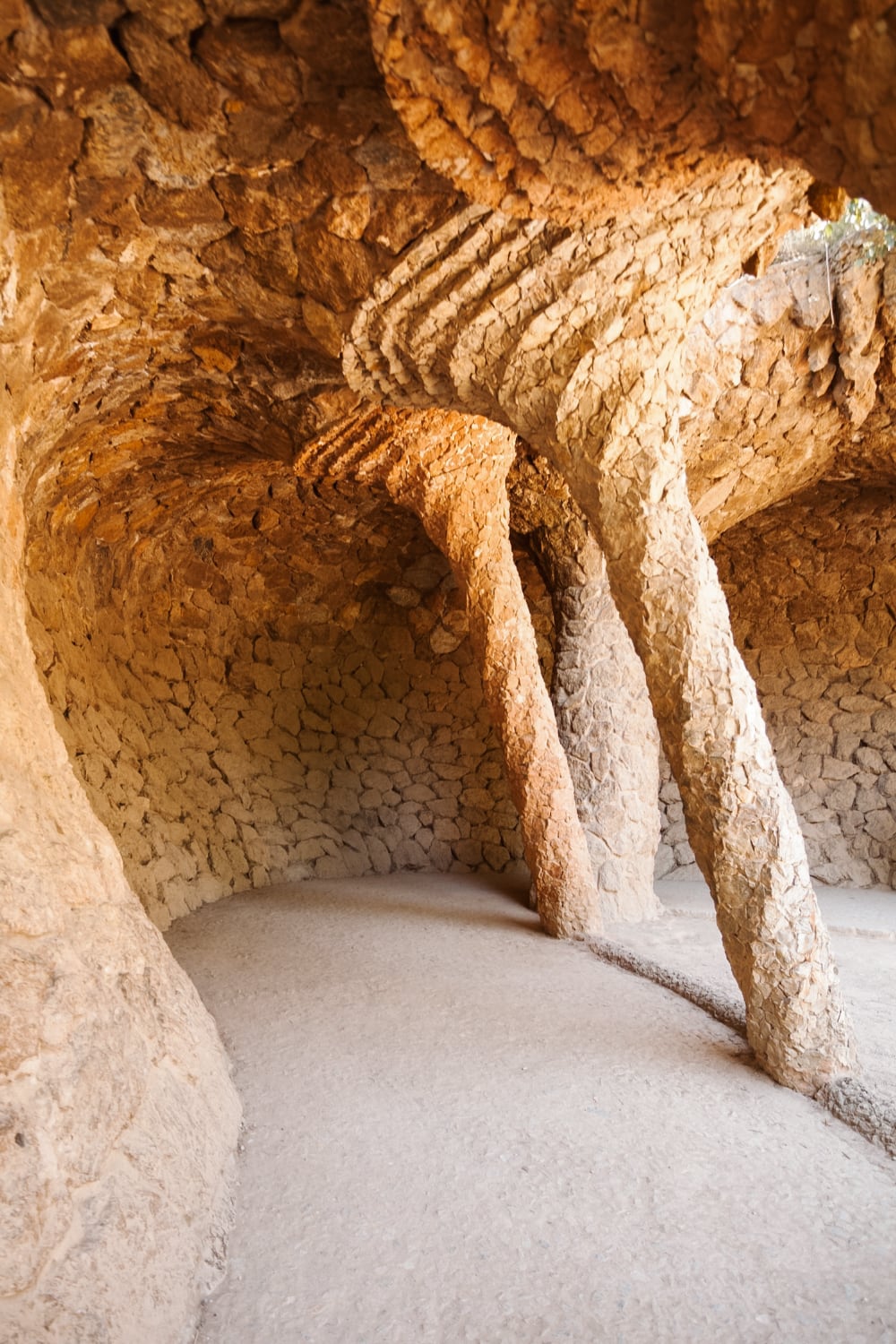
What are the entrance fees and opening hours for Park Güell?
Full admission to Park Güell is €13 and reduced admission is €9.50 for children aged 7-12 and seniors over 65. Children up to 6 years of age are admitted free of charge.
Open daily 9:30-19:30. I don’t recommend buying tickets for the evening when it’s already dark – the park is not very well lit.
☞ Book your Park Güell tickets here.
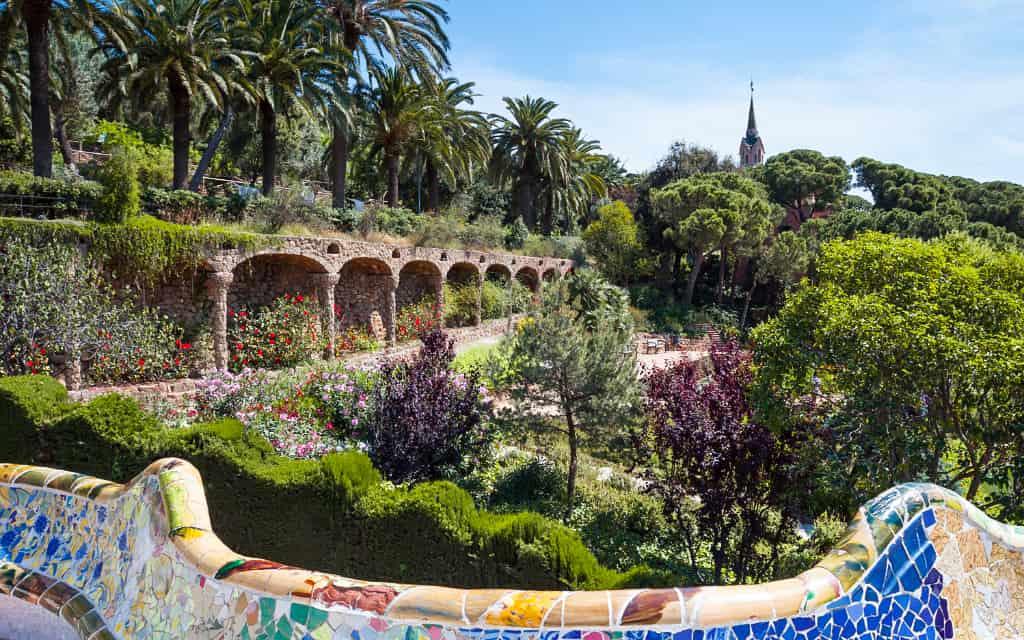
How to get to Park Güell?
- Metro: The easiest way is to take the Barcelona Metro. The nearest metro stations are Vallcarca and Lesseps on the L3 line (green line) – I recommend Lesseps with the exit to Avinguda del Santuari de Sant Josep de la Muntaya, where there are escalators. From both of these stations, it is about a 15-20 minute walk to Park Güell, with some uphill sections. Signposts mark the way to the park.
Bus: Another convenient option is the bus. Bus lines 24, 92, H6 or D40 stop near the park. Specifically, lines 24 and 92 offer stops near the main entrance.
Palau de la Musica Catalana
Palau de la Música Catalana is a modernist building designed by architect Lluís Domènech i Montaner, which functions as a concert hall. It is the only concert hall in the world to be listed by UNESCO.
The building will captivate you from the outside, but once you step inside, the real show begins. The Palau de la Música Catalana is opulent, ornate and perhaps even kitsch.
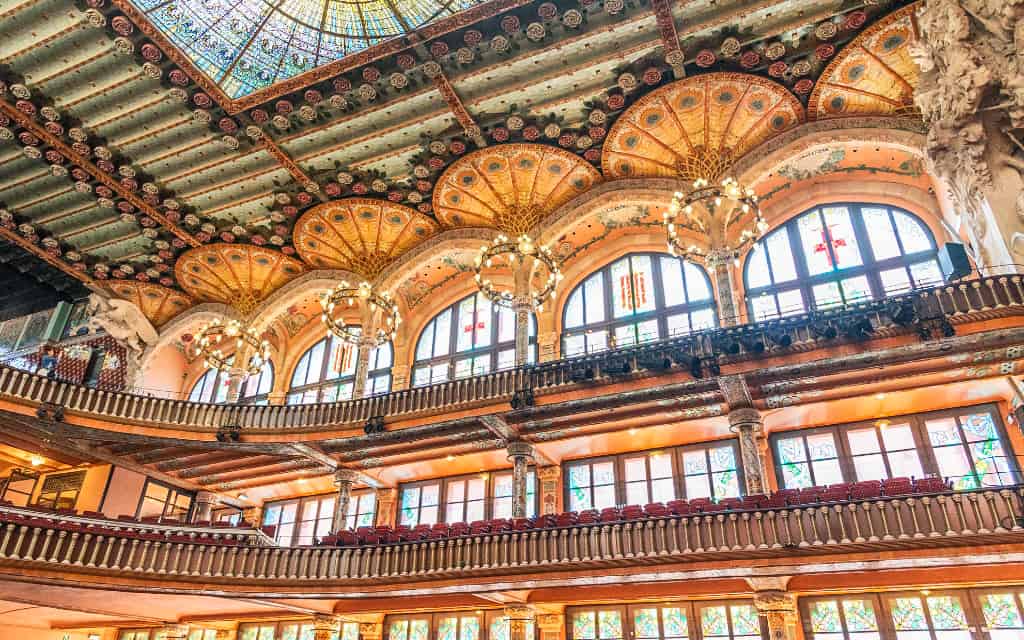
It has beautiful stained glass windows and a teardrop-shaped main auditorium skylight that uses all the colours of the rainbow to let in daylight. These are just some of the magnets that make the Palau de la Música a UNESCO World Heritage Site.
In addition to attending the performances, you can take an unguided tour or a guided tour that will point out the most beautiful details.
Opening hours: Palau de la Música Catalana operates as a concert hall, so opening hours for tours are limited to 9:00-15:30.
How much is the entrance fee to the Palau de la Música Catalana: Full admission costs €18. Book tickets with an audio guide here. The second option is guided tour which can also be enjoyed by those who prefer unguided tours. With a guide, you can get to places where entry is normally forbidden.
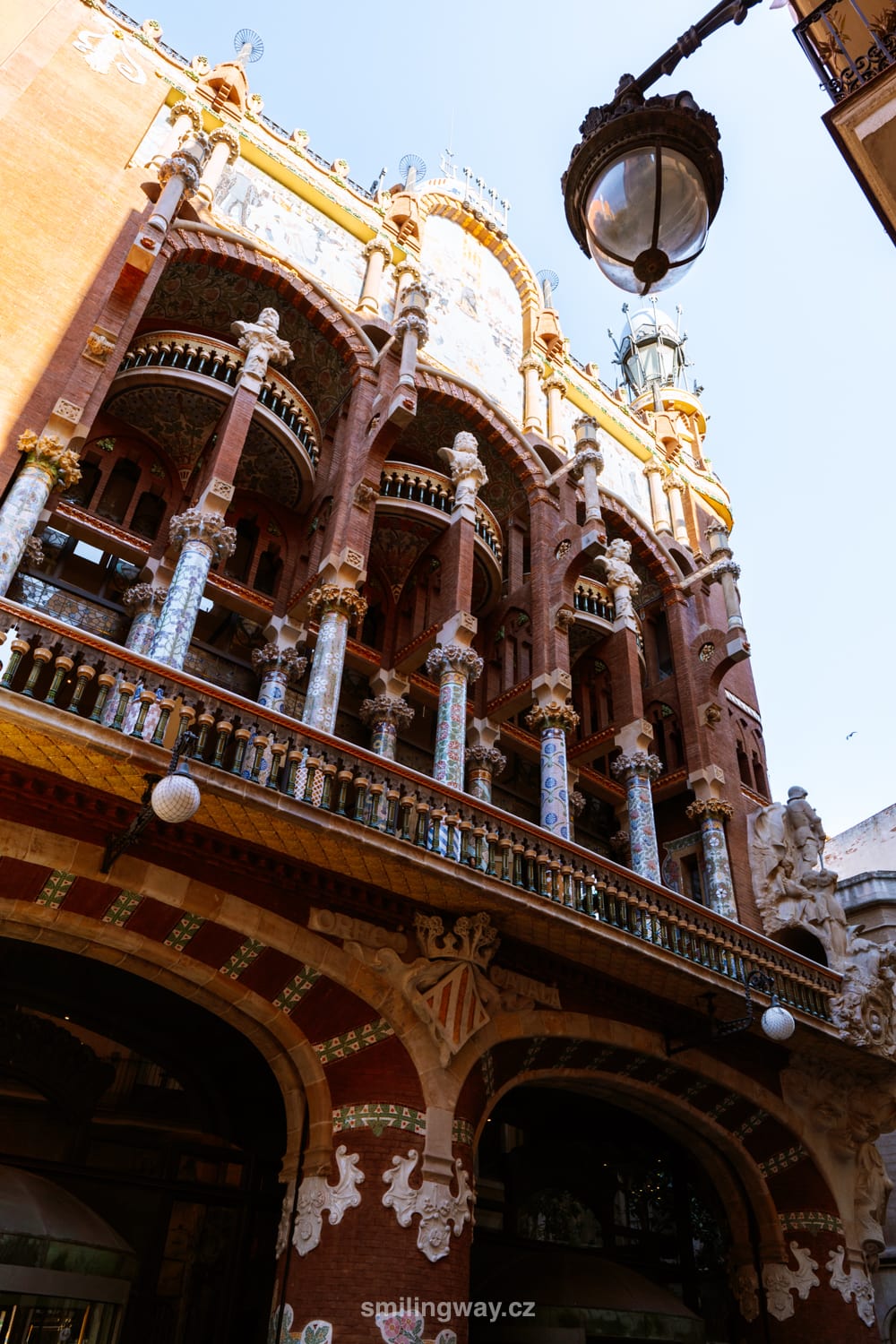
Casa Vicens
An alternative to Palau de la Música Catalana is Casa Vicens.
Casa Vicens probably doesn’t spring to mind when most visitors think of Gaudí’s works, but that’s a great pity. Casa Vicens is Gaudí’s first work, it is lively, playful and has a strong Moorish influence. We liked it very much.
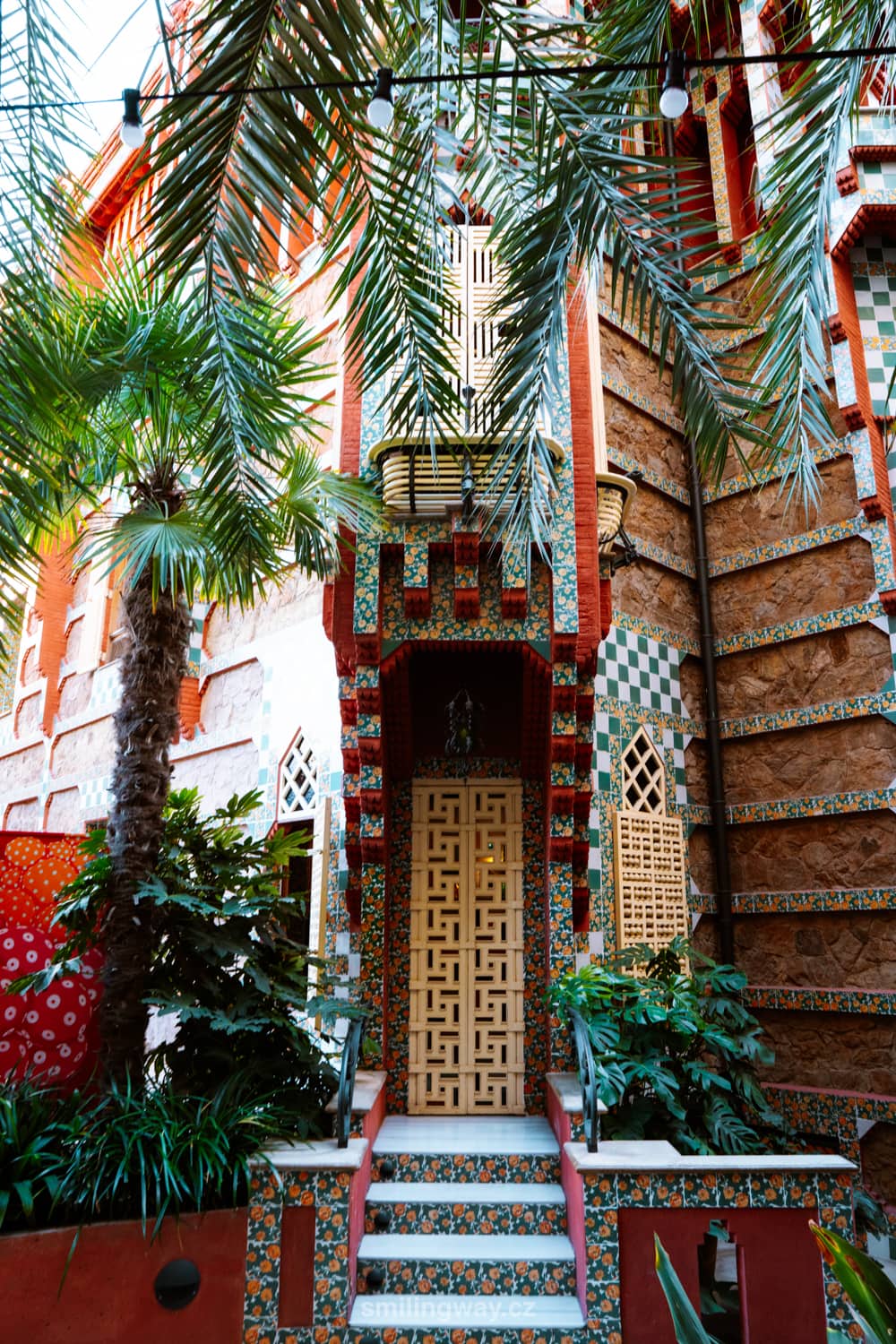
It is surrounded by a small garden with a fountain, which can only be accessed by paying an entrance fee. You can climb up to the roof and enjoy the view of the rooftops of Barcelona.
The building has mosaic floors, colourful tiles and stained glass windows. It only became available to the public in 2019 and has been growing in popularity ever since.
How to get in: The nearest metro station is Fontana (line L3), from where you go slightly uphill. After 5 minutes, turn left, where Casa Vicens is on your right.
Opening hours: April-October daily 10:00-20:00, November-March Monday 10:00-15:00 and Tuesday-Sunday 10:00-19:00
How much is the entrance fee to Casa Vicens: Tickets are cheaper if booked in advance (full admission €18) – Book tickets for Casa Vicens.
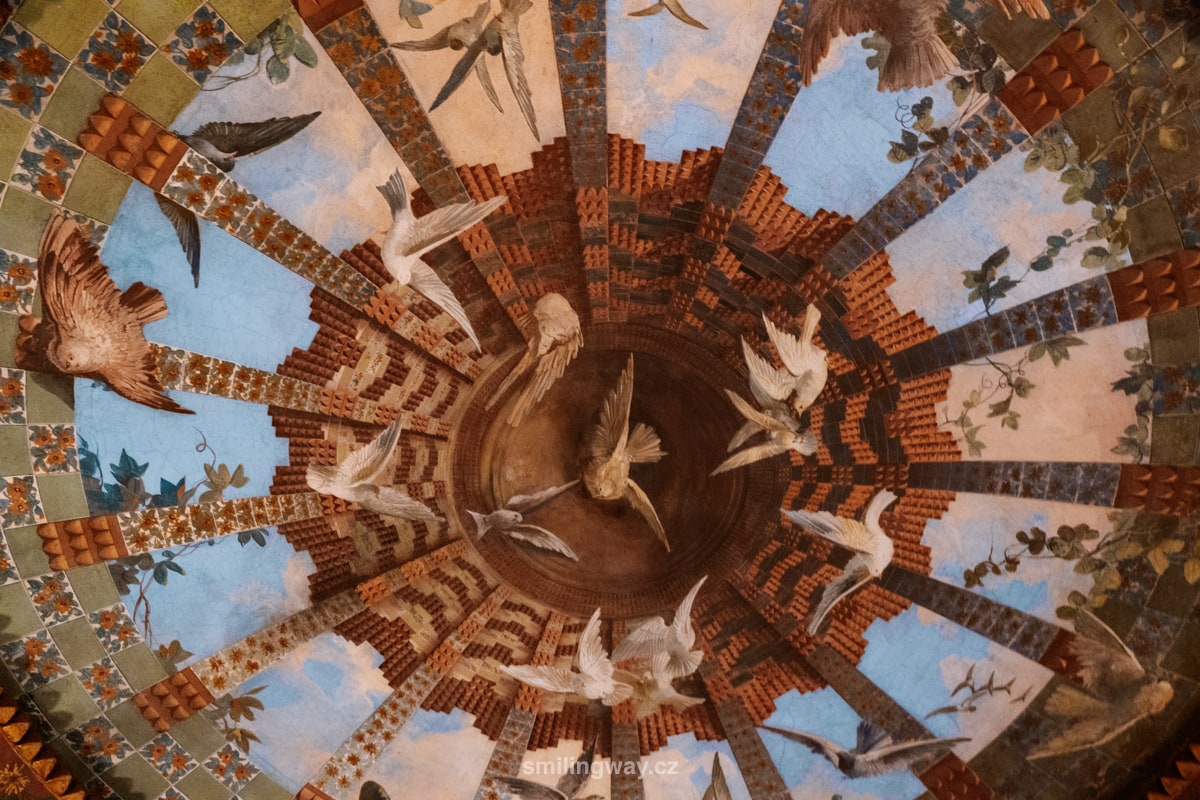
Plaça d’Espanya
Plaça d’Espanya is a busy square and important transport hub in Barcelona, built for the 1929 International Exhibition. It is dominated by the great Venetian towers, which serve as the gateway to the Montjuïc Exhibition Grounds.
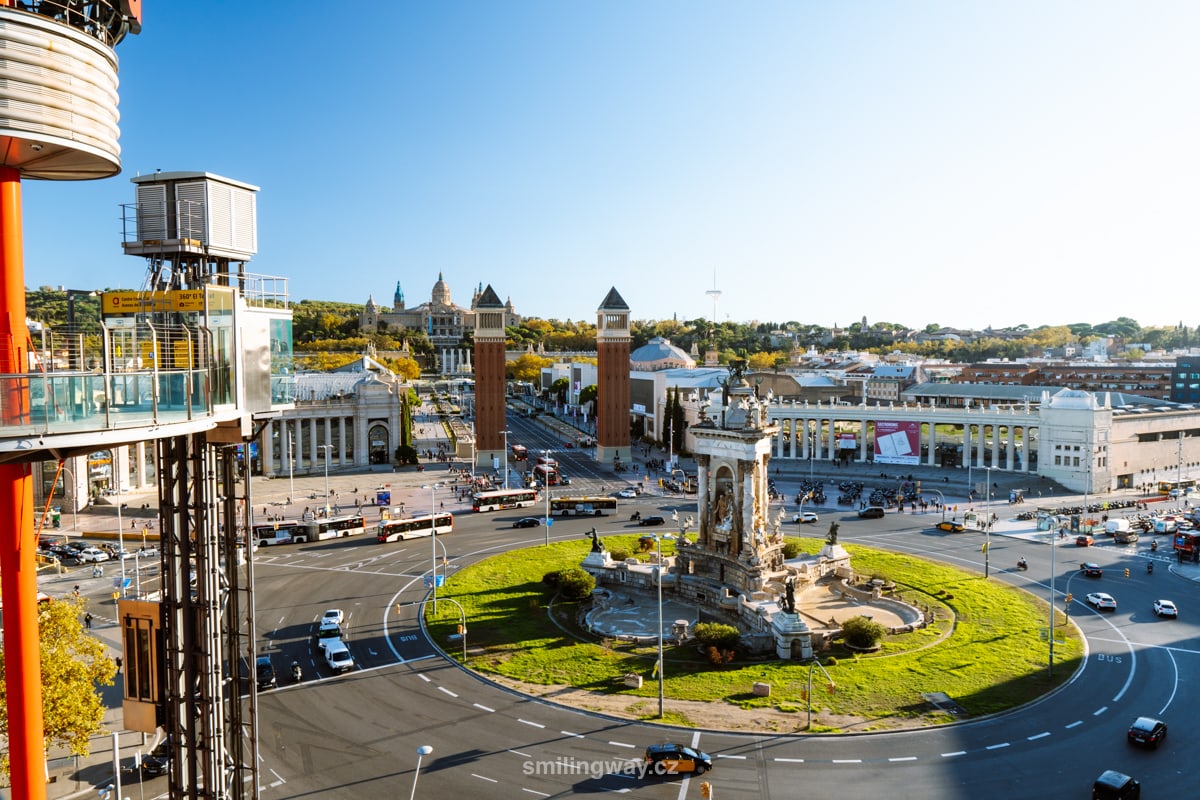
Here you will find a former bullring that has been converted into a shopping mall. You can walk up through the shopping centre (or take the glass elevator from the outside for €1) and admire the surroundings for free.
☞ Read our complete guide to transport in Barcelona.
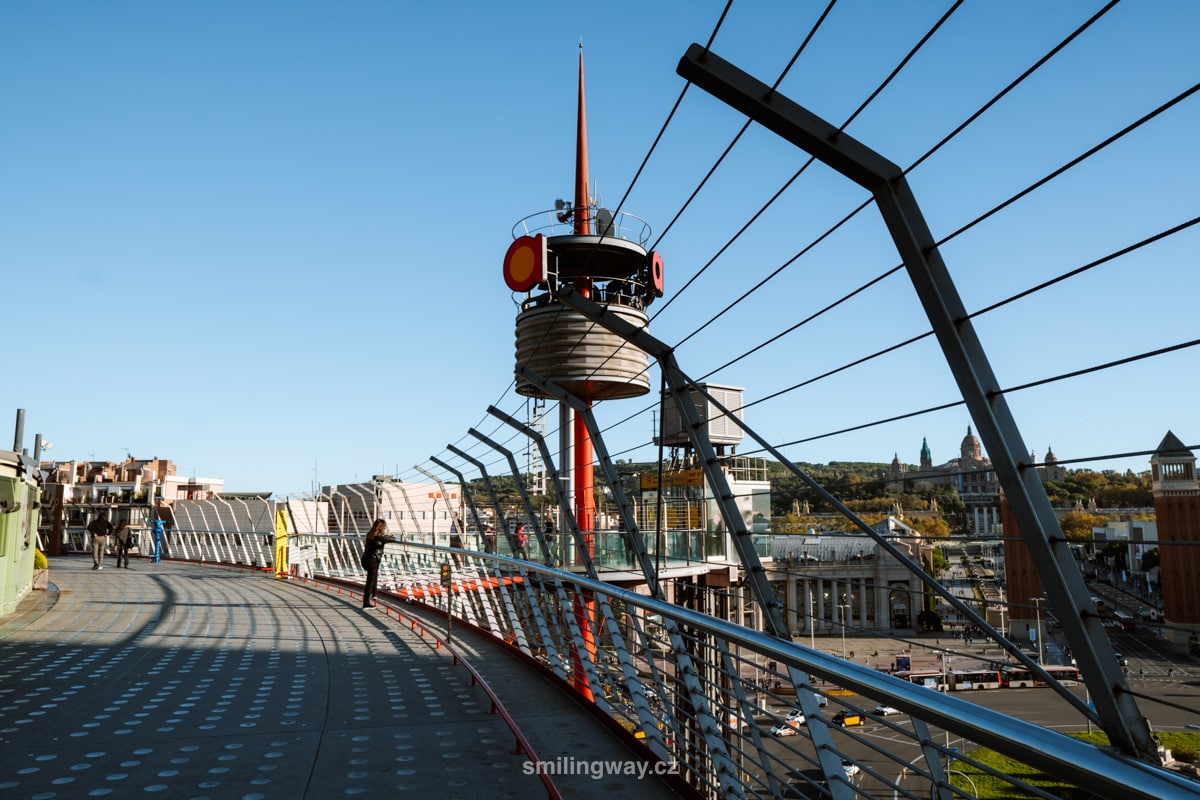
Montjuïc
From Plaça d’Espanya, we head to the imposing Venetian towers of Torres Venecianes, which form the imaginary entrance to Monjüic Hill. It’s really big and you can easily spend the whole day here – here are the highlights of what you can see in Monjüic:
National Museum of Catalan Art
The first museum in sight is the National Museum of Catalan Art (Museu Nacional d´art de Catalunya), MNAC for short. This must be on the list of anyone who wants to learn more about Catalan history and admire one of the largest Romanesque collections in the world.
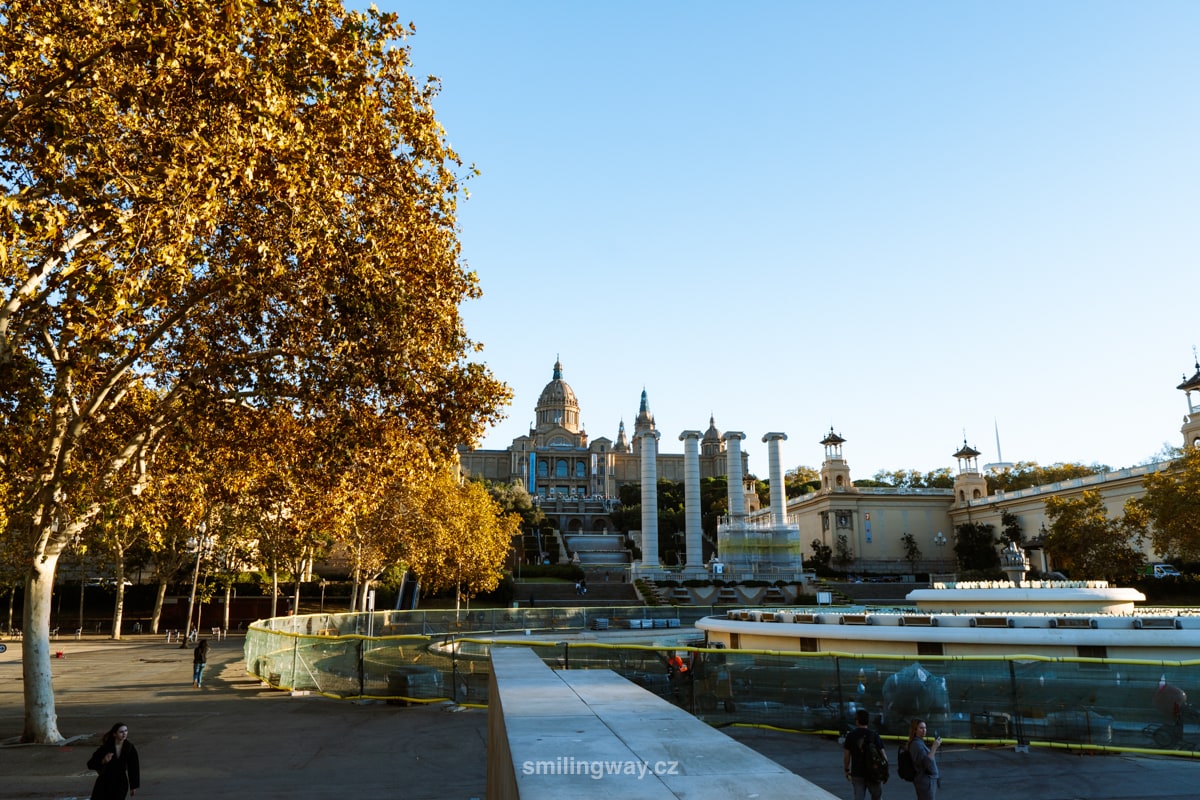
- Admission: Basic admission including the terrace costs €12, only access to the palace and the terrace without the museum costs €2, under 16 and over 65 free admission
- Opening hours: From May to September Tuesday-Saturday 10:00-20:00 and Sunday and public holidays 10:00-15:00, from October to April Tuesday-Saturday 10:00-18:00 and Sunday and public holidays 10:00-15:00
- How to get there: Metro station Espanya (lines L1, L3 and L8) and from there a few minutes towards Montjuïc hill
Directly below the MNAC Museum is the Magic Fountain, where a sound and light show takes place in the evening. Specific times the fountain plays vary by season – click for current times. I recommend arriving a little early as it gets really crowded, so make sure you get a good view.
Please note: Due to water problems in Barcelona, the Magic Fountain is currently out of service as of 2023.
Instead of the fountain, you can walk through the beautifully landscaped gardens that cover the slopes of Montjuic.
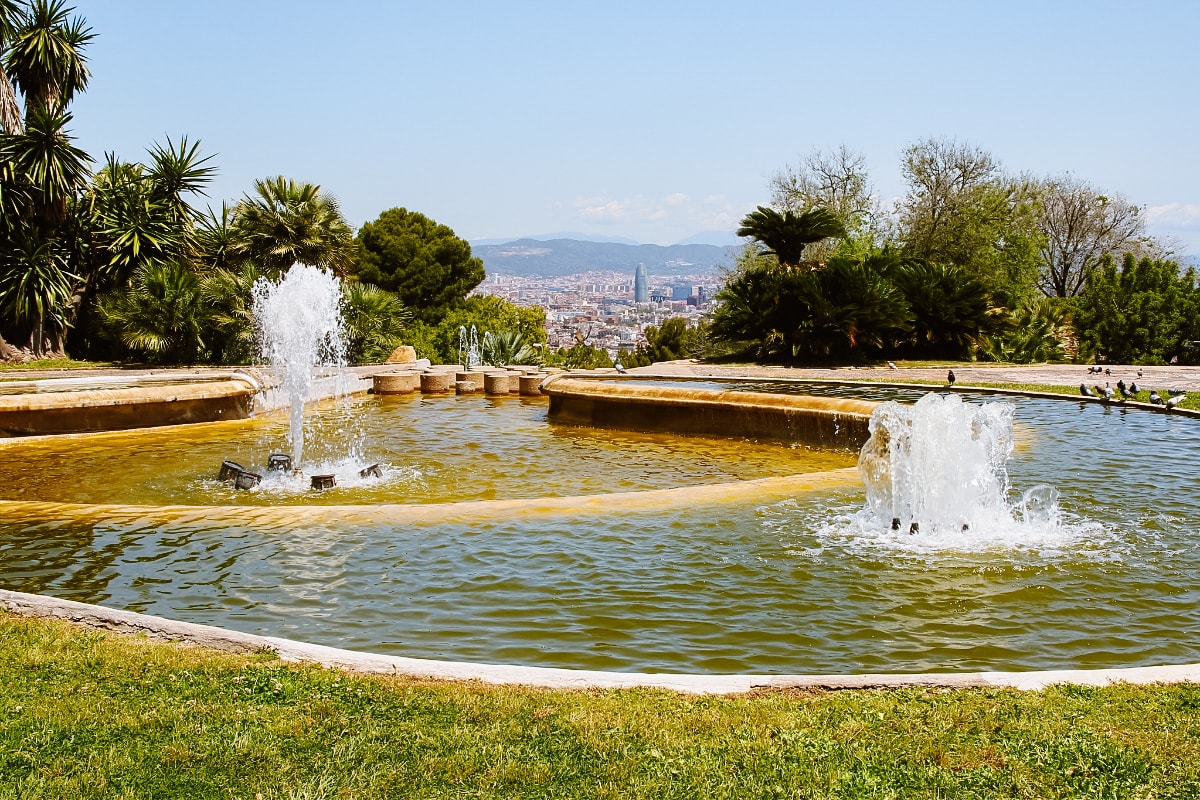
Fundació Joan Miró
A short walk from the National Museum of Catalan Art is another popular museum, the Fundació Joan Miró, where the best collection of Catalan abstract artist Joan Miró awaits you. It is housed in a white modernist building and, in addition to its colourful collection, offers great views of Barcelona.
Don’t miss the Tapis de la Fundacio tapestry, which measures 7.5m2 and weighs a ton.
- Admission: full admission €13 for all over 15 years, children under 14 free
- Opening hours: closed Monday, Tuesday-Saturday 10:00-20:00, Sunday 10:00-18:00
- How to get there: metro station Paral-lel (lines L2 and L3) and from there take the funicular (same fare as the metro) or walk (about 20 minutes)
☞ With the Hola Barcelona tourist card you can enjoy unlimited public transport throughout Barcelona – the card is valid for the metro, buses, trams, trains, the Montjuic funicular and transport to and from the airport. The card is available for 48 to 120 hours and can be activated simply with the first use.
The alternative is Barcelona Essentials Pass which includes unlimited free transport and entry to 2 of Barcelona’s most popular attractions – the Sagrada Familia and Park Güell.
Poble Espanyol
Poble Espanyol is another place you will find on Montjüic. It is an architectural museum and open-air museum that represents a typical Spanish village. In one place you can see all the different areas of Spain.
The site was created for the Barcelona International Exhibition in 1929, but it became so popular that it was preserved.
In the evenings it comes alive with restaurants and bars. During the day you can visit craft workshops and small shops.
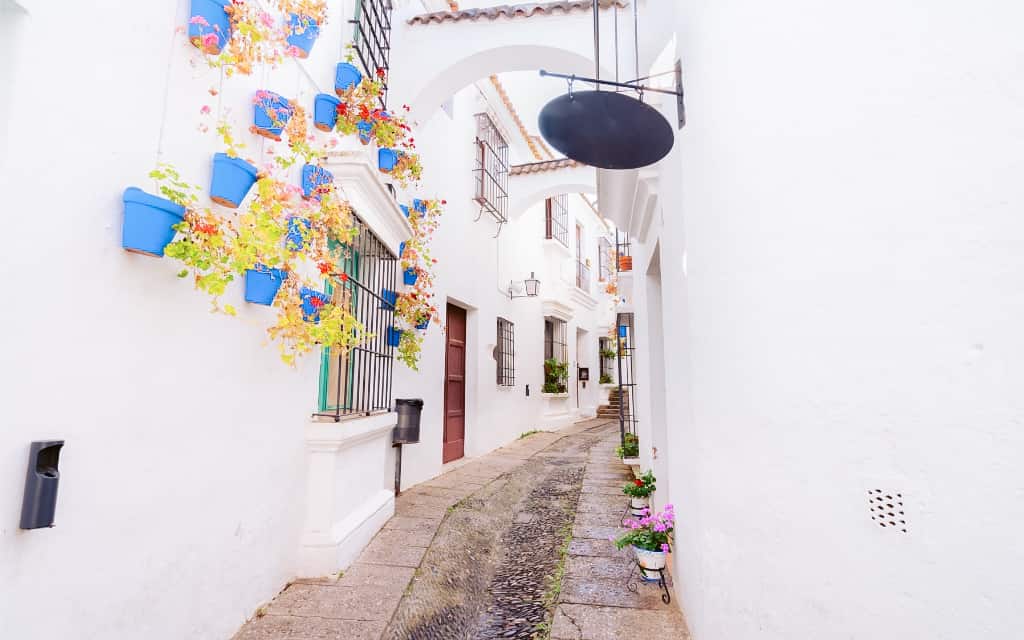
How to get to Poble Espanyol: Poble Espanyol is located at the foot of Montjuïc hill, about 10 minutes walk from Plaza España (metro lines L1 and L3). You can also get directly to the entrance by bus (line 150 goes from the Spanish Square).
Opening hours: Poble Espanyol is open Monday 10:00-20:00 and Tuesday-Sunday 10:00-00:00.
How much is the entrance fee to Poble Espanyol: Full admission is €13.50 for anyone over 13 – tickets are more expensive on site. Book your tickets here.
Montjüic Fortress
The Montjüic Fortress and Castle is located at the top of the hill, offering a spectacular view of Barcelona. The fortress was built in 17th century, when a small fortress and a watchtower were built here for the defence of the town. Centuries later, after the War of Succession, it was rebuilt into the stronger fortress it is today.
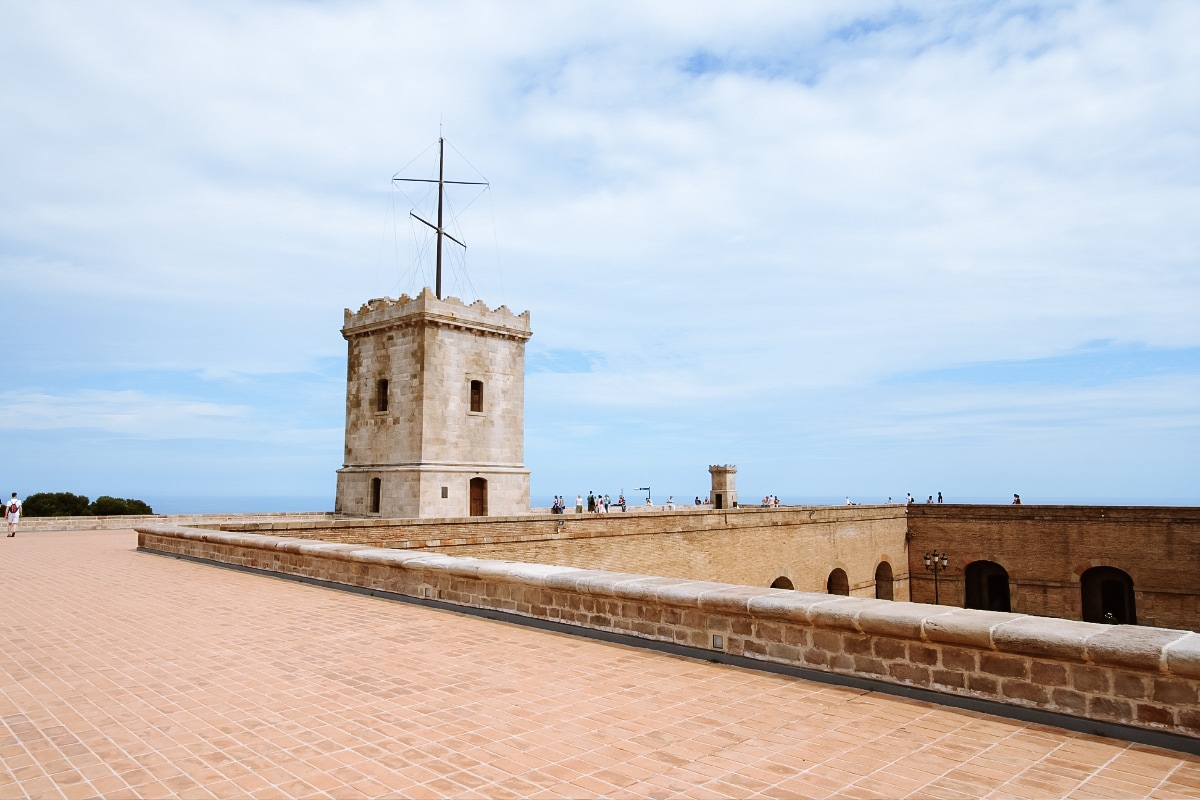
Later it also served as a military prison. Today it houses a military museum and hosts a number of events throughout the year.
- Admission to Montjüic Fortress: full admission €5, reduced admission €3, free for under 16s, first Sunday of the month and every Sunday after 15:00.
- Opening hours: 10:00-20:00
Telefèric de Montjuïc cable car
There is a steeper climb to the castle or you can take bus no. 150 or the Telefèric de Montjuïc cable car . The cable car starts at Parc Montjuïc station and takes you to the fortress. It doesn’t stop upwards, but you can get off at 2 more stops on the way down.
This cable car can be reached from Para-lel metro station (lines L2 and L3). On the metro, follow the green signs to the funicular, where the same fare applies as for other public transport in Barcelona. The funicular takes you to the lower station of the cable car, where you have to buy tickets for a special fare.
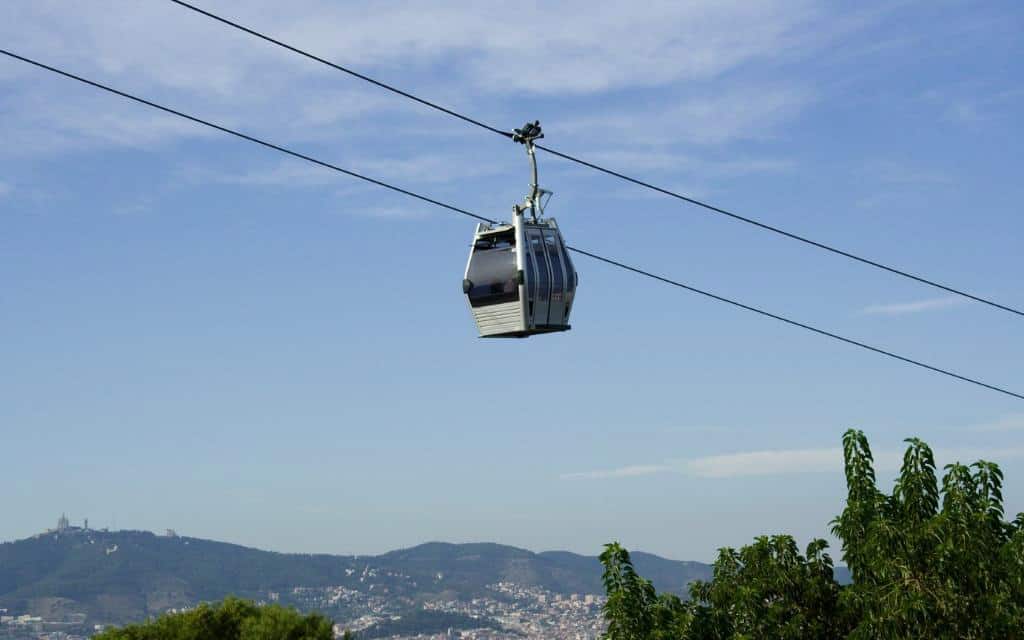
Or you can take a ride on the historic cable car, which won’t help you climb the entire Montjuïc hill, but the views of the city, harbour and sea are amazing. The cable car starts at La Barceloneta and helps to climb part of the hill.
The historic cable car is one of the most popular attractions in Barcelona and there are long queues. Come in the morning or later in the afternoon or enjoy book tickets in advance.
Hotels in Barcelona
- Hotel Acta Voraport – modern and newly furnished hotel with swimming pool, close to the beach and metro
- Motel One Barcelona-Ciutadella – one of the best hotels in Barcelona and at a good price; strategic location near the Arc de Triomphe and Ciutadella Park
- Leonardo Royal Hotel – a stylish hotel with a rooftop pool at an excellent price and with good access to the airport
- Hotel Ronda House – cosy and modern hotel with good quality of service in the city centre
- Hotel ibis Stylesgreat value for money; ideal accommodation for couples and families with children (family rooms and children’s play area)
How to save in Barcelona on entrance fees to the sights?
One way to save money in most major cities is with a tourist card. Even Barcelona has them. The first one is Barcelona Pass which gives you free entry to more than 35 venues in Barcelona. These include Sagrada Familia, Park Güell, Casa Batlló, aquarium, zoo, boat cruise, sightseeing bus and more.
You can buy a Barcelona Pass for a selected number of days or according to the number of attractions. It depends on what you plan to visit, but in our experience and feedback, Barcelona Pass can help you save significantly.
Another tourist card is the Barcelona Card which you can use with older children. Barcelona Card includes free entry to over 25 museums in the city, discounts to other places in Barcelona and unlimited free transport.
For more about the Barcelona Pass and the Barcelona Card, see this article including other tips, how to save in Barcelona.
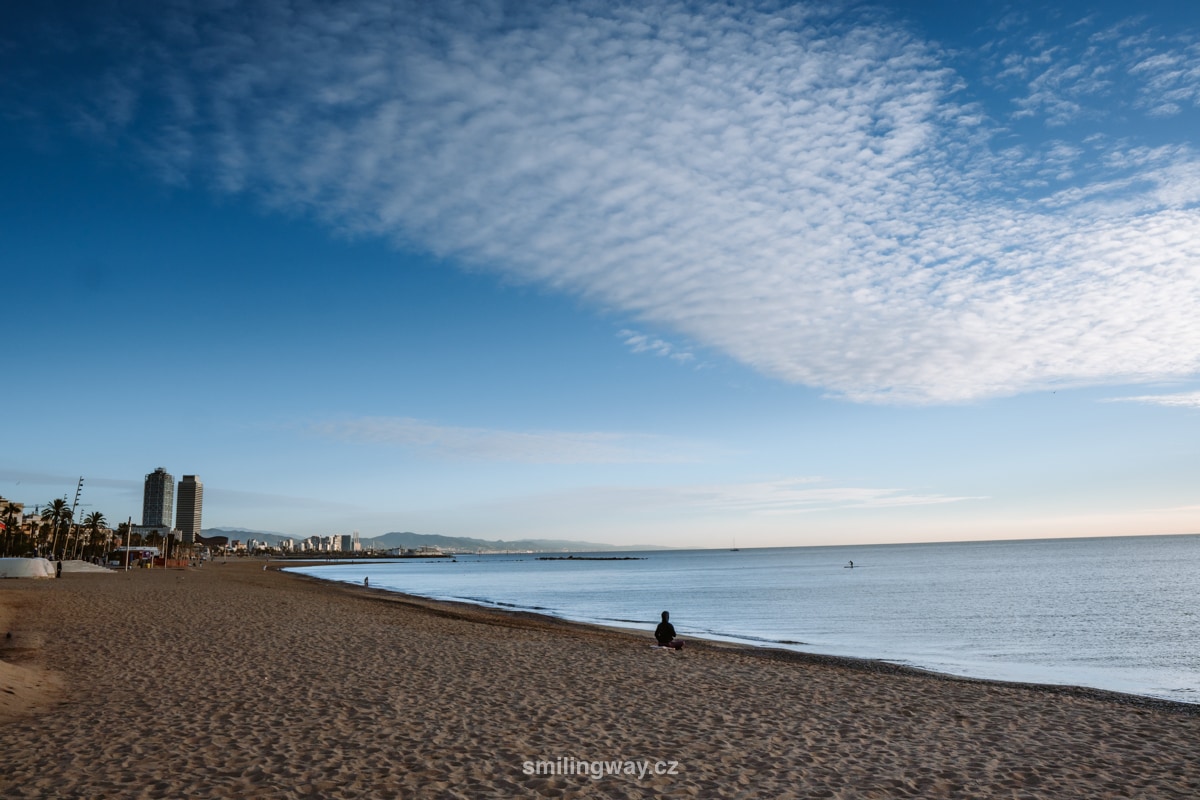
How to enjoy Barcelona for 3 days
- Many places are located in the city centre and are easily accessible. For more distant places, use the metro or buses, and trams along the beaches – transport is safe and reliable.
- Travel unlimited on public transport with the Hola BCN card, which includes the airport metro, buses, trains and ground cable cars.
- Barcelona is big, but part of it is walkable – you’ll discover different neighbourhoods, each with a completely different atmosphere.
- Book your tickets for the most popular things to do in Barcelona early. Barcelona is extremely popular and tickets can sell out or long lines can form on site.
- Watch out for pickpockets – especially on La Rambla, near the Sagrada Familia and other similarly exposed places.
- Grab a paella, seafood or tapas bar. The best places are a bit hidden around the corner and there are lines, but it’s worth it.
- Planning to visit more paid sights, museums and attractions? Get a tourist card – choose from the Barcelona Pass, Barcelona Explorer Pass or Barcelona Card. For more information, see the article on how to save in Barcelona.
Plan your trip quickly and easily. If you buy something through our links, we get a small commission. You pay nothing extra. Thank you!
This was our itinerary to enjoy Barcelona in 3 days. Do you have a question? We’ll be happy to answer it in the comments below. Have a safe journey!
More information about Barcelona
BARCELONA ITINERARY: Check out the description and itinerary map of how to spend 4 days in Barcelona. Here are tips on the best places to visit in Barcelona or things to do in Barcelona for free.
We have also prepared tips on how to visit the Sagrada Familia (attractions, how to avoid queues, entrance fees, etc.). In a separate article, we share tips on what to visit in Barcelona with children.
BARCELONA GUIDE: Here is a detailed guide to transport in Barcelona. We’ve put together tips on the best places to stay in Barcelona (the best areas and hotels). In the next article we share tips on how to save in Barcelona.
Here are the options for getting from Barcelona – El Prat Airport to the city centre.
SPAIN: In our list of the most beautiful places to visit in Spain, we give you tips on what to see in Spain.
